Archived Blog Posts
Common Signs of Mold Growth
6/7/2022 (Permalink)
 SERVPRO of Paulding/Polk counties is ready 24/7 to help you fight mold.
SERVPRO of Paulding/Polk counties is ready 24/7 to help you fight mold.
Dealing with mold growth is something that no home or business owner wants to deal with, but unfortunately, mold can be a persistent thing. Mold spores are always present in the air so there is the threat of them finding a nice spot to land. Thankfully, mold can only grow and expand in conditions that are favorable to its needs.
One of the conditions that mold likes best is areas that are dark without a lot of airflow—and because mold spores are airborne, they can quickly find places that fit the bill. This means that mold often grows in areas that are not readily apparent or accessible, meaning it is important to be aware of the signs of mold growth so you know what to look for.
The Common Indicators That a Building Could Have Mold Growth
Persistent, Dank Odors
One of the most evident (and frustrating) signs of mold is the persistent odor it produces.
Because mold’s main function in nature is to help organic matter decay, the smell it produces is dank and pungent. If you notice a persistent smell in an area that does not go away or worsens with time, it may be an indicator that mold is present somewhere in the area.
Water Damage That Was Improperly Treated
Mold loves areas that are moisture-heavy, which means water damage can often turn into a
mold problem if it is not treated properly. Water damage can soak into drywall, carpet pads and other hidden areas, and if it is not fully and properly addressed, it can lead to hidden mold growth in these unseen areas throughout the home.
Black Spots on Clothing or Fabrics
Mold can often make its home on fabrics, so if you begin noticing that clothes in your closet or upholstery on your furniture begins to attract spots of mold, that might be an indicator that there is a bigger issue elsewhere in the building. Because mold is airborne, it can travel from the main area it has set up for itself and attach to other objects as it tries to spread.
If you have questions about mold or are in need of mold remediation, we are here to help. Get in touch today to learn more about our services!
Fire Safety Tips for the Whole Family
6/7/2022 (Permalink)
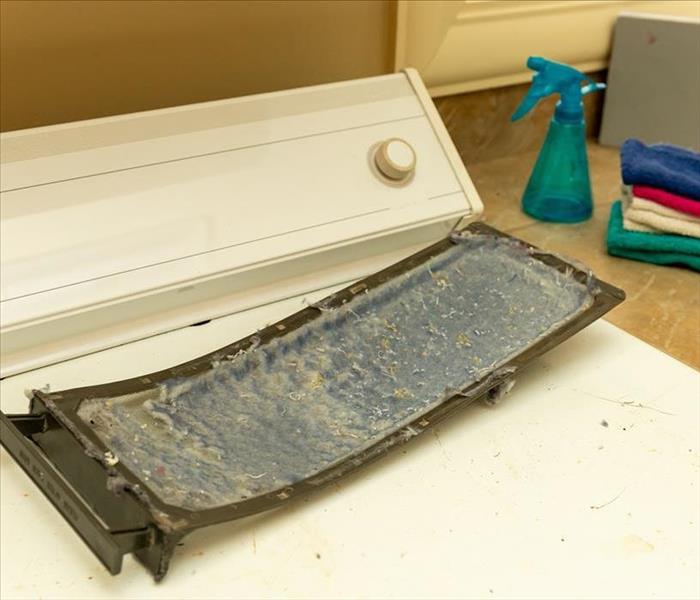 SERVPRO of Paulding/Polk Counties is ready 24 hours a day to help you fight fire damage.
SERVPRO of Paulding/Polk Counties is ready 24 hours a day to help you fight fire damage.
Fire safety is such an important thing for any household. House fires can be dangerous and traumatic, causing significant household damage and putting anyone in the vicinity directly in
harm’s way. Fortunately, fire safety is also a goal that the entire family can get involved with, keeping everyone more invested in safety and more prepared, just in case.
Many fire safety tips are things the entire family can participate in, which makes it a great family activity. Depending on who is in your household, it may be necessary to adjust some of these tips accordingly—for example, toddlers may have a great time drawing escape plans, while older kids may be more suited to smoke detector test duty.
However, we hope these general guidelines are helpful in getting everyone on the same page
for your home’s fire safety.
Fire Safety Tasks for Young Children
**Drawing an escape route.** Escaping quickly is key when it comes to a house fire, so an escape plan is a must. Young children can often be helpful here, drawing lines from each room
to indicate every exit.
**Being accountable for hazards.** Unattended candles, space heaters and cooking food can all be major fire hazards. Oftentimes, young children can make great safety accountability buddies,
calling out these hazards when they notice them.
Fire Safety Tasks for Older Children
**Checking smoke detectors.** Smoke detectors should be tested monthly, which can often be a great chore for preteens and teens in the home.
**Managing fire escape drills.** It is important to have a fire escape plan, and just as important to practice it regularly. Older children can be great at managing these drills, from planning them
out to debriefing as a family in order to see where there may be room for improvement.
**Cleaning out the dryer lint trap.** If your older children do their own laundry, it is important that they understand the importance of cleaning out the dryer lint trap. This is a commonly overlooked fire hazard, but the lint can heat up while the dryer is running and lead to a fire.
*If you have household damage due to a fire, we are here to help. Contact us today to learn more about our fire restoration options or get in touch 24/7 for a rapid response.
Our Commercial Fire Large Loss Restoration Services
6/7/2022 (Permalink)
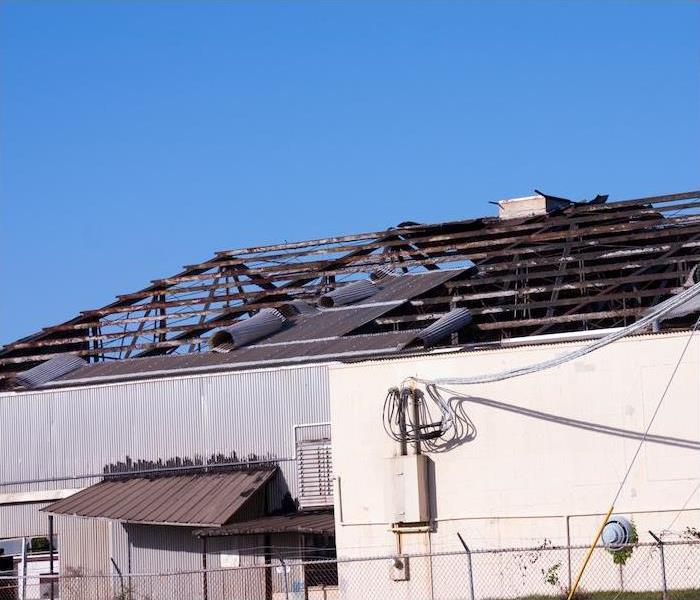 Call SERVPRO of Paulding/Polk Counties to restore your commercial property after a fire has caused a large loss.
Call SERVPRO of Paulding/Polk Counties to restore your commercial property after a fire has caused a large loss.
As a business owner, there are a lot of things to be concerned about when it comes to keeping the doors open. One important element of running a business is having a plan when disaster strikes and strikes hard.
Disasters can come in many sizes, but one that is perhaps one of the most concerning is what is called a “large loss” to your commercial property. A “large loss” is defined as a large scale loss that has a considerable financial impact to your business.
What can SERVPRO do about a large loss for your business?
Emergency Response. We have emergency services on deck 24⁄7 to answer the call for whenever you might need us. We will act immediately to contain the damage and start the repair procedure. We’ve worked with commercial organizations of all kinds for more than 50 years, and we are the experts in cleaning up after large-scale damage and getting businesses just like yours back up and running as fast as possible.
Treating the Damage. Our pros in green consist of licensed experts who have been educated in specialized procedures for removing water and treating smoke damage in your commercial property after a fire. Even if the bulk of your building has been affected, we work diligently to rescue what can be restored and detect issues that may be invisible to the untrained eye. Getting your business back up and running is critical, and we do our best to ensure the work is done correctly and thoroughly while working as quickly as possible. With our knowledge and industry-leading equipment, we’re able to do the most comprehensive job in the shortest amount of time.
When you call on SERVPRO for large-loss restoration services, you can count on consistent communication throughout the duration of the job, the highest-quality products and unmatched customer service. We understand the worry that commercial property damage may cause.
The subsequent difficulties caused by smoke, water from firefighting efforts and structural damage might make your business seem irreparable. You can put your confidence in our technicians, who will work hard to treat the damage, identify any objects that need restoration or replacement, and even coordinate with your insurance provider.
Allow SERVPRO of Paulding/Polk Counties to restore your commercial property after a fire has caused a large loss and interruptions to business. We are on hand 24⁄7, ready to take your call right now.
Storm Preparation Can Save Your Life
6/7/2022 (Permalink)
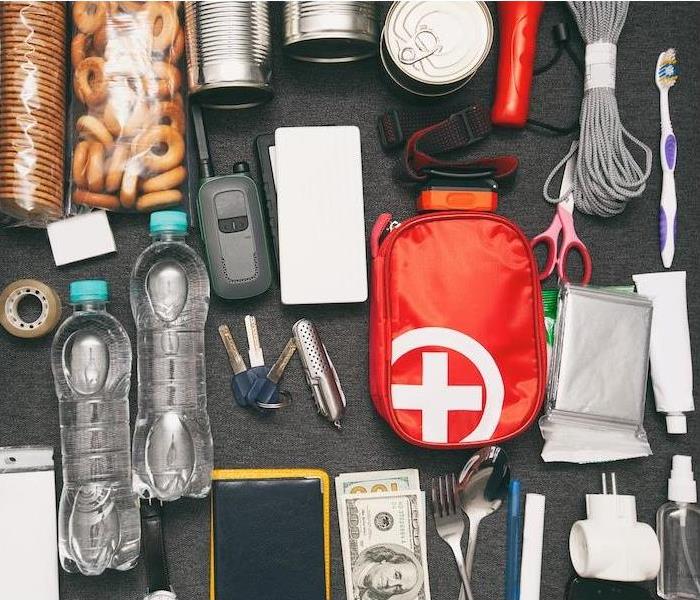 SERVPRO of Paulding/Polk Counties is ready 24/7 to help you prepare for storms.
SERVPRO of Paulding/Polk Counties is ready 24/7 to help you prepare for storms.
When a severe storm warning is issued, you race to prepare, unsure of what to do first to keep you and your family safe. Preparing for storms ahead of time can keep you from having to rush to make a plan.
But with that in mind, 42% of Americans say they do not have an evacuation plan in place. A lack of preparation for an impending storm puts you at risk of the storm’s fatal effects.
Here are a few steps you should take ahead of time to prepare:
Develop a safety plan. The first step in storm preparation is to create a safety plan. Make a household meeting place and, in the event of an evacuation, know where you need to go. Make sure that everyone in your household is aware of any impending weather events and what they can do to stay safe.
Pack an emergency kit. Having an emergency kit on hand ensures that all of the essential items you may need in the event of an emergency or evacuation are all in one place. Items such as emergency food and water, medical supplies, flashlights, and a first-aid kit should be included. Keep your kit in a location where everyone in the house can access it when needed.
Prepare valuable possessions. Flood water can enter your home during severe storms, and if your belongings aren’t in a safe area, they might be ruined by water damage. Passports, birth certificates, family photos and any other items that are too important to lose should be stored in a plastic bag or a waterproof container.
Stay informed. Keep an eye out for local weather alerts to get ahead of any approaching storms. You can stay up to date on current weather events by listening to local radio and television stations. Make sure you understand the difference between a storm warning and a storm watch, as they require distinct preparation measures.
Find a safe place to stay. If you need to shelter in place, stay in your basement or an interior room with no windows. If you feel you need to find a safer place to shelter, you can search for a local mass care shelter to evacuate to. Wherever you find yourself during a storm, be sure to always bring your emergency kit.
When severe storms damage your property, quick action can prevent further damage. SERVPRO is available 24/7 to repair storm damage of any size ASAP
Your Partners in Business
5/17/2022 (Permalink)
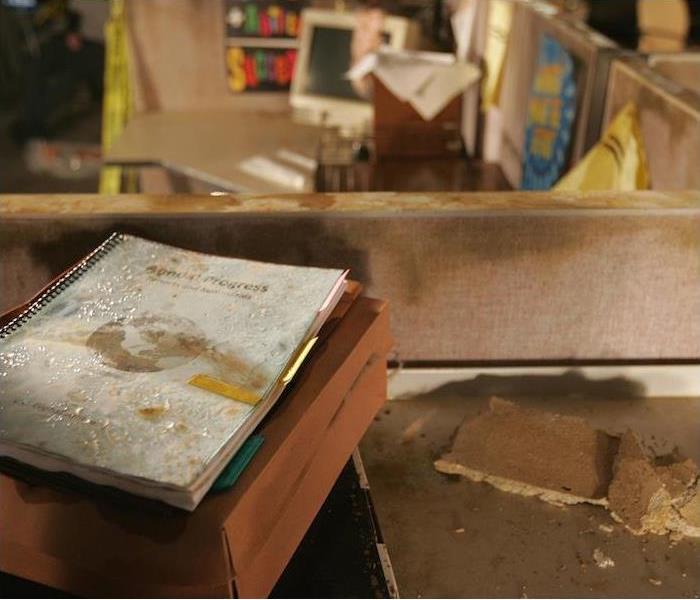 SERVPRO of Paulding/Polk Counties is your local commercial restoration expert. Contact us today should you experience any damage.
SERVPRO of Paulding/Polk Counties is your local commercial restoration expert. Contact us today should you experience any damage.
When running a business, to say that it can be stressful at times is quite an understatement. As a business owner, you know how difficult it can be to have things always run smoothly. Major damages or accidents can cause major losses to a company, and that’s something we want to help you avoid.
That’s why you can count on SERVPRO to become your partner in the business world. We are locally owned and operated, and we will help you work through or recover from anything that can possibly take away from your business. Our goal is to help you and your business continue down the road to success.
Large loss recovery. The top cause of financial loss for businesses across the United States are fires, storms and flooding. These things can and likely will cause large amounts of damage, especially if you wait before dealing with the problem. That’s where SERVPRO can come in with our highly trained professionals to help get you on the road to recovery.
Emergency Ready Plan. Preparation is key, which is why you need to prepare your business before disaster strikes. We will help you create and put the perfect plan into place, so that when disaster comes, you know exactly what to do. There are specific things you should consider when planning, like having an emergency chain of command, alternate meeting or work sites, and how to handle restoration needs.
Cleaning of All Kinds. We can help you with any specialty cleaning needs you have, like biohazard removal,, as well as routine cleaning needs like carpet cleaning or upholstery restoration. No matter what the messy issue is, we will come up with a solution to get it cleaned.
Restoration Services. Whether you’re dealing with storm damage or a small kitchen fire got out of hand, these things require cleanup and restoration services. SERVPRO of Paulding/Polk Counties has all the bases covered, offering comprehensive restoration services for water damage, fire damage and storm damage, among other emergencies.
Industry Specialization. We have spent years learning about commercial enterprises, so we know that we can help anyone. We know the ins and outs of a variety of industries and stand prepared to handle those needs. Because we understand how important your business is, we will often enclose a work area during restoration so that your business operations aren’t disrupted. Whatever your recovery need may be, and whatever your commercial property may require, trust SERVPRO to get the job done. Contact us today to get started on an Emergency Ready Plan or find out how we can serve your business.
How Thorough Should My Business' Severe Weather Plan Be?
5/4/2022 (Permalink)
 If you need assistance creating a Safety Plan for your business, give SERVPRO of Paulding/Polk counties today!
If you need assistance creating a Safety Plan for your business, give SERVPRO of Paulding/Polk counties today!
If you have not yet done so, adding “create a severe weather plan” to your to-do list is a must as a business owner. Not only is an emergency action plan required by OSHA for all employers, but it is also a good idea for everyone involved.
Being prepared can keep you and your staff safer in the event of a severe weather incident, and can encourage everyone to stay calm in what can quickly turn into a chaotic scenario. However, if you are new to emergency action planning, you may be wondering how thorough your severe weather plan should actually be. While it is important to make sure all of your bases are covered, it is also important to remember that weather is unpredictable by nature and your plan should ultimately reflect that.
The Basic Outline of Your Severe Weather Action Plan
**Determine where everyone will go.** In the event of severe weather that strikes while staff is on-site, it is important that everyone stays put until the threat has passed. You will want to determine in advance what the safest area of your building is, as that is where everyone should go when the weather turns sour. Ideally, this will be a room at or below the ground floor of the building that is free from any windows or external-facing walls.
**Determine what everyone will need.** In the event of severe weather, a power outage is extremely likely. That is why it is important to create an emergency kit for your staff, stored in the area you will seek shelter. This kit should include flashlights, batteries, first-aid supplies and anything else to keep everyone comfortable during a power outage. It is also a good idea to include food and water so no one will need to leave the area prematurely.
**Determine your communication plan.** Trying to communicate with employees during a chaotic scenario is less than ideal, so think in advance about how you will keep them updated. Communicate the severe weather protocol in advance, and ensure that everyone knows exactly what to do if there is an imminent threat.
*If your building is damaged by severe weather, you can count on us. Get in touch today to learn more about our restoration process.*
Fire Safety & HVAC Maintenance
4/26/2022 (Permalink)
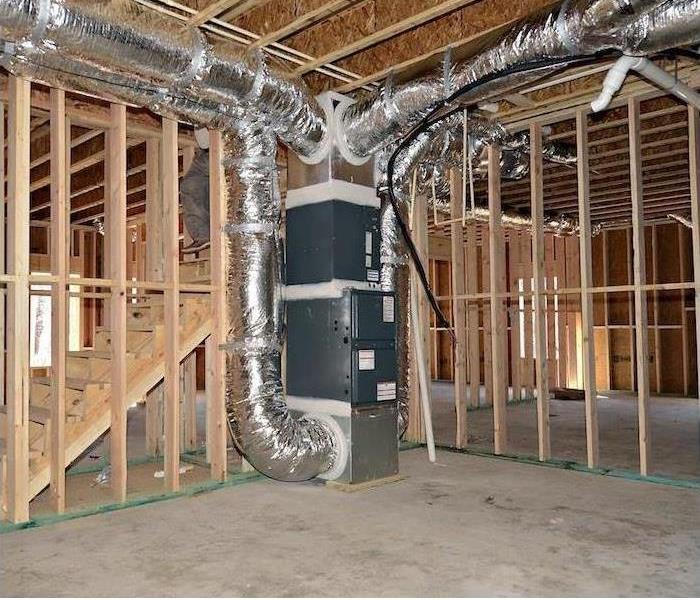 If fire should become a problem, contact the pros in green, SERVPRO of Paulding/Polk
If fire should become a problem, contact the pros in green, SERVPRO of Paulding/Polk
Being a responsible homeowner means taking care of the things that take care of you. Your HVAC system is always there, and there are few (if any) days per year in our area where you aren’t relying on it to keep your home comfortable. It often goes unappreciated—that is, until something goes south or stops working.
There are also some important fire safety concerns of which you need to remain aware, particularly as winter comes in and your HVAC switches to heating mode. Don’t let your source of comfort turn into a source of disaster.
Here’s what you need to do to make sure your HVAC system and furnace are running safely this fall and winter.
Routine Maintenance
Ideally, your HVAC system should be checked twice a year for any present or upcoming issues. A professional can see problems coming and head them off before any danger is presented.
Things like aging or fraying wiring can become fire hazards that are exacerbated by the extended use of HVAC systems during less pleasant times of the year.
Duct System Circulation
Overworked heating systems are dangerous heating systems, and one thing that can quickly cause your system to work too hard is allowing your ductwork to become or remain clogged. Poor circulation or ventilation can cause your furnace to overheat.
It’s recommended that you have your duct work cleaned every three to five years, and we can help with that.
Declutter Your Furnace Area
If your furnace is located in a designated area, or it’s in the corner of a basement or garage, make sure the two-foot radius around it is clear of clutter. Radiating heat (and certainly direct contact) from the furnace can cause flammable materials to ignite. Resist the urge to use your furnace area for storage.
Install Carbon Monoxide Detectors
If your furnace is gas-powered, carbon monoxide detectors can be as important for you as smoke alarms. The gas in your furnace is odorless, and you may not notice a leak until it’s too late. A detector can give you the assurance that things are running smoothly.
In addition to your regular fall maintenance, make sure to have your heating unit examined to give yourself a comfortable, fire-safe fall and winter season.
If fire should become a problem at home, we can help you with restoration and recovery. Contact SERVPRO to get the pros in green working for you right away.
SERPVRO assists with large commercial loss
4/21/2022 (Permalink)
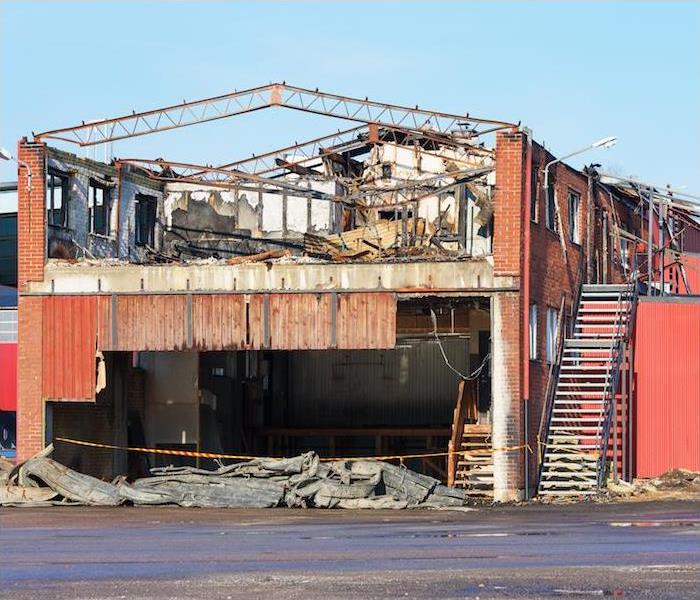 If your company encounters any damage to your property, call the experts at SERVPRO of Paulding/Polk Counties.
If your company encounters any damage to your property, call the experts at SERVPRO of Paulding/Polk Counties.
Floods, fires, blizzards and other extreme weather disasters or workplace incidents may cause enormous damage to warehouses, offices, retail shops and other commercial structures.
Flooding and fire disasters are two of the most common causes of severe economic losses.
COMMERCIAL WATER DAMAGE. Commercial water damage from flooding or other events can be devastating and costly. According to the U.S. government, the average commercial flood claim in the past five years has been around $89,000. Flooding may cause major damage to flooring, building material and drywall, putting the structure at danger. Furthermore, valuable and essential machinery and electronics may be damaged.
When you call SERVPRO, we will arrive as soon as possible to begin removing flood water and prevent it from spreading and creating further damage and difficulties.
SERVPRO professionals are highly trained and prepared to remove huge amounts of standing water and excess moisture from commercial buildings. We can also dry and repair construction materials, documents and electronics that have been damaged.
Our skilled water removal equipment can remove large amounts of standing water, while our cutting-edge drying equipment can remove excess moisture from any afflicted areas of the property. We can restore any of your essential devices (computers, TVs, monitors and so on) and assist in the recovery of lost data if they are damaged. We may also provide comprehensive restoration services if any structural aspects of your building are affected.
COMMERCIAL FIRE DAMAGE. Another disastrous catastrophe that might happen in a business environment is a fire. When they occur, they usually spread swiftly and do significant damage to the property and its contents.
Because damages are caused not only by the fire itself, but also by soot, smoke, firefighting attempts and other byproducts, there is more to clean and restore than the building itself.
We clean up and repair all affected areas after a fire through highly specialized solutions. As well as repairing any structural damage caused by the fire, we can also repair items that have been harmed by soot, smoke or water damage from firefighting efforts as much as possible.
While fires and floods are two of the most prevalent calamities that companies and organizations encounter on their property, there are still a plethora of other large loss events that we can handle. If you are a company owner who has encountered a damaging incident on your property, call SERVPRO of Paulding/Polk counties and we’ll respond to your emergency immediately.
Why You Should Trust SERVPRO with Your Fire Damage Recovery
4/21/2022 (Permalink)
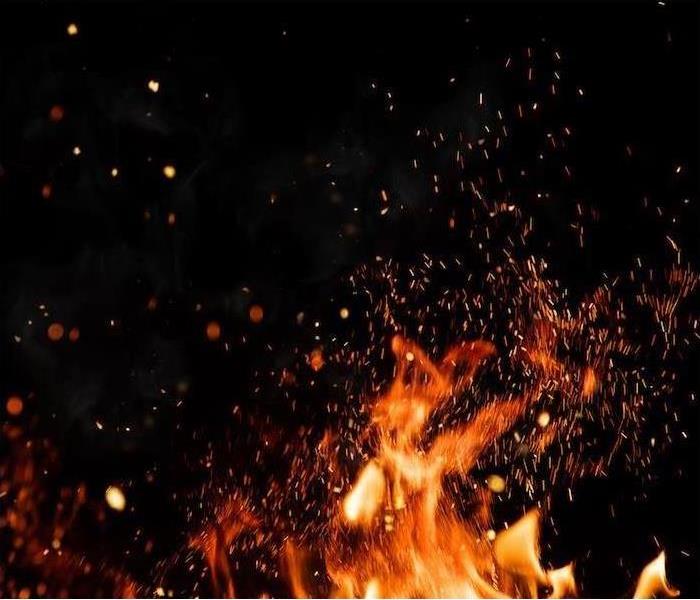 SERVPRO of Paulding/Polk is your local fire restoration expert. No job is too big for our team of experts.
SERVPRO of Paulding/Polk is your local fire restoration expert. No job is too big for our team of experts.
Dealing with a fire is one of the most taxing things a homeowner could possibly imagine.
Fire causes all kinds of damage in your home, and recovering from a home fire encompasses dealing with physical, financial, emotional and mental recovery.
While SERVPRO of Paulding/Polk can’t help with all these areas, we can be your main source of property recovery and restoration. And we can get your home taken care of quickly, which can in turn aid in your emotional recovery as well.
Here’s why you know you can feel good about entrusting your fire recovery to us.
We’re Established.
We’ve been doing this a very long time. SERVPRO was established the same year Thurgood Marshall was appointed to the Supreme Court, if that gives you any idea.
That means we’ve got over 50 years’ experience helping families and homeowners deal with the effects of fire, and we’ll use all those years of innovation and experience to give you the most complete recovery possible.
We’re Skilled.
SERVPRO of Paulding/Polk employs a team of experts, trained and equipped to handle anything fire may have done to your home. From reversing the effects of smoke damage to full-blown rebuilding efforts, we have the tools and work ethic to get it done.
We’re always up to date on the latest technologies, innovations and certifications, which multiplies our capacity for tackling even the toughest recovery projects.
We’re Very Fast.
When you click this link or call (770)-505-0555 you’re getting connected with a local team who can be onsite right away to get started.
You don’t have to wait for a team from somewhere else to mosey up to Dallas or Hiram—no, we’re right here in Dallas which means when you need us, we’re the quickest option for your recovery. And we’re on call 24 hours a day, seven days a week to take your emergency call.
When fire strikes at home, the choice is clear: SERVPRO of Paulding/Polk Counties is the name you can trust with your recovery and restoration.
If fire or other disasters do damage to your home, we’re here to make things right again. Contact us today to get fast, local recovery started on your property right away.
The Sights, Smells, and Sounds of Water Damage
4/19/2022 (Permalink)
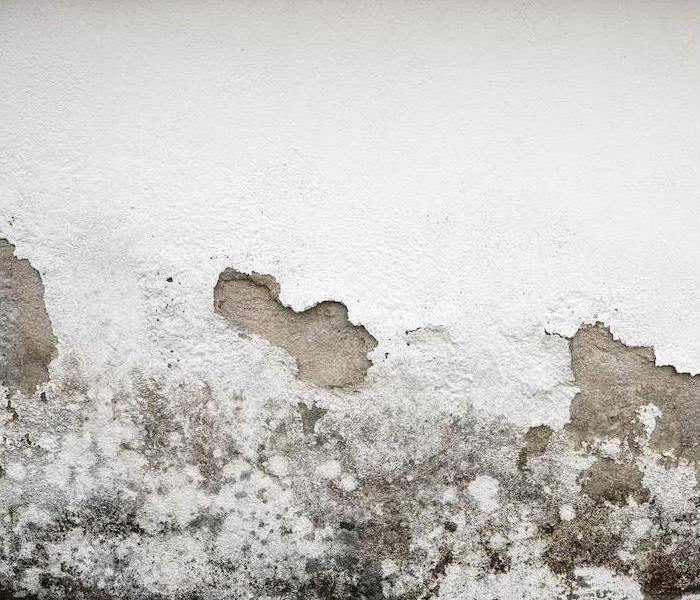 ?If you suspect water damage in your home, call SERVPRO 24 hours a day.
?If you suspect water damage in your home, call SERVPRO 24 hours a day.
Water damage can hide for a little while before revealing itself in your home, but it can only hide for so long. Depending on the type and location, it may be a matter of a few minutes, hours or days before you notice something’s going on, but eventually the water will collect itself somewhere or affect something you can’t help but notice.
Let’s look at the most common ways you can catch a leak in the act, and hopefully put a stop to it before it becomes a full-blown problem.
Spots. They call those fraud protection overlay images “watermarks” for a reason. One of the absolute telltale signs of water damage is noticing dark or wet spots on your ceiling or walls, both indicative of a leak from above. These can let you know there’s a problem on the roof or in the attic, or something happening with a pipe inside the wall.
Paint or drywall that flakes or bubbles. Paint can’t cover a water leak for long—eventually it will show in the form of cracking, bubbling or flaking. And drywall will expand, crack or otherwise fluff up as it becomes damp. (It will also weaken significantly.)
Puddles and pooling water. You clean up a puddle in the floor or under a cabinet, or you dry a wet spot in the carpet, only for it to come back. Uh oh. There’s something under there causing water to pool up and seep through.
Running water sounds. Like we said, water leaks can hide for a while before they become visible. But a keen ear in a quiet moment might help you catch something going on. Be on the listen-out for the sound of running water inside the walls when no plumbing is in use. You should also heed sounds like bubbling, gurgling or whistling from your water heater or plumbing in general.
Moldy smell. A musty, pungent odor can be a dead giveaway that moisture has gotten out of control or that water damage is evident in a basement or bathroom. If you catch that signature smell, mold is already growing and you need to take action.
Your utility bill. If your home doesn’t tell you about hidden water leaks, your utility bill may. If you notice an uptick without explanation, it could indicate a hidden leak—for example, a puncture or root invasion in an underground pipe that could lead to serious foundation problems.
If leaks lead to water damage, you’ve got a friend in the restoration community. Call SERVPRO to get yourself safely back in the dry.
What Is Your Business’ Storm Readiness Plan?
4/13/2022 (Permalink)
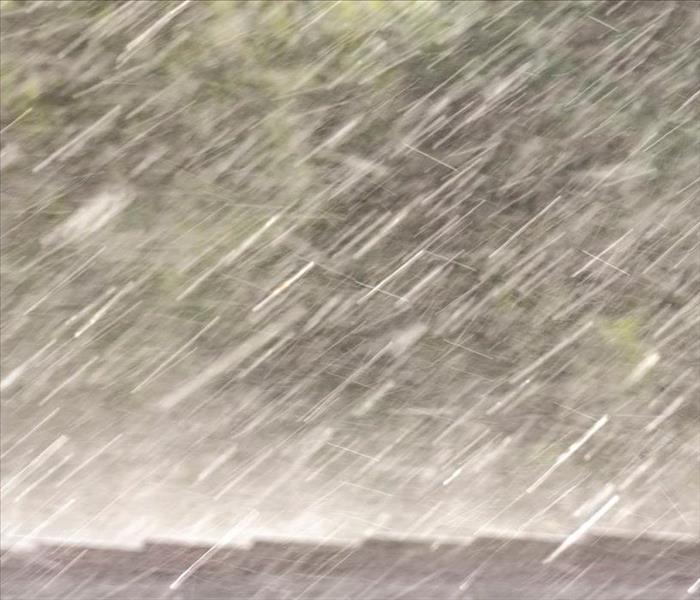 If you need help getting your business prepared for a storm, call SERVPRO of Paulding/Polk Counties today!
If you need help getting your business prepared for a storm, call SERVPRO of Paulding/Polk Counties today!
A severe storm is an unpredictable thing—with atmospheric uncertainty and ever-changing conditions, the timeline and severity of a storm can often be in question until the moment it moves into an area.
However, this uncertainty is not an excuse to not be prepared. In fact, it is all the more reason for business owners to put a plan into place. Not only does OSHA require all employers to draft a written emergency action plan to comply with their standards, but it is also a good idea from a practicality standpoint. Below, we will take a look at some key elements of your storm readiness plan to include so you can keep yourself and your employees as safe as possible should the weather turn dangerous.
What Do I Do for My Business’ Storm Readiness Plan?
**Create an emergency kit in case weather strikes on the job.** Unfortunately, storms never adhere to a convenient schedule, meaning the odds are high that one may strike while everyone is actively in the office. If this is the case, keeping everyone safe and comfortable is top priority while you wait for the storm to pass. An office emergency kit, which should include food, water, flashlights and a weather radio at minimum, will keep everyone comfortable should the power go out and require you to stay put until the threat is over.
**Communicate with your employees.** Trying to communicate instructions and convey new information in a stressful scenario is never ideal, so take this opportunity to communicate with your employees in advance so they are aware of the severe weather protocol. Let them know what your plan is, where they should seek shelter in bad weather and what to expect in an emergency scenario.
**Protect your business’ data.** Because most things are digital now, rain can be quite dangerous to business data. Be sure that your data is backed up, either on an external hard drive or in the cloud, so it can be retrieved even if key computers get water damage due to severe weather.
*If your business sustains damage due to a storm, we are the team to call. Get in touch with us today to learn more about how we can help.*
The 411 on Commercial Water Damage Prevention
4/11/2022 (Permalink)
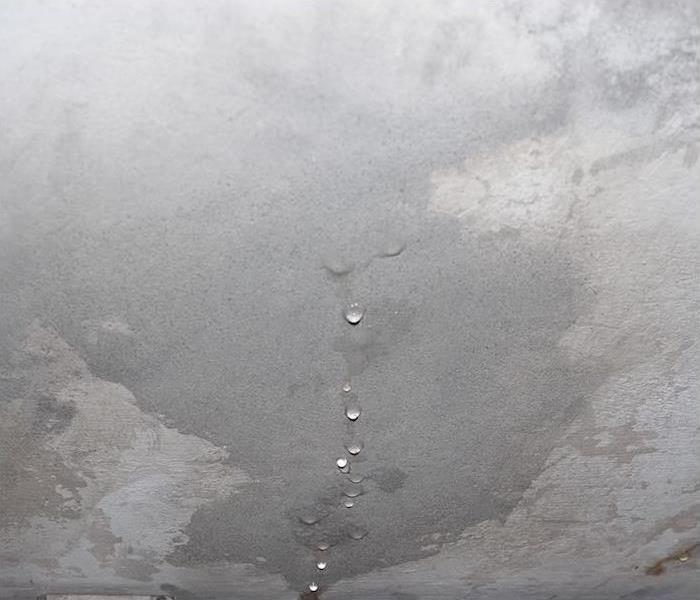 If your business is affected by water damage, reach out to your local restoration expert SERVPRO of Paulding/Polk Counties.
If your business is affected by water damage, reach out to your local restoration expert SERVPRO of Paulding/Polk Counties.
Water damage is often unanticipated and comes in all shapes and sizes, whether it is caused by a flash flood, a burst pipe or a leaky roof. No matter if it is pooling water in your ceiling that can go unnoticed or you’re standing in water up to your knees, water damage can cause significant untimely and costly interruptions to your operations.
In many circumstances, however, preventive measures can be taken to avert severe delays or property damage. The following are a few recommendations to inspect and prepare you in protecting your facility from water damage:
Check for plumbing issues. One indicator of plumping issues could be if you’ve observed a substantial increase in your water bill, a pipe or plumbing equipment is almost certainly to fault. You can check your walls, floors and ceilings for indications of leaks. Discoloration or mildew development is also a reliable indicator that a pipe is damaged or leaking. Whatever you discover, be certain to get it repaired as quickly as possible.
Install a water-sensing device. You can find water sensors available at practically any home improvement store. The devices provide alerts or alarms in the case of a water leak, allowing you to contain the damage and respond quickly. The majority of sensors may be connected to your smartphone or integrated with your facility’s security system, enabling you to get alerts even while you’re not on-site.
Look at the windows and doors. Water making its way indoors from outside during storms or rain is another frequent cause of water damage. Examine the area surrounding your windows, doors and any other exposed locations. Be sure to reseal any gaps or cracks using caulking that is waterproof. Additionally, refinish window or door trim to provide additional protection against decaying seals and trimming.
Regularly inspect the roof. Have an expert inspect your roof to discover places that might leak. Different types of roofing may need different treatments such as sealing on a regular basis to provide an additional layer of protection. Additionally, remember to clean the gutters to ensure that rainfall flows easily away from the roof. Take note of locations that are prone to drainage problems. Along the outside your building, be sure to look for spots that may be prone to water accumulation if the ground gets too wet. Consider getting the help of a landscaper or drainage specialist to do an inspection of the area and provide proper draining.
If your business is affected by water damage, enlist the help your local experts at SERVPRO of Paulding/Polk. We are here to help 24⁄7 whenever disaster might strike.
Do You Have a Plan for Staff Safety in Severe Weather?
4/8/2022 (Permalink)
 Do you have a Plan for Severe Weather? Reach out to SERVPRO of Paulding/Polk Counties today!
Do you have a Plan for Severe Weather? Reach out to SERVPRO of Paulding/Polk Counties today!
Severe weather can be an extremely dangerous thing. Not only is it often unpredictable, but it is also quick-moving—meaning waiting to prepare when it becomes imminent can put you in harm’s way.
If you are a business owner, preparing in advance is even more important, as it will help you keep both yourself and your staff safer in the event of weather concerns.
If you have not yet put together a plan for severe weather, now would be the time to do so. Not only is it a requirement from OSHA that you have an emergency action plan in place, but it is also a smart way to keep everyone calm and comfortable even when the weather goes south. There are a lot of key elements in emergency planning, but below, we will focus specifically on some things to consider to keep your staff safe.
How to Keep Your Staff Safe During Severe Weather
**Make planning a collaborative process.** Having an emergency action plan is great, but it does not do much good for your organization if no one is aware of what the plan is. Make sure you include your staff in the planning process and keep them aware of what protocols to follow should severe weather become imminent.
**Make sure everyone’s needs are accounted for.** It is a good idea to pack a general emergency kit for your workplace to cover things like flashlights, first-aid supplies and general items to keep everyone comfortable in the event of a power outage. However, you should also encourage staff to have their own personal emergency kits that meet their needs—that way, if there is an emergency scenario, they will have access to necessities such as medication and personal items.
**Make it clear where everyone should go.** In the event of a severe weather event, you and your staff will need to seek shelter on-site until the threat passes. Be sure you have a safe area clearly identified so staff know exactly where to go. This area should not have any windows or external-facing walls, and ideally will be at or below the building’s ground floor.
*If your building has damage due to severe weather, we are the team to call! Contact us today to learn more about our storm restoration practices.*
Tips For Recovering After a House Fire
4/6/2022 (Permalink)
 House fires trend to peak during the winter. SERVPRO of Paulding/Polk counties is available 24/7 in the event of an emergency.
House fires trend to peak during the winter. SERVPRO of Paulding/Polk counties is available 24/7 in the event of an emergency.
No one likes to think about suffering a loss like a house fire, but it’s a reality for millions of American families every year. House fires aren’t a seasonal risk to your home, but they do happen more frequently during the winter months.
If your family suffers a house fire, even one that does extensive damage, you can take steps to recover what you can from your home and recover emotionally, too. These tips can help you start the restoration process and help you deal with the aftermath of a house fire.
Taking the First Steps
The American Red Cross offers the following tips to help you in the immediate aftermath of a house fire.
After you’ve gotten everyone out of the house and treatment for any injured people or pets, then these are your next steps:
Let your loved ones know you’re safe. This is an important step, especially when news of a fire or issue can spread quickly.
Don’t go back into your home until it’s secured. The authorities will let you know when it’s safe to go back to your house. Please don’t go in there before because it can be unsafe.
Get in touch with your insurance company. You’ll want to let them know what happens to get the restoration process started.
Tips for Dealing With Emotions
It’s normal to feel a wide range of emotions after your home suffers a fire. They can range from grief to anger to depression. The American Psychological Association offers this advice to help you begin the process of recovering emotionally.
Find ways to reduce your stress. That can include exercise, meditation and deep breathing.
Don’t make major life decisions. It’s smart to avoid switching jobs or making other major choices while dealing with these complicated emotions.
Talk about your feelings. Whether you choose a therapist, family members or a close friend, it’s smart to talk to someone about what’s going on.
Don’t set expectations. There is no way you “should” be dealing with these issues. Instead, do what you can and be kind to yourself.
Take good care of yourself. Eat balanced meals and get plenty of sleep. It will help you better deal with a stressful situation.
If your home is damaged due to a fire or any other cause, you can always count on us for restoration assistance. We have crews who are available 24⁄7 in the event of an emergency. Contact us at any time to learn more about our restoration services and how we can help.
Potential Spring Weather Hazards Across The Country and Close to Home
4/4/2022 (Permalink)
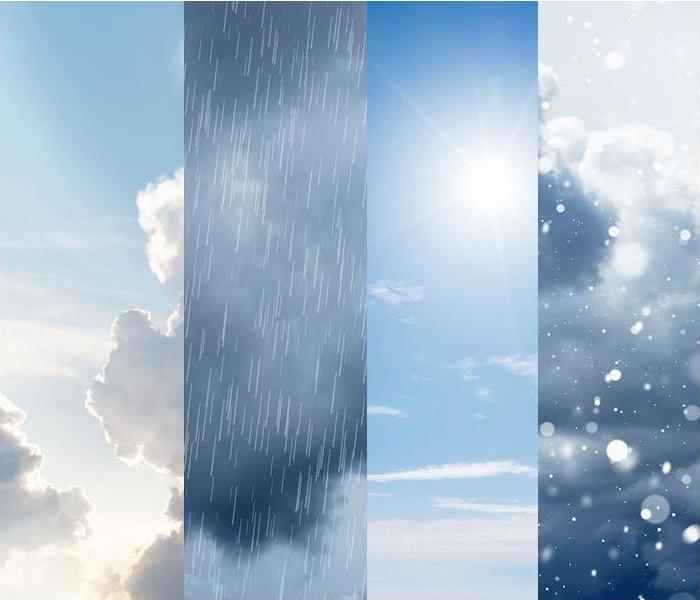 Extreme temperature changes can lead to the possibility of severe weather. SERVPRO of Paulding/Polk counties is a click away if you need help.
Extreme temperature changes can lead to the possibility of severe weather. SERVPRO of Paulding/Polk counties is a click away if you need help.
The United States is the third largest nation in the world, coming in behind Russia and Canada based on land mass.
When you have such a large geographical area encompassed in one country, “spring weather” season can have a much different meaning depending on where you are. There are all types of different weather events, which means there will also be different weather threats.
With spring right around the corner, read on for a look at what different parts of the country can expect, weather-wise.
First, let’s take a look at the Pacific Northwest region. The residents here experience heavy rainfalls during the spring months, causing flooding and water damage. There are areas with high elevations that may be dealing with a different type of wet weather—remnants of snow or ice melting, which cause problems of their own.
Now looking at the Upper Midwest and Northeast regions, these regions basically don’t know the difference between winter and spring! This region experiences winter weather to the fullest, dealing with snowstorms and blizzards all the way until early summer at times.
Then you have people living on the West Coast who don’t even know what winter weather is, as it’s almost non-existent in this area. Rather than blizzards or snow, they are dealing with excessive heat waves. These heat waves can endanger the lives of those living in the area, and they also contribute to wildfire conditions.
When you get to the middle part of the United States, you will notice that from Iowa to Texas they are dealing with dry, windy weather! Things like wildfires, windstorms and derechos are just a few of the weather hazards this area faces during spring. Not to mention an area that is named “Tornado Alley” is in this region as well.
Then you have the Southeast region, where we are located. We see spring as a wonderful time of the year; however, we do experience our fair share of weather hazards. Intense thunderstorms and even tornadoes are common this time of year. And states that border the ocean also have to look out for rip currents and early-season hurricanes.
So, what’s the point here? No matter what “spring weather” looks like in your neck of the woods, there are always weather hazards! That’s why despite of where you live, you will need to be prepared for any kind of weather event.
If extreme weather leaves you with damage from water, fire or other elements, help is a click away. Contact SERVPRO for fast, expert recovery.
Understanding Fire Sprinkler System Requirements for Commercial Spaces
4/3/2022 (Permalink)
 If your business is damaged from a fire, trust the experts at SERVPRO of Paulding/Polk to make it "Like it never even happened."
If your business is damaged from a fire, trust the experts at SERVPRO of Paulding/Polk to make it "Like it never even happened."
If you own a business or other type of commercial space, fire safety is extremely important. Not only is adhering to fire codes a must to allow for your continued operation, but it is also key that you do everything you can to protect your staff and your customers who are working and doing business inside the space.
Preparations can also reduce the impact of a fire, and given that over half of businesses are not able to recover after a fire emergency, doing what you can to reduce a fire’s impact is a prudent move.
One vital element of safety and harm reduction is a fire sprinkler system. While fire sprinklers are not *always* required in commercial buildings, they are more often than they are not—and even if they are not required in your specific situation, it is likely worth having them installed given that sprinklers are effective in stopping 88% of commercial fires when they are installed.
How Do I Know if I Need Fire Sprinklers in My Commercial Space?
While every area will have local fire codes for businesses that may vary, some of the national guidelines are included below:
* Fire sprinklers must be installed in any new commercial building exceeding 5,000 square feet, or any building that is renovated to contain 5,000 square feet after construction.
* Buildings more than 55 feet in height must have fire sprinklers on every floor.
* Self storage buildings must have fire sprinklers installed, except in single story facilities with no indoor corridors.
* If the municipal water pressure to the building is not adequate to pressurize the sprinkler systems, a fire pump should also be installed.
If you are unsure about whether you need a sprinkler system in your commercial space, or you have questions about the system you have, your local fire department will likely be able to connect you with the right person to make an assessment. In addition to installing fire sprinklers, they can help you determine if your fire escape routes, fire exits and fire extinguishers are up to code as well.
If your business is damaged from a fire, we can help. Contact us today to learn more about our commercial restoration services for businesses impacted by fires, floods and more.
SERVPRO's Process for Fire Restoration
4/2/2022 (Permalink)
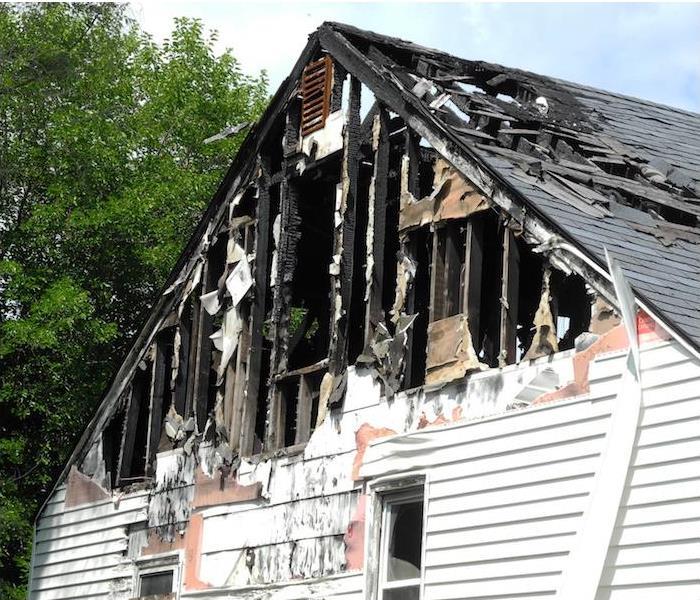 When your home or business endures fire damage, you can count on SERVPRO of Paulding/Polk from start to finish.
When your home or business endures fire damage, you can count on SERVPRO of Paulding/Polk from start to finish.
After a fire strikes your home or business, you’re left with damage from the fire as well as water saturating everything from the firefighting efforts. None of that would be a surprise to our experts here at SERVPRO, as we have the specialized fire restoration expertise to return your house to its pre-fire state.
Every fire damage situation is unique and necessitates a unique remedy, but the overall procedure remains the same. The following is how we will handle a “normal” fire damage situation.
Initial contact. We are on call 24 hours a day and seven days a week, including all holidays. Disaster doesn’t wait for office hours to strike, and we don’t wait to respond. When you contact us, the restoration procedure starts. Our experts will ask a number of questions about the fire damage so that we can get started immediately with the necessary equipment and resources.
Inspection. To establish the degree of the fire, water, smoke and soot damage, we will thoroughly check and test every room. By doing this, we are able to formulate the proper strategy. Fires can cause the air quality to be unsafe, so it’s important not to re-enter the property until experts have determined it is safe to do so.
Water removal. If there is water damage present as a result of firefighting efforts or sprinkler systems, we will begin the water removal procedure immediately to ensure the bulk of the water is removed. If there is any remaining water, it will be removed using dehumidifiers and fans, and the drying process will begin from there.
Cleaning. SERVPRO removes smoke and soot from ceilings, walls and other surfaces using highly specialized state-of-the-art equipment and processes. We’ll clean up all of the fire-damaged items and areas that can be cleaned and repaired. We will also work to return your possessions to their pre-fire state by applying a number of cleaning processes. We can clean and restore electronics, documents, upholstery and more. We also specialize in industrial air scrubbers and fogging equipment to eliminate odors.
Restoration. If during the cleaning process we determine that certain areas of your property cannot be cleaned, we also provide comprehensive restoration and rebuilding services. Restoration and rebuilding efforts include everything from modest repairs like drywall replacement, painting or carpet installation to substantial repairs like the complete rebuilding of different areas or rooms in your home or property.
When your home or business endures fire damage, you can trust that SERVPRO of Paulding/Polk Counties will be ready to be a helping hand and will get your home restored quickly and thoroughly to its pre-fire condition.
Tornadoes 101
3/31/2022 (Permalink)
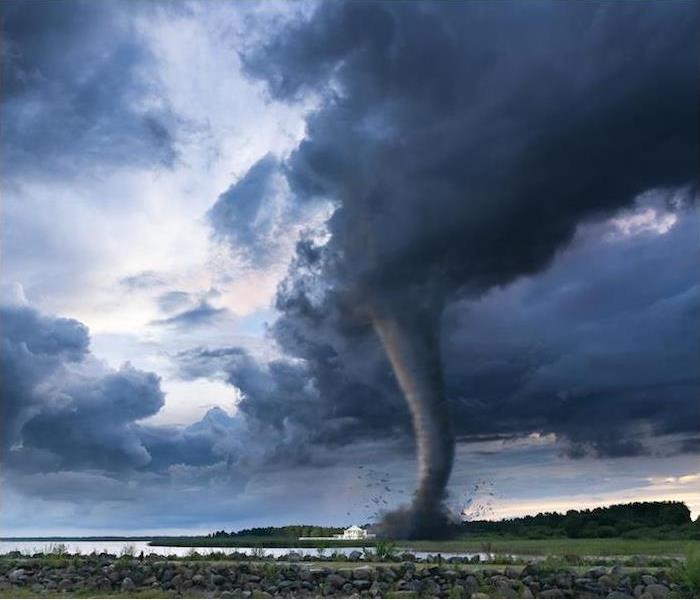 Spring storms can cause major damage to your property. If you experience any damage reach out to SERVPRO of Paulding/Polk Counties.
Spring storms can cause major damage to your property. If you experience any damage reach out to SERVPRO of Paulding/Polk Counties.
Georgia is prone to severe weather of all types but is particularly prone to thunderstorms and tornadoes. All of Georgia is prone to tornadoes throughout the whole year, but they are most likely to occur from March through May and peaking in April.
When there is severe weather, be sure to keep a close eye on how the weather changes and know how to identify tornadoes. Tornadoes are often accompanied by thunderstorms and can develop quickly, so it’s important to have dependable ways to get updates about storms by turning on your radio or TV, or by having notifications on your phone for weather alerts.
A tornado watch means that there hasn’t been a tornado sighting yet, but the weather is favorable for them to happen.
Once a tornado watch is issued, it’s important to stay notified through the tornado warning system in your area, stay tuned to local radio stations or an NOAA radio or have notifications on your mobile device for weather updates.
Most tornado-prone areas have an outdoor siren system. Know how to distinguish between the siren’s warnings for a tornado watch and a tornado warning.
A tornado warning is sent out as soon as a tornado has been spotted or shown on the weather radar. You should seek shelter as soon as a tornado is on the way.
Some tornadoes come quickly and without warning, so it is important to know what to look for. Signs that a tornado may be approaching include:
- A rotating funnel-shaped cloud
- Dark or green-colored sky
- Large, dark, low-lying cloud
- Hail
- Loud roar that can be compared to a train
If a tornado is heading your direction, it’s important to take shelter immediately in the lowest indoor area of whatever building you are in, away from windows. The best places to go are basements and cellars, but hallways or other windowless, centrally located areas are good, too.
If you are outdoors, find a place to take shelter, but if that is not possible, find a ditch and lay face down, covering the back of your head and neck with your hands.
Tornadoes and other severe storms can cause serious damage to your property. If your property is damaged by a storm in any way, SERVPRO of Paulding/Polk Counties has you covered. We are available 24 hours a day and seven days a week so we can begin the restoration process immediately.
A Guide to Fire Code Considerations for Your Commercial Space
3/30/2022 (Permalink)
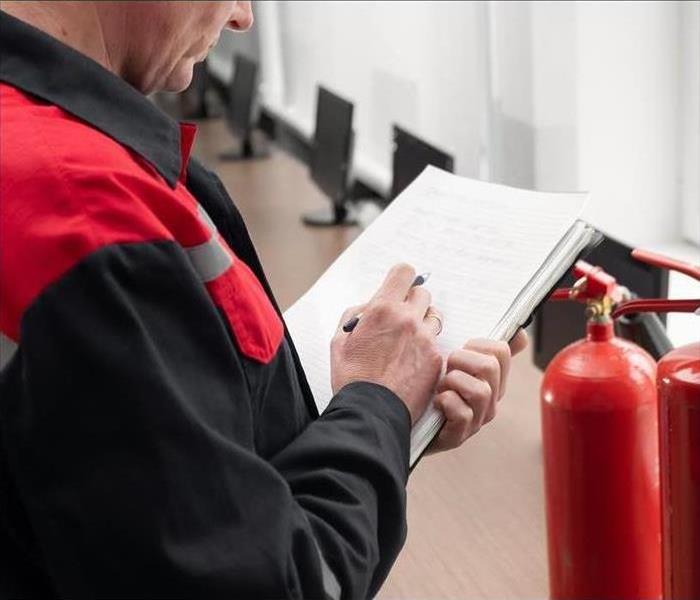 If your business needs help with fire damage, you can count on SERVPRO of Paulding/Polk counties 24/7/365.
If your business needs help with fire damage, you can count on SERVPRO of Paulding/Polk counties 24/7/365.
If you own or operate a business or other commercial space, understanding how to protect your investment and your employees from harm related to fire damage is a must. Not only are fires extremely dangerous for anyone who is in the area, but they can also be devastating to businesses—it is estimated that over half of businesses are unable to recover from a fire.
Fortunately, businesses are able to take many precautions when it comes to fire prevention, and national commercial fire codes are a great place to start. While each area will have their own local codes that should also be followed, below, we will examine some of the national codes that can help you keep your business safe and operational.
Fire Codes Pertaining to Commercial Sprinkler Systems
While they are not required in all types of commercial buildings, a commercial fire sprinkler system can be a fantastic way to reduce the risk of a fire severely impacting your business. Typically, the rules for fire sprinkler systems are that they must be installed in any commercial building over 5,000 square feet and any building that is taller than 55 feet in height.
Fire Codes Pertaining to Fire Alarms
While smaller commercial spaces are not always required to have a fire alarm system, installing them is a simple enough process that it is always a good idea. By alerting people to the fire quickly, your employees and customers will have more time to escape, which could potentially save a life. If possible, it is best to invest in interconnected fire alarms, so that when one is triggered, they will all sound to alert everyone in the area.
Fire Codes Pertaining to Fire Extinguishers
All businesses are required to have fire extinguishers on the premises, but how many and where they should be located varies based on the size and nature of the commercial space in question. Additionally, business owners are required to have fire extinguisher training with all employees at least once per year to be certain that everyone is aware of how to use a fire extinguisher and comfortable with the best practices.
If your business needs help with fire damage, you can count on us. We are here 24 hours a day to help you recover in the aftermath of a commercial fire. Contact us today to learn more.
Keeping Track of Fire Safety at Your Business
3/25/2022 (Permalink)
 If you are dealing with the aftermath of a fire at your business, you can depend on SERVPRO of Paulding/Polk Counties
If you are dealing with the aftermath of a fire at your business, you can depend on SERVPRO of Paulding/Polk Counties
For business owners, there are few things more important for the safety of you and your staff than ensuring you have the right fire protections in place. Fires can be absolutely devastating for businesses, with over half never being able to recover after the damage—but fortunately, there are plenty of ways to decrease the likelihood that you will ever experience a fire at all.
All businesses are subjected to certain fire codes set forth by the National Fire Protection Association, which provide a great guideline for making sure you are being as safe as possible. In addition to adhering to fire codes when you are first starting out, it is also important to make sure you are regularly auditing your fire safety efforts to be sure nothing slips through the cracks. Below, we have listed out some helpful tips for doing just that.
Keeping Track of Your Fire Prevention Efforts in the Workplace
Make sure you have enough (working) fire extinguishers. It is required that all commercial spaces have fire extinguishers on the premises, though how many and where they are located will vary depending on your specific situation. That being said, it is important to check your fire extinguishers regularly—while they do have a long shelf life, there will be an indicator on each one that will let you know if it is time to be replaced.
Check or install commercial sprinkler systems. While not every business is required to have a sprinkler system, they can be a great investment for any commercial space. Sprinkler systems are extremely effective at stopping fires quickly, so even if your business is not technically required by codes to have them, it might be worth considering having a sprinkler of some sort put into place.
Be sure you are reviewing fire safety with your staff. Fire safety efforts are great, but if your staff is ill-prepared for a fire, they can be all for naught. Make sure you are regularly going over fire routes, fire exits, evacuation protocols and fire extinguisher use with your staff. That way, everyone will know exactly how to take action in the event that a fire begins, which can eliminate confusion in a panicking situation.
If you are dealing with the aftermath of a fire at your business, you can depend on us. Contact us today to learn more about our fire restoration services.
Areas we Inspect After Storm Damage
3/23/2022 (Permalink)
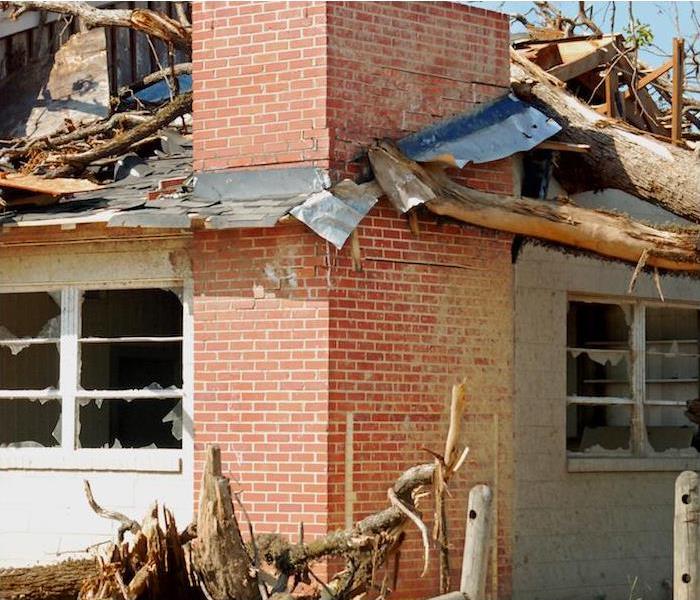 SERVPRO of Paulding/Polk Counties will help you with the whole restoration process after a storm. Call us today.
SERVPRO of Paulding/Polk Counties will help you with the whole restoration process after a storm. Call us today.
You never know when you might suffer property damage due to bad rain, storm damage, wind or debris. In the wake of severe weather, you’ll want to contact SERVPRO to inspect, document and restore any damages to your business for you.
There is a lot you can do to mitigate storm damage, but it’s never completely preventable. Storms can be extremely costly to businesses.
In fact, experts predict that storm and flood damage could cost businesses over $13 billion in 2022.
It’s not always easy for the untrained eye to spot damage after a storm, and damage that goes unnoticed can grow and become even more costly and destructive. When you call SERVPRO to inspect the damage, here are just a few of the main areas we would look for when inspecting your property:
The Roof
Roof damage is one of the most often-occurring kinds of storm-related property damage. We will inspect the roof for loose, curled, missing or cracked shingles.
Additionally, dark patches on asphalt shingles may indicate water damage. Dents or weakened areas on the shingles are indicators of hail storm damage.
We will check for water damage indoors that has sneaked through a damaged roof. Water stains or leaks running down the wall, through a skylight or pooling in the center of the ceiling are further indications that the roof has a leak.
However, not all indications of water damage are obvious. The wisest course of action is to hire an expert to evaluate your house and search for indicators of a leaking roof.
The Exterior
Following a severe storm, you’re likely to find debris scattered around the exterior of your property. These pieces of debris may strike your property, cars or other structures, such as barns or machinery.
We will inspect the whole exterior of your property for loose or broken siding, doors, windows and gutters, among other things. Oftentimes, the exterior can be a significant source of unwanted water leakage that can cause interior water damage and flooding during a storm.
Dents or bends in gutters are often the result of hail, wind and/or debris damage. It is critical to employ an expert to evaluate, record and repair any possible damages precisely and safely.
Windows and Doors
Windows may potentially sustain damage during a severe storm, especially one with heavy winds. Our technicians will inspect the glass for broken panes, shattered glass, chips, scratches and fractures. Additionally, we will search for indicators of damaged seals that allow water to enter through windows and doors.
SERVPRO of Paulding/Polk Counties will help you with the whole restoration process after a disaster, from damage assessment through restoration and rebuilding. Do not hesitate to contact our professionals to get your storm damage emergency repaired immediately and properly.
Reduce the Chance of Commercial Storm Damage
3/18/2022 (Permalink)
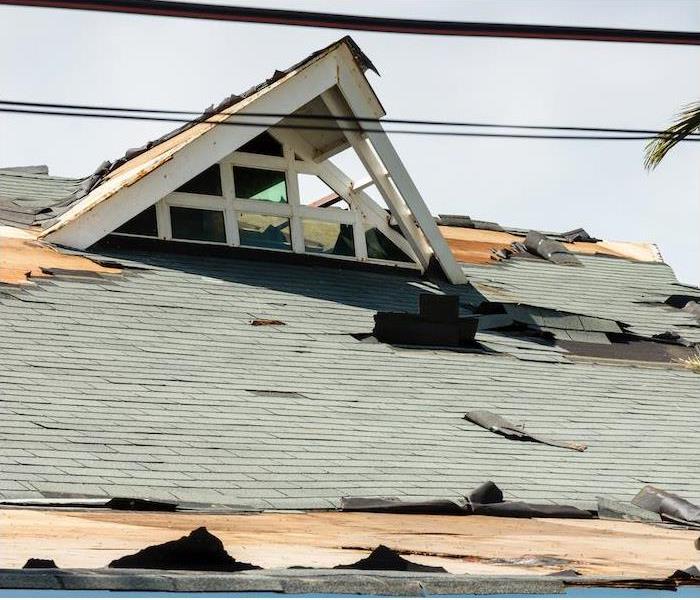 If storm damage ever causes a mess at your business, call the pros at SERVPRO of Paulding/Polk.
If storm damage ever causes a mess at your business, call the pros at SERVPRO of Paulding/Polk.
Without warning, high-velocity winds from severe weather can damage your business. No storm’s timing or severity can be fully predicted.
Tornadoes are a common occurrence here in Georgia. Tornado winds can reach up to 300 mph in the most powerful tornadoes. Wind speeds of this magnitude can lift vehicles into the air, tear houses and businesses apart and turn shattered glass and other debris into dangerous projectiles.
It might feel like there’s nothing that can be done to prevent the full severity of storm damage, but a few simple precautions can be taken to help reduce the chance of property damage and save you money on repairs and missed productivity.
The Roof
It is critical to ensure your roof can hold up against storm damage. Storms may cause shingles to fly off or be broken by hail and debris.
To ensure that your business’ roof is protected against wind damage, get it assessed for a variety of factors, including the following:
- Shingles have a high wind and impact resistance rating
- Shingles are snugly secured and fitted together
- The roof sheathing is set firmly in place
- The connection between the roof and the walls is sufficiently secure to prevent the roof from being lifted off by high winds and updrafts
- HVAC equipment, skylight and pipelines are securely fastened and will not blow away
Exterior Walls and Doors
Different types of exteriors are more or less prone to damage from storms than others. In fact, steel siding is known as one of the most durable siding options available, as it can withstand harsh storms and damaging winds.
Some commercial spaces can be primarily glass, brick or concrete exteriors, which all have different levels of tolerance to storm damage. To make sure your building’s exterior is protected from wind damage, check the following:
- The structure is well-sealed to prevent wind from entering gaps and crevices and damaging the interior of your business
- Siding and windows are attached securely
- All entry doors are triple-hinged and protected with a deadbolt lock
- Overhead doors are well-reinforced and capable of withstanding heavy winds
Outdoor Areas
Many commercial properties have exterior spaces, from walkways to playgrounds. Perhaps you have outdoor benches, tables and chairs or potted plants.
Check the following to ensure that the areas around your property are protected against damaging winds and storms:
- Storage sheds and structures are securely anchored
- Everything you keep outdoors (equipment, inventory and supplies) is either secured or readily moved inside
- Dumpsters, outdoor lighting fixtures and fences are secured
- Large bushes and trees in close proximity to your structure are healthy and pruned
- Outdoor advertising or signage are secured
You’ve worked hard to get your business to where it is today. If storm damage ever causes a mess at your business, call SERVPRO of Paulding/Polk to handle any and all storm disaster cleanup and restoration.
Can Lightning Cause Serious Property Damage
3/14/2022 (Permalink)
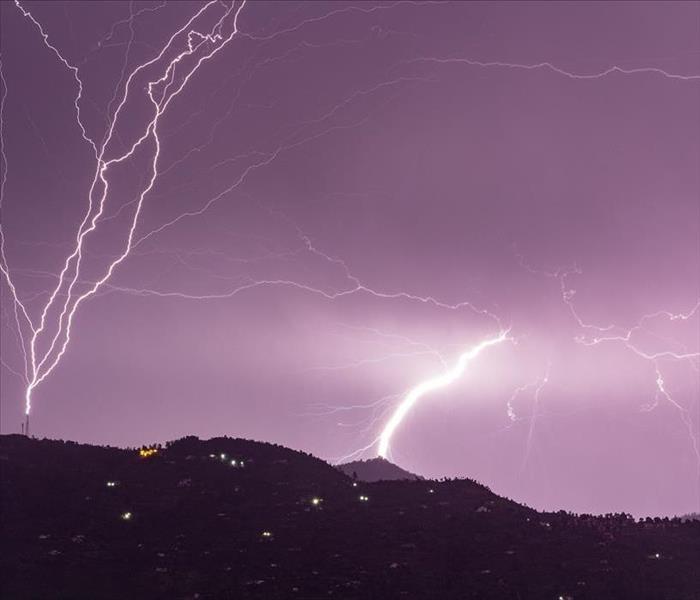 Lightning can cause serious property damage. If you need help repairing your home after lightning damage, contact SERVPRO of Paulding/Polk today.
Lightning can cause serious property damage. If you need help repairing your home after lightning damage, contact SERVPRO of Paulding/Polk today.
Though most rain fronts that pass through our area are no major event, severe weather is something that is entirely different. Severe weather can strike nearly any time of year if conditions are right, and with it, bring heavy rains, high winds, lightning strikes, hail and more—all of which can be rather dangerous.
Many of us are cognizant of the injuries and fatalities that lightning strikes in particular can cause. Around the world, they are responsible for 2,000 deaths each year and many more injuries. However, did you know that lightning can cause serious property damage, too? Below, we will be taking a look at why lightning strikes where it does and the types of damage to be aware of.
Why Does Lightning Strike Where it Does?
The majority of lightning strikes that occur during any given thunderstorm will be from one cloud to another as the electrical charge is transferred from area to area in a storm. However, with all this electricity in the air, lightning can also begin to target the ground, as objects such as buildings, trees and bushes send up sparks to meet it. While it is true that taller objects are more likely to be struck by lightning, it is not a guarantee—lightning will strike anywhere there is a charge, whether it be the ground, a tree or a home.
How Does Lightning Cause Damage?
When lightning strikes a building, it can cause serious property damage as a result. The main ways this can happen are:
* Damage due to fire where lightning strikes. When lightning strikes, it is incredibly hot—and therefore, this heat will be transferred to the impacted target. In many cases, this will cause immediate combustion at the site of the strike.
* Damage due to electrical fires. In addition to the threat that lightning can cause an initial fire where it strikes, it can also cause damage due to electrical fires. Because lightning carries an electric charge, it will travel through a building’s wires once it makes contact—this can cause damage to those wires and lead to an electrical fire, either immediately or later on.
* Water damage due to impact. Even if it does not start a fire, lightning will leave a hole where it strikes a home, which can lead to water damage if it is raining.
*If you have damage to your home, due to lightning or other storm-related causes, we are the team to call. We are here 24/7 to help—get in touch today.*
How Does Water Damage Lead to Mold?
3/14/2022 (Permalink)
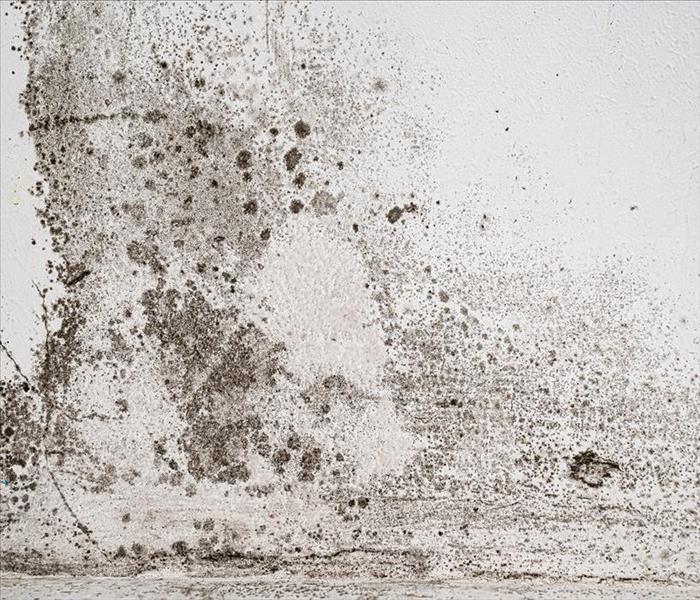 If mold invades your home, call SERVPRO of Paulding/Polk counties today!
If mold invades your home, call SERVPRO of Paulding/Polk counties today!
Water damage is something that no homeowner ever wants to experience, but unfortunately, it is a rather common occurrence. Between hidden leaks that can pop up in your plumbing system, water seepage in crawl spaces or surprise roofing issues, there are lots of ways that water damage can pop up in a home.
While water damage is an inconvenience, it can lead to an even more pressing concern: mold growth. Mold growth thrives in damp places, so any time water works its way into an area it should not be in, there is a high chance that mold will find its way there as well. Below, we will look at why mold and water damage are so closely related so you can be on the lookout for any signs of growth.
Why Water Damage Often Leads to Mold
**Mold loves humidity.** The nature of water damage can vary, but in incidents where there is flooding or general dampness in an affected area, the humidity levels can get rather high. Basements, laundry rooms and bathrooms can all turn into very humid areas, which can create the ideal environment for mold to take hold. Ideally, the humidity in an area should stay below
50% at all times in order to discourage mold growth.
**Mold spores need moisture to grow.** Many people are surprised to learn that mold spores are everywhere—in nature, mold aids with the decomposition of organic material, and its spores spread via the air. Therefore, mold spores are always floating around looking for an ideal place to land, which is how they wind up in homes (often after hitching a ride on clothes, shoes or pets). However, mold spores require moisture to grow, so while they may work their way into homes, if they cannot find an area with moisture that they can grow, they will not be able to
reproduce.
**Mold grows well in contaminated waters.** Oftentimes, water damage is caused by water that is not necessarily clean, such as rainwater or floodwater. Mold can grow especially well in these types of waters because of all the bacteria that is already present, making water damage of this type especially susceptible to mold growth.
*If you are curious about how mold remediation works, we are here to help. Contact us today to learn more about our remediation services or to report mold damages.*
Let’s Prepare Your Emergency Ready Plan Together
3/11/2022 (Permalink)
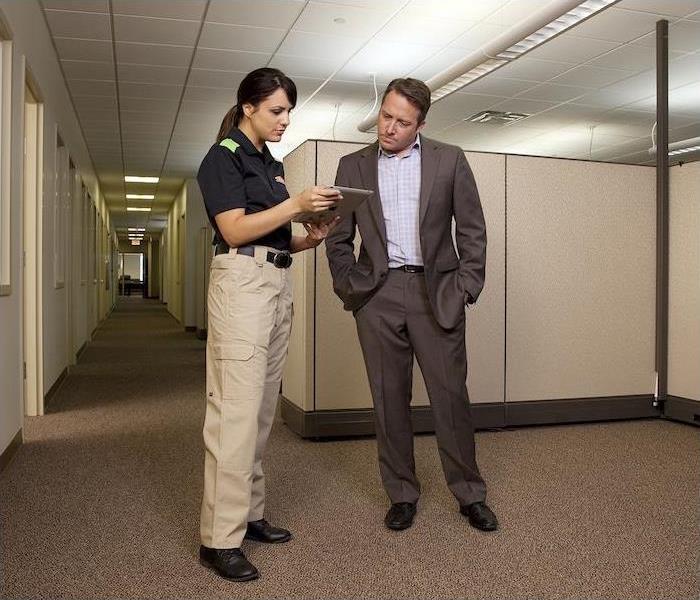 If the day comes where your business is hit with disaster or emergency, you can rest assured SERVPRO of Paulding/Polk Counties will be there
If the day comes where your business is hit with disaster or emergency, you can rest assured SERVPRO of Paulding/Polk Counties will be there
Being a business owner can seem easy—the idea of getting to pick your hours is ideal! But the reality is, you’re always on call, whether you are there or not, and you are responsible for things like employee relations, payables and safety!
Disasters or accidents can disrupt your business in only a matter of minutes. It’s actually scary to see that FEMA states 40% of small businesses will not reopen after a natural disaster, and a quarter of those that do reopen are forced to close their doors within a year.
That’s why it’s imperative to have a safety plan in place for your business. Three-quarters of all small businesses don’t have a plan in place, and now is the perfect time to make the change. We are here and ready to help you become better prepared.
We are always ready and proud to serve our local communities such as Roberta, Fort Valley, Byron and Zenith, along with so many others. Together we will work to get your Emergency Ready Plan started. Being locally owned and operated means we are all neighbors, and we will help our neighbors through the good and bad times.
When we work together, our goal is to help minimize downtime within your company, and help everyone understand what to do. We will carefully review and analyze your business needs to determine what you might need in the face of a disaster. From there, we’ll detail exactly what to do, including alternative locations to work from and data backup, so that you can react with confidence and not chaos.
Business owners have to worry about enough, and disaster planning is one thing that we can help take off your plate. Contact your local SERVPRO experts to help you prepare your Emergency Ready Plan. You can trust us to protect your business and employees!
When your business is ready to prioritize planning and safety to prevent extended downtime, contact SERVPRO to get the Emergency Ready Plan underway from the folks who know all there is to know about disaster and recovery.
What Conditions Are Right for Mold to Grow?
3/7/2022 (Permalink)
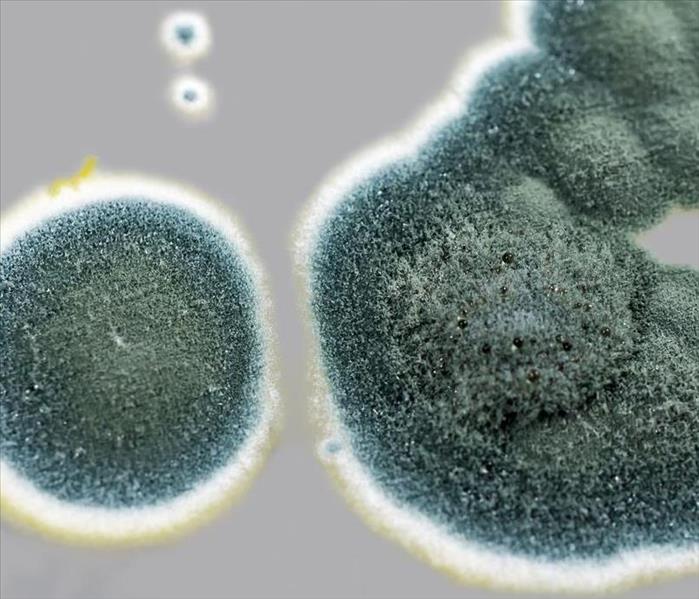 Mold can cause health effects. Call SERVPRO of Paulding/Polk counties if you have mold in your home.
Mold can cause health effects. Call SERVPRO of Paulding/Polk counties if you have mold in your home.
Mold growth is a complicated issue for homeowners to have to face. While mold can only grow if the conditions are right, there are many instances where this is the case—and once mold establishes itself, it is extremely difficult to fully get rid of it without professional help with the remediation process.
Fortunately, the conditions where mold is likely to grow can be abated in most instances. Because prevention is so important when it comes to mold management, today we will be looking at the conditions that are ideal for mold to grow and how they can be prevented.
The Conditions That Mold is Likely to Grow In
**Warm, humid conditions.** Mold requires moisture to grow, but it does not always have to be standing moisture that allows it to start its process. Humid areas, such as bathrooms, basements and laundry rooms, are prime candidates for mold growth in the home. When the air in an area becomes saturated with humidity, it can lead to high moisture throughout the room which can allow mold to become established.
**Poorly ventilated areas.** Mold spores are spread via the air, so when areas are poorly ventilated, it is much easier for mold to settle in one spot and begin to reproduce. This is doubly concerning as areas with poor air circulation are also typically areas with high humidity, which can create an even more ideal environment for mold spores to land in. Installing fans or other types of air flow system in areas without much ventilation is a great way to prevent mold.
**Any area with untreated moisture damage.** Mold will often establish itself around water damage, as it thrives on moisture. Any area that has a buildup of moisture is ripe for mold growth, which means hidden leaks are often first identified by the signs of mold around the area. This is why it is so important to have water damage abated quickly and professionally when it occurs, because the longer it is left untreated (or if it is untreated properly), the worse a mold problem is able to become.
*If you are in need of mold remediation or would like to learn more, we would love to help. Contact us today to learn more about our mold remediation services!*
The Dangers That Occur When Severe Weather Strikes
3/2/2022 (Permalink)
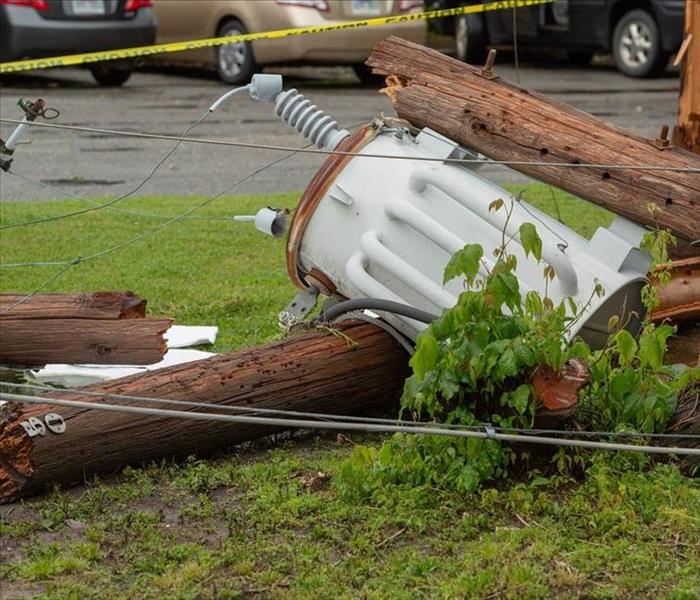 If your home is damaged from flash floods, lightning, or hail call SERVPRO of Paulding/Polk counties 24 hours a day!
If your home is damaged from flash floods, lightning, or hail call SERVPRO of Paulding/Polk counties 24 hours a day!
More than simply being an inconvenience, severe weather can cause serious damage in a variety of ways. In addition to being dangerous enough to cause personal injury to anyone who has not sought out adequate shelter, severe weather can also cause property damage to any homes or businesses in the line of the storm.
While severe weather can often move through an area without causing much damage, any time it is a possibility, it is wise to be vigilant so you know when to seek safe shelter to protect your family. Below, we will be taking a look at the types of hazards that happen during severe weather so you can be better prepared for their occurrence.
The Types of Hazards That Occur During Severe Weather
**Flash flooding threats.** Flash flooding is a serious problem, in part because it is quite unpredictable—hence the term “flash.” Flash flooding is more common in low-lying areas, but it can happen anywhere that receives a heavy amount of rainfall in a short period of time. Rapidly rising creeks and ponds are often sources of flash flooding, but even overwhelmed storm drains can become backed-up and impact an area.
**Fire hazards from lightning strikes.** Lightning strikes can occur any time there is a thunderstorm, and they are responsible for around 2,000 deaths per year throughout the world. In addition to being dangerous for anyone caught outside, lightning strikes can also introduce serious fire risks when they strike homes. Lightning can start a fire when it hits a home, due to the intense amount of heat it transfers, but it can also cause electrical fires as it travels through (and damages) a home’s wires on its way to seeking grounding.
**Damage due to high winds and hail.** Severe weather is often accompanied by high, straight-line winds up to 100 miles per hour—which as you can imagine, can cause serious damage. High winds can break off tree branches and turn them into projectiles, which can shatter windows, damage roofs and make homes susceptible to water damage as a result of being vulnerable to heavy rains.
*If severe weather strikes your home, you can depend on us to help. We have a team of storm restoration experts on hand 24/7—contact us today to learn more.*
What Types of Places Are Likely to Attract Mold Growth?
3/2/2022 (Permalink)
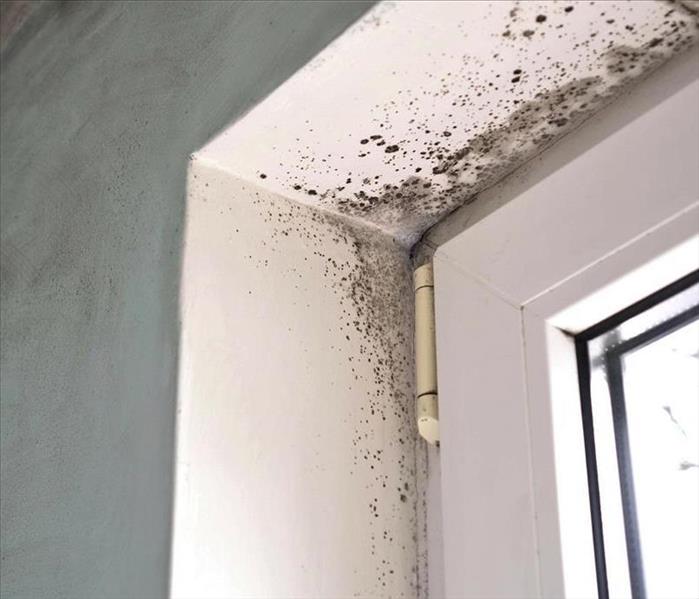 If mold invades your home, call SERVPRO of Paulding/Polk to evict it!
If mold invades your home, call SERVPRO of Paulding/Polk to evict it!
Mold growth can be a frightening thing for homeowners to deal with. It is an insidious and stubborn problem that can cause significant damages if not treated quickly and professionally by mold remediation experts—but how do you know if you are at risk of experiencing mold growth?
One of the only positives about mold is the extremely specific conditions that it needs to grow. Mold is only likely to be found in a few places where the environment is right for it to be able to take hold.
Below, we will be taking a look at what these places are so homeowners know exactly where to keep their eye out for these harmful spores. Preventing mold and treating it quickly when it does arise is the best way to stop the issue from getting out of hand.
The Places Where Mold Is Likely to Grow
**In bathrooms and laundry rooms.** Mold thrives in areas with high moisture content, so anywhere that experiences regular and high humidity—such as bathrooms and laundry rooms—is likely to be a haven for mold. Establishing consistent airflow and mitigating the humidity in these areas can go a long way in preventing mold from ever growing in these places.
**In basements and crawl spaces.** Basements and crawl spaces are often popular spots for mold to be discovered because of how ideal their conditions are. Not only is humidity typically high in these areas, but they are also often dark and may even experience water damage from ground seepage if they are not properly weatherproofed. Dank odors and condensation in these areas are often a sure sign that mold is likely to take hold.
**In areas that have experienced water damage.** Water damage is a serious issue for several reasons, including the fact that it is likely to give rise to mold growth if it is not treated properly. Whether the water damage is from a hidden leak in the plumbing system or a flooding issue, it is important that it be addressed quickly by water restoration professionals to completely remove the moisture and ensure that mold is not likely to become a lurking threat.
*If you are in need of mold remediation, water damage restoration or would simply like to learn more, we are here 24/7 to help. Contact us today to learn more about our services.*
How Can High Winds Cause Damage During a Storm
3/2/2022 (Permalink)
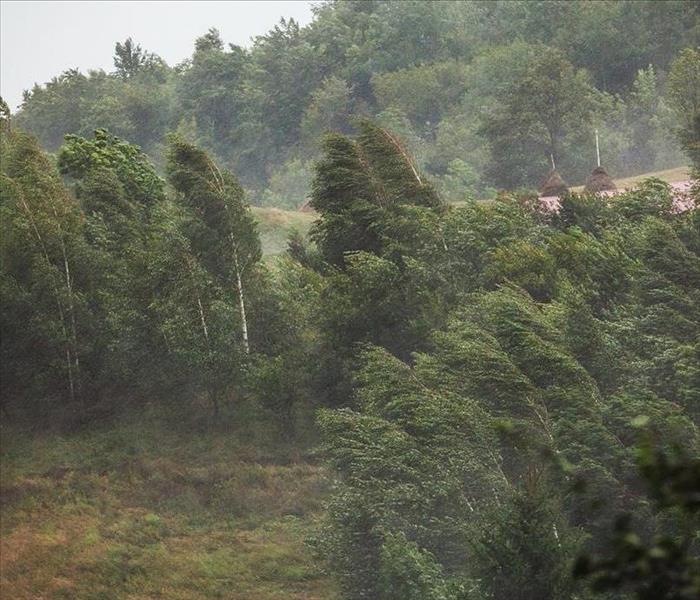 If your home has been damaged due to high winds, call SERVPRO 24 hours a day.
If your home has been damaged due to high winds, call SERVPRO 24 hours a day.
When it comes to severe weather, there are a lot of ways it can cause harm to an impacted area. More than 75% of deaths pertaining to natural hazards are a result of severe weather, and the property damages caused by storms can be far-reaching and severe. When most people consider severe weather hazards, heavy rains and lightning strikes are probably the first things that come to mind—but unfortunately, straight-line winds can also be significantly damaging to property and people.
Damaging straight-line winds are anything over 50–60 miles per hour, but gusts can reach up to 100 miles per hour if conditions are favorable. When thunderstorms are over an area, they will often cause downdrafts of wind that impact the ground below in several unfavorable ways, which we will look at below.
How Do High Winds Lead to Storm Damage?
**They can rip limbs from trees.** While trees grow to have a certain amount of flex to them in order to withstand the threat of high winds, occasionally, branches will still be ripped from the tree. This is especially true of branches that grow at an odd angle or are less than healthy, which is why trimming trees regularly is so important. When limbs are ripped from trees, they can become high-speed projectiles, crashing into any object or home that ends up in their path.
**They can topple mobile homes.** Because straight-line winds can reach up to 100 miles per hour, they can easily generate an extremely strong force—and in many cases, this can be enough to topple mobile homes or trailers. Even anchored mobile homes can be at risk if winds are strong enough, which puts the people who seek shelter in these homes at serious risk.
**They can make homes more susceptible to water damage.** High winds and water damage often go hand in hand, because winds can cause damage to homes that make them more susceptible to water damage. Projectiles carried on the wind can shatter windows, which will then let in rain. Additionally, high winds can damage roofing shingles, flashing and other exterior elements of the home designed to keep moisture out, resulting in hidden leaks that can be costly.
*If you have storm damage to your home, you can count on our team to help. Get in touch today to learn more about our restoration processes—we’re here 24/7 to help.*
Whatever the Disaster, We’re Here to Help Your Business
2/23/2022 (Permalink)
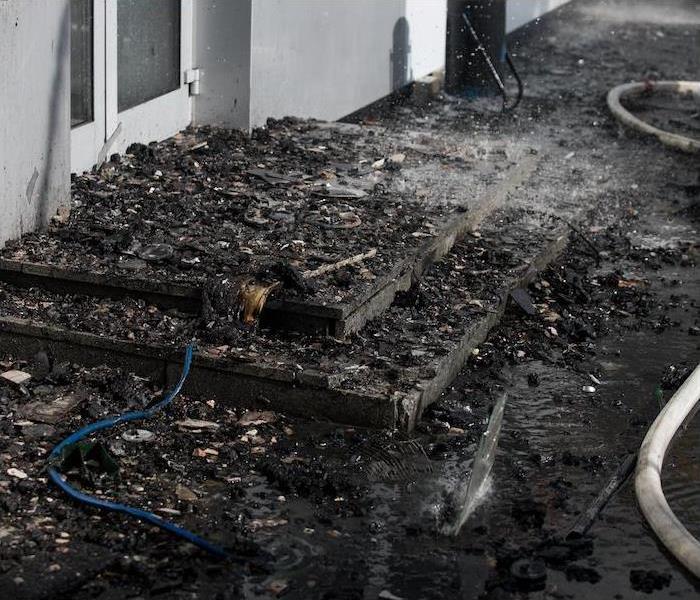 No matter what causes the damage, we can handle it. SERVPRO of Paulding/Polk are your local restoration experts.
No matter what causes the damage, we can handle it. SERVPRO of Paulding/Polk are your local restoration experts.
Even on a normal day, it’s difficult to operate a business. With so many competing demands for your time and attention, it’s easy to see why managing or owning a business might be a little stressful.
Consequently, if something were to interrupt business like damage from a natural disaster, you might need some experts to step in and lend a hand.
SERVPRO is the industry leader when it comes to commercial disaster cleaning, recovery and restoration. Our goal is to help you get back on your feet after a crisis by handling the cleanup and restoration process so you can continue to focus on what you need to do to keep your business going.
No matter what causes the damage, we can handle it:
Smoke and fire damage. The NFPA estimates that U.S. fire departments respond to an average of 3,340 fires in office properties per year that cost an annual average of over $110 million in property damage. We can take care of everything from the demolition and reconstruction of your building to the elimination of smoke odors.
Water damage. Damage caused by water seeping inside the building from any number of things, such as a storm, leaky roof, broken pipes, an overflowing water heater and other unanticipated problems, can cause issues from carpets getting saturated to drywall getting destroyed and even structural integrity potentially becoming compromised. No matter what happens, we’ll get you back up and running quickly and thoroughly.
Weather-related disaster damage. Natural disasters affect one out of every three businesses, and many of them are not prepared. One way to be prepared is to know what to do between disaster and the completion of your restoration. We can set your business up with a SERVPRO Emergency Ready Plan, which will help you know exactly what to do if disaster should strike.
Regardless of the nature or severity of your needs, we can assist you in getting back to business as quickly as possible.
Contact SERVPRO of Paulding/Polk Counties when you’re ready to have the best in disaster cleaning and recovery on your side. We’re here to assist you in preparing for or recovering from a catastrophe.
Have a Strong Commercial Fire Safety System
2/18/2022 (Permalink)
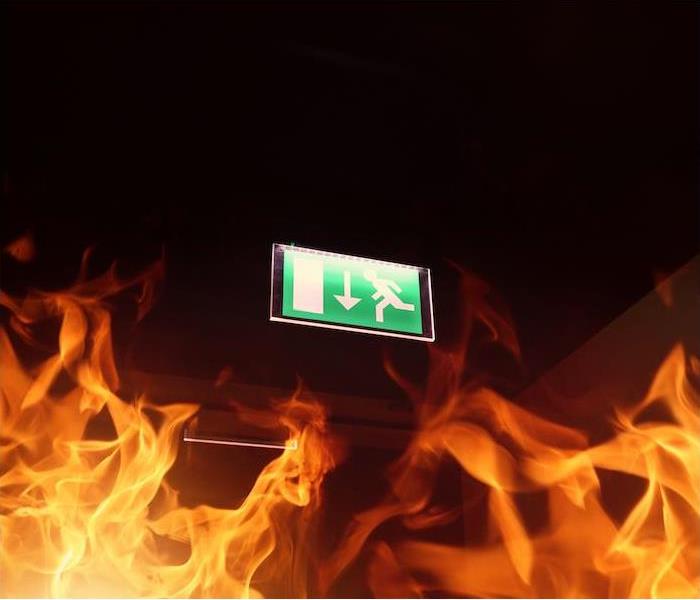 A fire can happen to any business. If your workplace experiences any damage from fire, contact SERVPRO of Paulding/Polk.
A fire can happen to any business. If your workplace experiences any damage from fire, contact SERVPRO of Paulding/Polk.
Fires can cause serious damage and inconvenience to businesses. Ensuring that you are prepared for a fire before it happens will protect your employees and your facility.
With these four critical components, you can construct a solid fire safety system that will help curb a fire if one happens to spark up at your workplace.
Smoke and Fire Alarms
When it comes to fire safety in the workplace, the first and most important line of defense is a working fire and smoke alarm system. Everyone is alerted when the fire alarm goes off, indicating that there is a possible threat and that an emergency evacuation is required.
Fire Extinguishers
Fire extinguishers are really only helpful for small fires, but knowing how to use one could prevent extreme damage to your facility. When using fire extinguishers, you and your employees should use OSHA’s “PASS” system:
P—Pull the pin on the extinguisher
A—Aim at the base of the fire
S—Squeeze the handle
S—Sweep at the fire, and move side to side
Sprinkler System
The usage of a sprinkler system is important as well. Sprinkler systems can be programmed to activate when the temperature reaches a specific level and can douse even very large flames.
You’ll likely need a professional inspector to provide regular inspections to ensure sprinkler and standpipe systems are properly maintained and running. As with any emergency equipment that is not used every day, ensuring it is in working condition regularly is essential.
Emergency Lighting and Signage
Conditions may be hectic and confusing during a fire. The building’s electrical power also often goes out. It might be difficult to see or navigate the building due to power outage, sprinklers going off, as well as smoke in the air.
People are more likely to be able to see well enough to leave the building and find safety if the facility is equipped with backup emergency lights that turn on automatically, along with lighted exit signs.
A fire can happen to any business. If your workplace happens to be affected, SERVPRO of Paulding/Polk has expert fire restoration professionals who can assist you immediately.
The 2 Most Common Causes of Commercial Water Damage
2/18/2022 (Permalink)
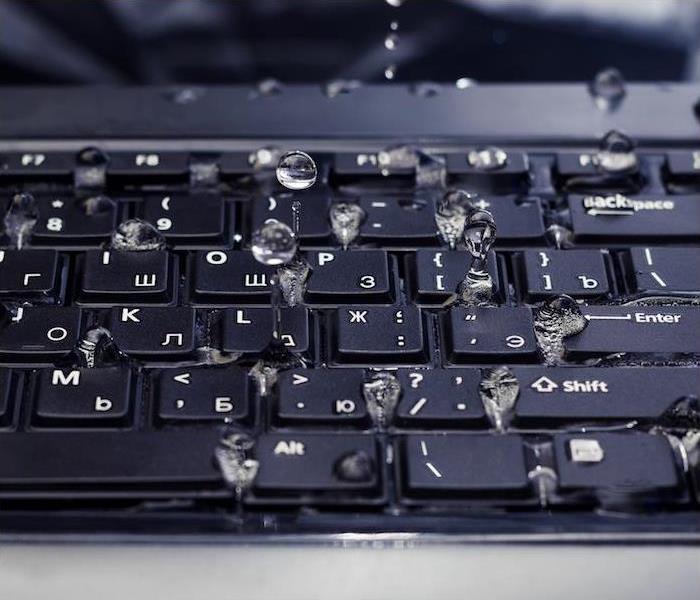 Water damage doesn’t wait for a convenient time to cause problems. SERVPRO of Paulding/Polk is ready 24 hours a day.
Water damage doesn’t wait for a convenient time to cause problems. SERVPRO of Paulding/Polk is ready 24 hours a day.
When you’re running a business, it’s easy to let a few things slip your mind. Perhaps checking your facility for water damage is one of those tasks. Water damage can sneak in quietly, but can pack a big punch if it isn’t found and treated quickly.
Water damage can cause expensive losses for business. Thankfully, it’s not impossible to find and address water damage early on, before it gets to be a major issue.
There are a lot of ways water can creep into your facility, but these two are the most common:
Leaks in the plumbing system. A pipe breaks, an appliance hose ruptures or if your facility has a fire, the suppression sprinkler system turns on and drenches your facility in water.
Pipes may also unexpectedly leak during freezing conditions due to frozen water. Burst pipes are sometimes difficult to detect since they are not as visible from the surface and may not always result in obvious puddles of standing water.
Water stains near piping areas or the development of musty odors are evidence of plumbing leaks. You might notice the stains on the ceiling, running down the walls or on your floors.
Roof leaks. Leaky roofs are often the result of severe rainfall combined with insufficient or incorrect roof drainage. Excessive rainfall, such as that seen during natural disasters, may often result in widespread damage when it leaks inside.
This sort of damage has the potential to develop further if it goes unnoticed with fewer people in the facility, like overnight or on a weekend. Roof damage may also result in secondary damage such as unsightly mold development, if left unattended for an extended period of time.
Commercial property insurance typically provides coverage for unforeseen pipe bursts, malfunctioning appliances and sprinkler system water damage caused by a property fire. Insurance also often includes coverage for damage to major equipment, which is crucial in the event of roof water leaks.
Water damage doesn’t wait for convenient times to cause problems, and we don’t wait for convenient times to respond. If water damage creeps up at your commercial property, SERVPRO is ready 24 hours a day and seven days a week to help.
SERVPRO Gives You a Seamless Recovery Process
2/16/2022 (Permalink)
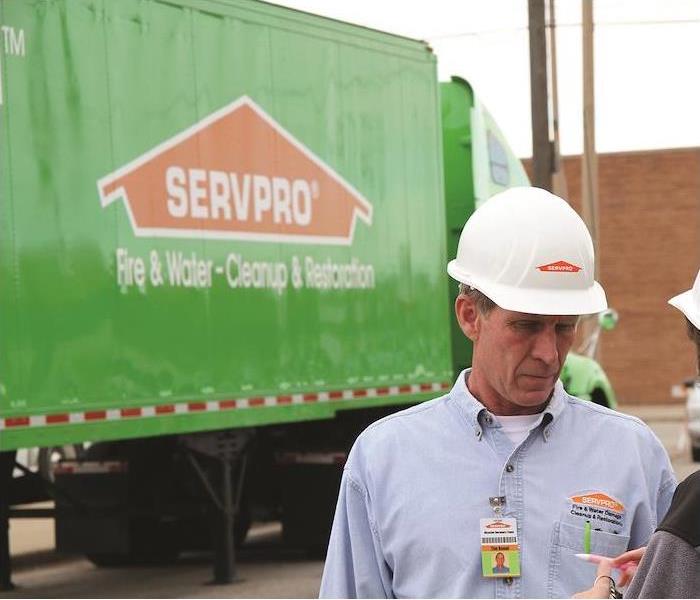 We’ve got the tools and technology to handle any job. Contact SERVPRO of Paulding/Polk counties to learn more.
We’ve got the tools and technology to handle any job. Contact SERVPRO of Paulding/Polk counties to learn more.
Doesn’t a cake sound delicious? If it didn’t before the beginning of that sentence, it probably does now.
So let’s bake one from scratch. Ready? First, we’ll go to the local poultry farmer to get some eggs, then the dairy farm for milk. Then we’ll head over to the mill for flour (unless you want to mill it at home for authenticity, and…sugar from the cane fields, maybe?
Yeah, you could go to those extreme lengths to get all your ingredients. But it’s the 21st century, and at this point most of us are looking to find one place we can go to get all the things we need for a cake, or whatever other confectionary delight you may have in mind.
Most of our shopping isn’t modular anymore, because part of what makes a great business great is that it offers a level of convenience that makes it easy to use and often decreases the buyer’s cost.
One of the many great things about being your local SERVPRO is that we can provide you with a single place to take care of every element of restoration after a disaster. Whether the nature of your damage is from water, fire, natural disaster or anything in between, we can get your home fully back to tip-top shape from beginning to end.
Need carpet dried and cleaned? We’ve got you. Drywall burned up in a fire? We can replace it, finish it, and even paint it. (You know we started as a painting business, right?)
Everything from reframing and construction to the tiniest finishing touches—we can make it happen, and you don’t have to worry about the process dragging on because multiple companies and sets of contractors have to wait on each other, communicate poorly, undo, redo and haggle with your insurance agent. From step one to done, SERVPRO has it under control.
We’ll even talk to your insurance company to simplify that process, too.
So when a heavy storm rips through the house, an unexpected flood fills your basement with water, or an electrical fire eats up your hallway, don’t call five companies—call one.
Did you hear the oven ding? Cake’s ready.
For an A to Z cleanup, recovery and restoration solution, you don’t have to worry. Your local SERVPRO has all the tools and teams necessary to finish your project, no matter how complex.
SERVPRO Has the Expertise to Handle Your Cleanup and Recovery
2/11/2022 (Permalink)
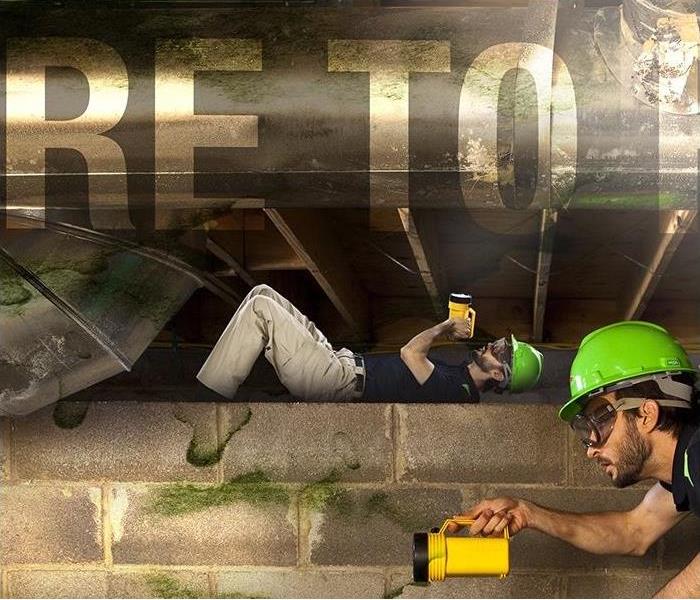 When you need cleanup and recovery of any kind, SERVPRO of Paulding/Polk counties has your back.
When you need cleanup and recovery of any kind, SERVPRO of Paulding/Polk counties has your back.
Have you heard of the 10,000 Hour Rule? It’s an idea popularized by author Malcom Gladwell that says, essentially, it takes 10,000 hours to master one’s craft and become an expert.
Noted achievers like Bill Gates in the tech world and Alex Rodriguez in sports and entrepreneurship subscribe to the idea that it takes concerted effort over a long period to be able to truly call yourself one of the best in a given field.
If the 10,000 hour rule holds true, then you can only imagine the level of expertise you can expect when you call your local SERVPRO to help you after a disaster in your home or business. Think about it—1,800 SERVPRO teams nationwide, doing business over the span of a half-century? We tried to do the actual math, but it just made us go cross-eyed.
The point is that when you call SERVPRO, you can be absolutely certain that you’re calling a reputable team of true experts, highly trained and heavily equipped for any home recovery need you may have.
Every SERVPRO franchise owner goes through complete training at the SERVPRO National Training Center, and every team member sits under them to extend that knowledge. We actually have a training house that we flood, set on fire and otherwise destroy, so that our teams can learn firsthand the latest techniques for restoring and repairing damaged homes, furnishings and more.
Expertise matters. And in an age where anyone can get on social media and crown themselves an expert, having a proven track record is what can set one service apart—and nobody has the track record of SERVPRO. For more than 50 years, we’ve satisfied literal millions of home and business owners with quality service and outstanding care.
When you call SERVPRO of Paulding/Polk Counties, you can rest assured you’re getting in touch with teams that know what they’re doing because they’ve been doing it for a lot of people, for a very long time. We’ve put in our 10,000 hours as a company many times over.
When you need thorough, expert home cleaning or restoration, you know who to trust. Contact SERVPRO when disaster strikes, and let the pros handle it.
Trust SERVPRO for Your Remodel
2/9/2022 (Permalink)
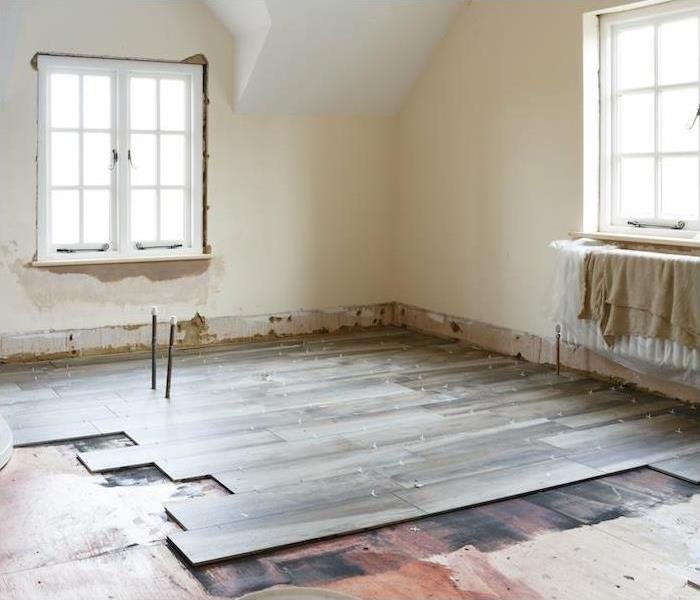 When you call SERVPRO of Paulding/Polk counties, rest assured you’re getting in touch with the best restoration team in the business.
When you call SERVPRO of Paulding/Polk counties, rest assured you’re getting in touch with the best restoration team in the business.
We talk a lot around here about recovery, damage from storms and fires, that sort of thing—and we should. A great deal of what we do revolves around helping families and business owners who are struck by sudden situations and find themselves in need of a trustworthy service company to help them restore their damaged homes and business.
That’s a role we’re proud to fill for millions of customers nationwide, and it’s gained us the industry-leader reputation we’re honored to have earned.
But it doesn’t take a tornado for you to take advantage of SERVPRO’s expertise.
Our highly trained construction teams can help you beautify, add on or remodel your home for no other reason than it being something you want to do. No disaster required.
Recent studies show that as many as 90% of homeowners plan on remodeling their homes at some point, and almost four out of 10 plan on doing it in the next year. If you’re one of these millions of homeowners, call SERVPRO of Conyers/Covington when you’re ready to make it happen, and you can trust the same expert teams who rebuild countless homes after disasters to give your kitchen, basement or whole home the facelift you’ve always dreamed about.
We cover the whole process, top to bottom—from inspection and gathering estimates, to mitigating any hazards or other difficulties that may hinder or interrupt the process, to full-service rebuilding and construction.
We can even go the extra mile and help you with dust control, contaminant protection and more with our premium services and EPA-registered preventive healthcare solutions.
You’ll love your new remodel, and you’ll love how easy the process is when you can trust one team to get your work done, instead of a rotation of multiple repair crews slowing down the job and struggling to communicate with each other.
You don’t have to wait for a flood, fire or natural disaster to take care of the expert construction services SERVPRO offers. We can help you build, rebuild or remodel your home and get the dream look you’ve always wanted.
If a remodel is in your future, you owe it to yourself to check with SERVPRO and get a quote. Call us today and get a local team of experts invested in your project.
Whatever Your Restoration Need, We’ve Got You Covered
2/4/2022 (Permalink)
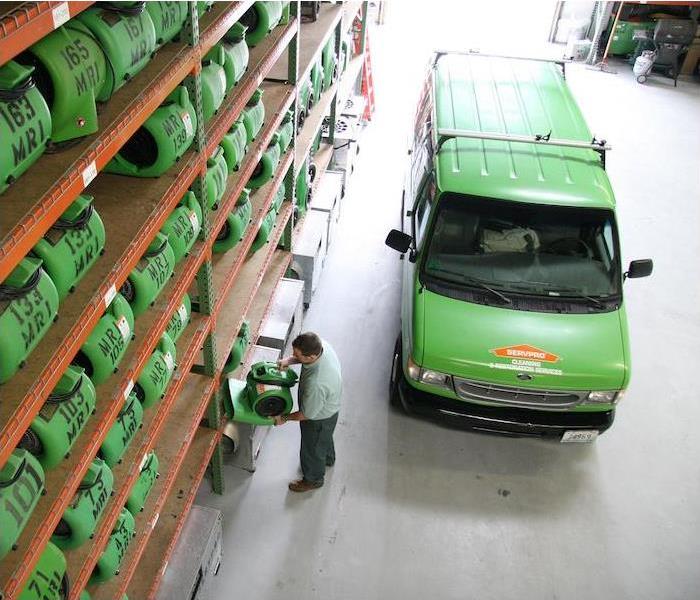 When you need cleanup and recovery of any kind, you can trust SERVPRO of Paulding/Polk counties to get the job done.
When you need cleanup and recovery of any kind, you can trust SERVPRO of Paulding/Polk counties to get the job done.
If you pass by a home or business that is up in flames, your heart truly goes out to those people. But when you see that green SERVPRO truck pull up, you know they are being well-taken care of.
At SERVPRO, we provide full-service cleaning, restoration and reconstruction services. So we will fix or clean things from top to bottom, and we will do it in a timely and efficient way.
Here’s a breakdown of SERVPRO services you can benefit from:
Water damage recovery. Whether you have encountered a flash flood that made its way into your home or you had a pipe that has busted, you can be certain that we will take care of you. When it comes to water, it doesn’t take much to do damage, and that’s why you should call us.
Fire damage recovery. A fire is reported every 23 seconds here in the United States. Fires, and the things used to put them out, can do a lot of damage, which requires lots of cleanup. That’s why we bring out all the help we can get.
Mold removal. Mold damage can creep up on you without you ever seeing it and can threaten the structure of your home. Once it’s established in your home or business, mold can spread quickly and easily, so call in the pros.
Storm recovery. Storms of any kind can cause damage, and no matter the size of damage it causes, you can count on us to help you restore your home or business.
Commercial needs. If you’re a business owner, have peace of mind in knowing we offer you all the same services we offer homeowners, plus a few extra!
General cleaning. Cleaning can be a headache for some, but for us here at SERVPRO, it’s pretty simple. We will provide your home or business cleaning services, including carpet or curtain cleaning and more.
Specialty cleaning. Sometimes you have cleaning needs that go beyond the basics. If you need specialized services such as document restoration or biohazard cleanup, we’re here to help.
Construction. Sometimes, damage can be severe and restoring your place is out of the question. The good news is you don’t have to find another company to help you—SERVPRO can reconstruct your home or business and get it looking “Like It Never Even Happened.”
Add 24-hour service and an easy insurance process to all this, and the picture becomes clear—when you need cleanup and recovery of any kind, you can trust SERVPRO to get the job done.
Why SERVPRO Should Be Your Top Choice for Water Damage Restoration
2/3/2022 (Permalink)
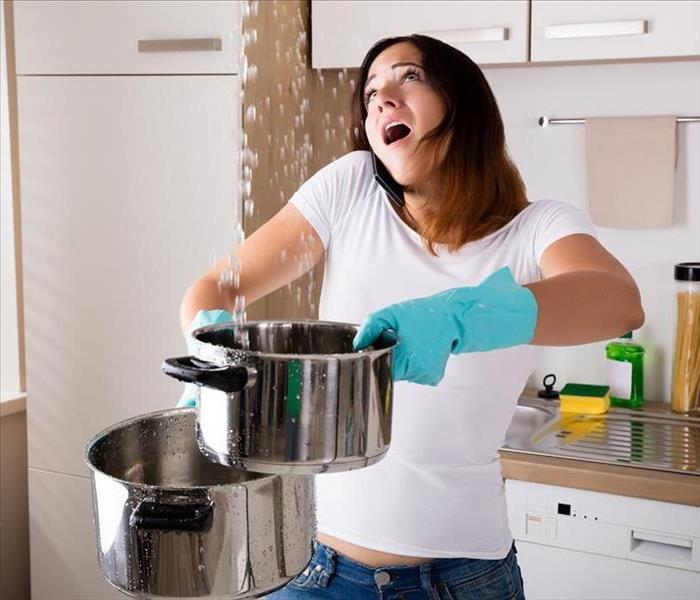 SERVPRO of Paulding/Polk counties is ready 24 hours a day to respond to your emergency water damage.
SERVPRO of Paulding/Polk counties is ready 24 hours a day to respond to your emergency water damage.
Having water damage your home is something that can feel extremely overwhelming. Whether you have a leak, a flood or other type of water-related issue, water damage can be disruptive to your life and your routine. And if you are unsure of how to handle it, it can be more disruptive than you imagine.
No matter where you live, it is important to understand your risk for flooding and other types of water damage—especially because one in 10 properties in the United States are at risk for flooding—so you can plan ahead for it. Water damage can come about suddenly, but having a plan in place for who to call can help you handle it quickly and efficiently.
Why to Choose SERVPRO for Water Restoration at Your Home
**We respond quickly to your call.** Water damage is not something that you want to leave unattended for any length of time. Mold and mildew growth can start quite quickly after water damage, but the faster it is addressed, the less likely this is to be an issue. With our 24/7 emergency line, you can be confident that you can get in touch with us whenever you need us.
**We understand the intricacies of water damage.** Water damage is rarely a simple issue, and oftentimes, it is a rather complex one. Water can seep into many places that are not supposed to be wet, and when these areas are hidden, it is impossible to know the scope of the issue. Because we understand the intricacies of water damage, we monitor impacted areas to find any areas with hidden moisture to make sure any water damage is fully addressed.
**We have a national backup plan.** If there is a widespread issue that causes water damage, such as flooding, resources in the local area can be spread quite thin. We combat this issue by having the backing of our national brand—because there are SERVPRO locations across the nation, we can scale up resources, equipment and technicians as needed, so you can expect the same level of service even when there is an extreme need.
*If you need assistance with water damage in your household, you can count on us to be there for you. Get in touch with us at any time to learn more about our water restoration process.*
A Fire Safety Checklist for Your Household
2/3/2022 (Permalink)
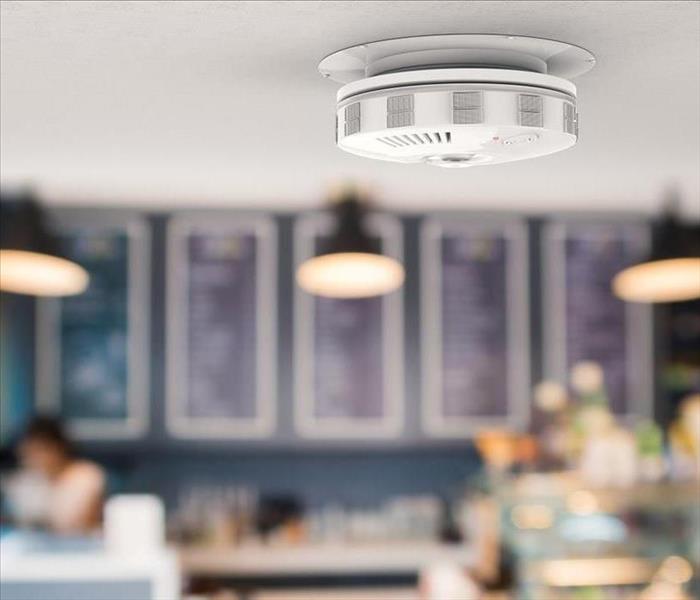 SERVPRO of Paulding/Polk counties is on standby to help you create your Emergency Ready Plan.
SERVPRO of Paulding/Polk counties is on standby to help you create your Emergency Ready Plan.
It is important for any household to practice fire safety as a regular part of their routine. House fires can be both devastating and dangerous, and on average, those in the household will have less than three minutes to escape should a fire begin.
Fortunately, by being vigilant about the prevention of house fires, you can reduce the likelihood of you ever having to experience one. While there is no way to completely eradicate your risk, there are plenty of steps you can take to make your home less susceptible to accidental fires breaking out.
A Checklist for Household Fire Safety
Practicing fire safety is a great way to reduce your risk of experiencing a fire at your home. By referencing this simple checklist, you can be sure you are taking necessary precautions to keep your household safe.
**Smoke Alarms**
* Ensure that you have smoke alarms on each level of the home and in every sleeping area.
* Test smoke alarms each month and replace batteries as needed.
* Note the install date for all alarms and replace after 10 years, even if they are still operational.
**Cooking Safety**
* Be sure to never leave the stove or oven on unattended.
* Keep flammable items, such as towels and wooden utensils, three feet from the stove.
* Store a fire extinguisher prominently in the kitchen.
* Understand the difference between grease fires and other types of fires, and know the methods for extinguishing each.
**General Safety**
* Be sure your household has a fire escape plan that you practice at least twice per year.
* Ensure that every area of your home has at least two exits.
* Store any flammable chemicals in accordance with their label recommendations.
* Keep matches, lighters and other flammable objects away from young children.
* Do not leave candles lit if they are unattended.
* Keep anything flammable at least three feet away from candles, space heaters or other sources of heat.
**Electrical Safety**
* Never overload electrical outlets or extension cords.
* Replace any frayed cords or wires immediately.
* Plug appliances and any heat-generating items directly into the wall, not into extension cords.
* If wall outlets ever feel warm to the touch, stop using them immediately and call an electrician.
*If you have damage from a fire, you can count on us to help. We are here 24/7 for restoration—contact us today to learn more about our processes.
Where to Start on Fire Safety Efforts for the Home
2/3/2022 (Permalink)
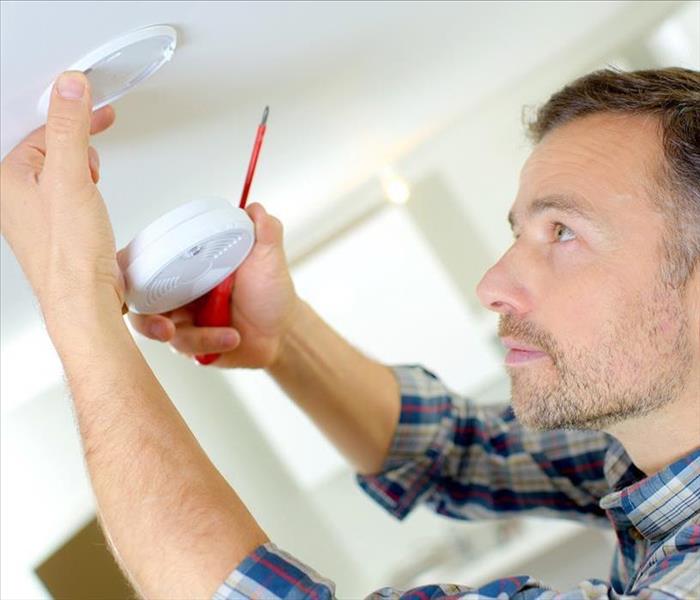 SERVPRO of Paulding/Polk counties is ready 24/7 to help you get prepared for emergencies.
SERVPRO of Paulding/Polk counties is ready 24/7 to help you get prepared for emergencies.
If you are hoping to improve your household fire safety, it can be overwhelming to know where to start. House fires are certainly dangerous, but given the multitude of ways they can start, understanding what fire prevention measures to take around the home can seem like it will be a daunting task.
Fortunately, fire safety is actually quite simple! By adding certain habits into your household routines, you can make major strides in reducing your likelihood of a fire and keeping your family safer.
Read on to learn more regarding where to start when improving fire safety in the home.
How to Begin Your Fire Safety Efforts at Home
**Start with your smoke alarms.** If you are new to fire safety efforts, starting with smoke alarms is really the best thing that you can do. Most people will have less than three minutes to escape when a fire begins in the home, but smoke alarms can ensure all members of your household are alerted quickly so they can begin evacuating. Make sure you have smoke alarms installed throughout each level of the home and in every sleeping area, and test them once per month to be sure they are operational and do not need a battery replacement.
**Create an escape plan.** As previously mentioned, being able to escape quickly is so important in the event of a house fire. It is wise to draft a fire escape plan for your home, and practice it with each member of your household at least every six months. Be sure that you are able to execute your plan in around two minutes, and that everyone knows where to meet up once they are safely outside.
**Consider your cooking habits.** Cooking is one of the most common causes of house fires, so evaluating your cooking habits can be a great way to prevent fires from starting. Be careful about flammable objects near the stove and leaving food unattended while cooking. Additionally, make sure that you have a fire extinguisher in the kitchen that is rated to handle cooking and grease-related fires.
*If you have damage to your home from a house fire, we are the team to call. We are here 24/7 to provide you with a rapid response. Get in touch today to learn more.*
Breaking Down the Fire Tetrahedron
2/2/2022 (Permalink)
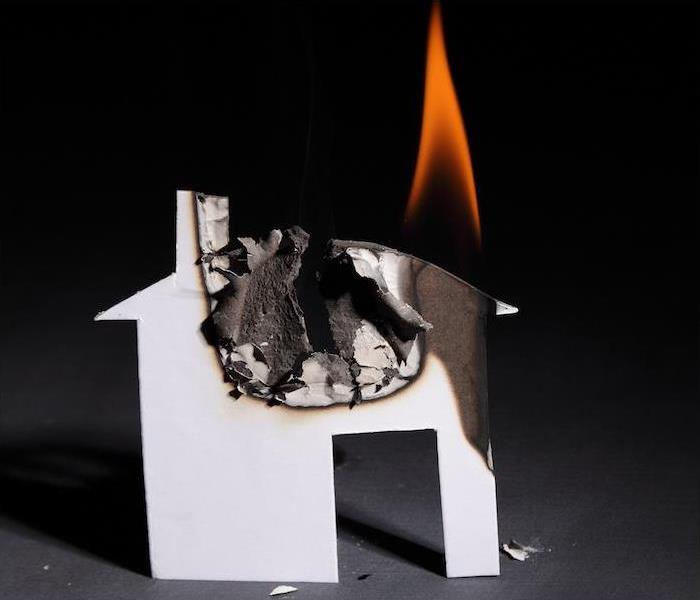 If your home or business has any damage, SERVPRO of Paulding/Polk is ready around the clock to help you recover.
If your home or business has any damage, SERVPRO of Paulding/Polk is ready around the clock to help you recover.
First things first, do you know the definition of a tetrahedron? To cut down on time, let us explain…it’s a three-dimensional, triangular shape with four equal sides.
Now that you know the basics of the geometric shape, let’s discuss what a fire tetrahedron is.
Basically, it’s a way of acknowledging that there are four components needed for fire to start—or four “sides” to the equation. If one of the sides is removed, the structure can’t stand and the fire can’t start.
The 4 Things a Fire Needs to LiveFuel. Fire, like people, needs fuel to keep going. It can be organic or inorganic, but there has to be some source of fuel for a fire to start, such as wood or plastic.
Heat. The amount of heat needed to start a fire varies from substance to substance. But you must have enough heat to cause combustion. Every object has a set point at which it will combust, melting or igniting.
Oxygen. Fire reacts with oxygen to produce a series of chemical reactions. In short, oxygen feeds the fire so that it can keep growing and generates products of combustion in the process.
Chemical Chain Reaction. The cycle of heat, fuel and oxygen combine to produce a chain reaction. This will perpetuate a fire as long as the chain reaction is undisturbed.
The 4 Ways to Stop a FireCool it. This is the most common method for extinguishing a fire, and the most common form of cooling is the application of water. Eventually, when dousing the flames with water, they reach a temperature below what’s needed to sustain a fire.
Smother it. If a fire doesn’t have access to oxygen, then it can’t live. To smother it, you must deprive it of oxygen. This can be a simple task like snuffing a candle, or it can be a little more difficult because it might need chemicals introduced.
Starve it. When a fire burns with no outside interference, it will likely burn until it runs out of adequate fuel. To be proactive, you should remove the fuel source while the fire is still trying to consume it.
Interrupt the chain reaction. Chemical agents can effectively disrupt a chain reaction and put a fire out. One chemical agent that is very effective is halon, but it has an elevated potential for ozone depletion, making it an environmental threat.
If the fire tetrahedron makes a wreck of your home or business, we’re ready around the clock to help you recover. Contact SERVPRO anytime for fast, thorough cleanup and recovery after a fire.
Why Choose SERVPRO for Your Fire Restoration Needs?
2/2/2022 (Permalink)
 SERVPRO of Paulding/Polk is ready 24 hours a day to respond to your Fire Restoration needs!
SERVPRO of Paulding/Polk is ready 24 hours a day to respond to your Fire Restoration needs!
A house fire is something no one would like to experience, but unfortunately, they are a more common occurrence than most people realize. Every year, around 358,000 structures will have a fire event in them, causing billions in property damage across the United States.
House fires can lead to significant property damage as well as pose risks for injuries and deaths, so preparing as much as possible is a must for mitigating their impact.
Focusing on fire prevention is the best thing to do to keep your household safe, but it is also important that you have a plan for the aftermath of a fire just in case. Because smoke and soot can permeate rooms in the home that were not even impacted by a fire, it can be quite disruptive to your daily life—which is why we are here to guarantee a rapid response when you call us.
Why to Choose SERVPRO When You Need Home Fire Restoration
**We will get to you quickly.** Experiencing a house fire is a frightening thing, and if you have damage to your home, it is understandable that you will want it taken care of as quickly as possible. That is why we are here for you 24/7, 365 days a year. We always provide a rapid response when you call us, no matter the hour.
**We understand fire damage.** Fire damage is a complex thing. Not only is there the damage from the actual flames, but there is also smoke, soot and often moisture damage to consider. We approach fire damage with this in mind, and have the knowledge to tackle the entire spectrum of fire damage so it is "Like it never even happened."
**We have expert fire restoration technicians.** Because we always want to provide you with the best restoration service possible, we take our training programs very seriously and ensure that our technicians are well-versed in the world of fire restoration. Between third-party certifications and our own SERVPRO training that our technicians complete, you can be confident that the technicians assigned to your job know exactly what to do.
*If you are in need of fire restoration, let us be the team you call. Get in touch with us at any hour to learn more or to report your fire damage.
So You’ve Got a Sewage Backup
2/2/2022 (Permalink)
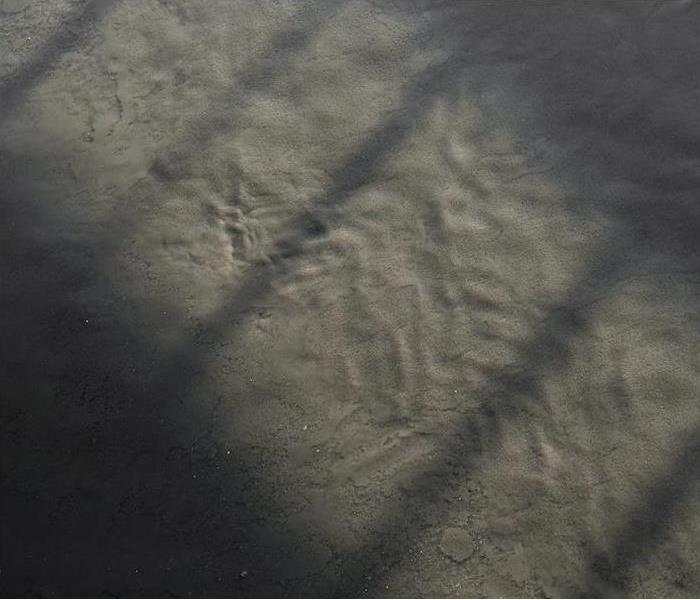 Sewage backup can be a serious problem, reach out SERVPRO of Paulding/Polk to learn more.
Sewage backup can be a serious problem, reach out SERVPRO of Paulding/Polk to learn more.
Water damage can be rough stuff in any form. Burst pipes, flooding and appliance issues all create difficult situations in their own right. But a sewage backup can be an entirely other level of both nastiness and danger.
Sewer problems can be the result of civil sewer systems that have aged past their primes, tree roots growing into sewer lines or blockages of a sanitary sewer main. Regardless of the cause, however, one thing is clear (or literally probably not clear at all)—sewer backups introduce toxins into your home, and they leave a difficult cleanup job in their wake.
When you find yourself faced with sewer damage, here are some things you should do immediately upon discovering the damage to ensure your safety and get things under control until your local SERVPRO team arrives.
Evacuate anyone vulnerable from the area. This includes seniors, children, even pets—anyone who may suffer more readily from the toxins sewage can introduce into your home’s atmosphere. Keep them safely away from the backup area until restoration is complete.
Shut off your main water supply and electricity if it’s safe to do so. If you can get to your power panel and water main safely, use them to stop the flow of water and decrease the odds of your water backup causing an electrical fire. Don’t do this if your electrical panel is under water, or if you would have to stand in water to turn it off. If you can’t safely shut off your own power and water, call your utility companies and have them do it.
Open windows in the affected area to encourage ventilation and get some fresh air flowing in.
Document your situation and take lots of photos for your insurance company. Be sure to include any items that have sustained damage, as these will be important for your insurance claim process.
Add a little bleach to standing water, if you can do so safely, so that the chlorine in it can do some disinfecting work and prevent the spread of bacteria. Don’t touch stained or affected areas, and don’t come in contact with what could be very dangerous water.
Don’t forget to call SERVPRO. We’ll be there quickly, get things cleaned and managed thoroughly, and we can work with your insurance company on your behalf.
Regardless of the cause of your sewage problem, SERVPRO has the tools and techniques to make it “Like it never even happened.”
Sewage backup is a serious problem, but we can take care of it and restore your home after the damage. Contact SERVPRO anytime to get the pros on your side.
Fires on Construction and Renovation Sites
2/2/2022 (Permalink)
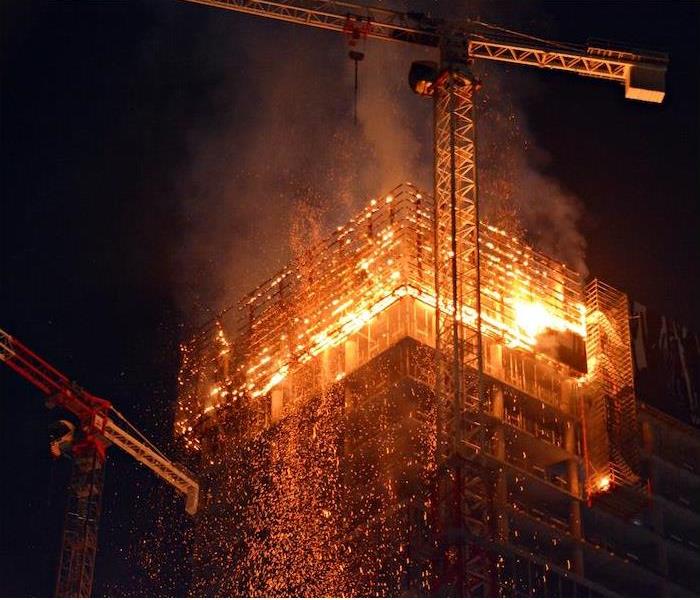 If your construction project should be hindered by an unfortunate fire, contact SERVPRO of Paulding/Polk.
If your construction project should be hindered by an unfortunate fire, contact SERVPRO of Paulding/Polk.
A 2020 report by the National Fire Protection Association gives us insight into the most common fire dangers of unfinished properties. Some of these properties are in the construction phase, and some are undergoing major renovations. The published results are the culmination of a five-year study, looking at fires of this nature from 2013–2017.
These details serve to encourage adoption and adherence to NFPA standards and codes while building and renovating, in order to avoid the added cost and time of dealing with fires as a result of code violations.
The top three causes of construction and renovation fires are in a virtual tie for occurrence percentage, though their resulting damage varies. Electrical failure or malfunction causes 15% of construction fires, while another 14% each come from abandoned or discarded materials and heat sources too close to combustible materials.
Electrical malfunction also causes 16% of civilian injuries in these types of fires, while discarded material and combustion from heat sources cause 6% and 19%, respectively. Also of note is that fires caused by heat sources being too near to combustibles causes almost one fifth of all direct property damage from construction fires.
There are a few other causes of significance, though none with quite the impact of the top three. These include welding and cutting in close proximity to flammable materials or objects, unattended equipment, failure to properly clean work areas and various misuses of materials. The combination of these add up to 26% of construction fires and 27% of civilian injuries, but only 11% of property damage from fires on construction sites.
Adherence to fire codes and proper methodologies could prevent most of these unfortunate fires, and while it’s not always the most convenient way to do this, following these well-researched, thoughtfully crafted prevention codes is the safest way to manage any construction or renovation project.
Considering fire agencies respond to more than 6,000 construction fires alone each year, this report shows us that we’ve still got some ground to make up when it comes to proper fire safety methods.
If your construction project should be hindered by an unfortunate fire, we’re here to help, regardless of the cause. Contact SERVPRO of Paulding/ Polk Counties to find out how we can help you get back on track.
The So-Called 100-Year Flood
2/2/2022 (Permalink)
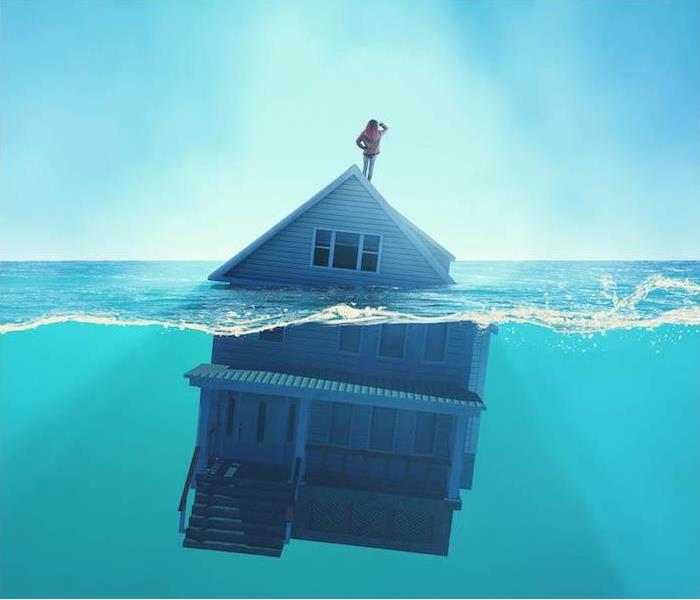 If flooding or other water damage cause trouble for your home or business, contact SERVPRO of Paulding/ Polk counties.
If flooding or other water damage cause trouble for your home or business, contact SERVPRO of Paulding/ Polk counties.
Flood probability is based on a number of factors, and scientists and engineers use a specific set of criteria to determine the likelihood that rivers may flood in heavy storms. Flooding can happen wherever it rains, and it can cause troubles like 2019’s sudden troubles in Conyers; but there’s a certain term on which much of our flood conversation hinges: the “100-year flood.”
It’s a rather foreboding term, one that definitely makes the listener aware that it’s something to be concerned about. But what exactly is it? Is it a general term, or are there actually 100-year floods we can measure and predict?
First, a 100-year flood is a very real, scientific measurement, as opposed to a general declaration like, say, a gullywasher or deluge. Without getting overly technical, a 100-year flood is, in theory anyway, a flood that statistically should only occur about once every 100 years.
In other words, based on data from nearby rivers, bodies of water, elevation levels and other factors, a 100-year flood is a flood that has a 1% chance of occurring in any given year.
This kind of flood is also known as a 1% Annual Exceedance Probability (AEP) flood.
So, does a 100-year flood only occur every hundred years? Well, yes and no. While the average space between them typically does meet that criteria, that doesn’t preclude the possibility of two 1% floods happening in back-to-back decades, years, or even months.
Flooding is unpredictable, but statistically speaking, the 100-year or 1% designation gives us a baseline for estimating the frequency and severity of a certain kind of flood.
Why does all this matter? Well, for one thing, aside from giving us a sense of how bad a flood was or could be, and how likely it may be to occur again, the 1% AEP flood is the basis for the National Flood Insurance Program, which, among other things, requires homeowners within high-risk flood zones to carry flood insurance.
So you can see why it’s important that we have both accurate flooding data and analysis as well as risk prediction. The accuracy of the portrait and prediction of 100-year floods could impact whether your home sits in a high-risk zone or not.
The 1% analysis also helps us plan things like infrastructure, drainage and building needs for flood plain areas.
The last 100-year flooding in our area came in the form of massive floods in September 2009, which resulted in half a billion dollars in damages, and actually reached the 500-year flood designation in some areas, meaning there was only a 0.2% chance of that flood occurring that year in this area.
Flooding isn’t inevitable, but it’s always a possibility when heavy storms overwhelm bodies of water or drainage systems. If flooding or other water damage cause trouble for your home or business, contact SERVPRO for fast, complete cleanup and recovery.
5 Places to Check After a Hard Rain
2/2/2022 (Permalink)
 Water damage can come from a number of places. If you find any signs of damage to your property, call SERVPRO of Paulding/ Polk counties.
Water damage can come from a number of places. If you find any signs of damage to your property, call SERVPRO of Paulding/ Polk counties.
We get plenty of rain in the Fayetteville area. The national average for a given city is 38 inches of rain per year, and we beat that average that by more than 10 inches.
Now some of that rain courtesy of your standard, near-daily summer shower. But some of it, as you well know, comes from storms that pack quite a bit more punch.
As a homeowner, it’s incumbent upon you to protect your home as much from water damage as much as possible, or at least to stop it once it’s discovered. So after a heavy rain, here are the places you should check to make sure all is well.
Check your basement. If there’s one solitary place you can anticipate water damage at home, it’s the basement. Homes with basement have a 98% chance of experiencing excess moisture or flooding at some point, so check here first. If you see water pooling, paint bubbling or you smell a damp odor, you may have an issue.
Crawlspaces and attics. Much like the basement, these areas can become inundated with moisture. If you have a crawlspace instead of a basement, it’s subject to the same kind of moisture issues, and attic moisture can reveal to you that there’s a leak somewhere in the roof.
Check on your sump pump. Your sump pump works hard to move water away from your house during a big storm. You should test your pump quarterly, or after any major rainfall.
Examine your gutters. Your gutters catch more than rain, and there are plenty of ways for them to get clogged or even damaged. In particularly heavy rains, gutters can be overwhelmed by water flow, and that becomes even more likely if they are obstructed due to built-up dirt, granules from roof shingles, twigs and leaves.
Inspect your roof. You don’t have to get up on a ladder every time it rains, but after a heavy storm, particularly if you have overhanging tree branches, take a good look at your roof from the ground. If you notice anything that looks off—broken or warped shingles, unfastened flashing or gutters that seem out of place—call a professional to conduct a full examination.
Water damage can come from a number of places at home. If you find a source of water leakage has done harm to your property, call your local SERVPRO for fast, expert help.
The Most Common Roof Problems You’re Likely to Encounter
2/2/2022 (Permalink)
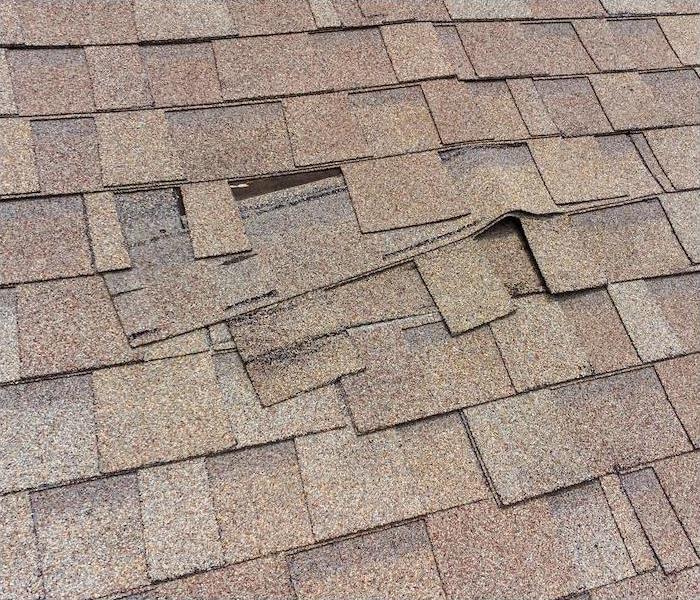 Roof care is home care, and leak prevention is the name of the game. If you find any signs of damage to your property, call SERVPRO of Paulding/Polk.
Roof care is home care, and leak prevention is the name of the game. If you find any signs of damage to your property, call SERVPRO of Paulding/Polk.
One of the sneakiest water damage sources in your home is actually on your home. Your roof regularly takes a beating from weather, sun, wind, rain and more, and it does a great job overall. If we were talking percentages, we’d be looking at Hank-Aaron-meets-Ted-Williams-type numbers.
But roofs are also one of the last places we tend to check for leaks, and thusly, one of the last places we catch leaks before they become a problem.
Make this your year to change all that. Keeping an eye on these problem areas can keep water from sneaking into your home through cracks and gaps in the roof.
Storm damage. Wind, hail and other environmental factors can damage your roof during a storm. No matter the season, your roof takes a pounding from storms, and you should always inspect your roof visually after a major storm, at the very least. If you suspect anything negative may have occurred, play it safe and let a pro examine it.
Falling branches and tree damage. Overhanging branches can crack and fall, but they can also rub away the top layer of your shingles over time as they sway with the wind. Trimming trees and being mindful of their proximity to your roof can help you avoid bad shingles and subsequent leaks.
Flashing. Your roof likely already has holes in it, but they’re the kind you have to have. Chimneys, vent pipes, skylights and even HVAC systems all come through your roof for ventilation. If the flashing is poorly installed, or if it simply wears down over time, it can cause seams in your roof and pull shingles and tiles off their proper alignment. Flashing may also need to be resealed from time to time.
Mold. Those dark streaks and patches on your roof are easy to ignore, but they’re really patches of mold—and that’s never good. There are many reasons to get rid of mold whenever and wherever you see it, but in the case of your roof, that mold can eventually eat away at your roofing material, which can let water in.
Gutters. While technically roof-adjacent, this one certainly needs attention as well. Keeping your gutters free of debris and buildup can stop water from damming up and flowing into your house by getting under your shingles.
Time. The truth is, your roof has a life expectancy, and even within that window it’s likely to develop needs that you can’t see from the ground or as an amateur. An annual roof checkup is recommended in order to keep your roof performing at its peak. A professional can identify problems that are, and some that have not yet come to pass.
Roof care is home care, and leak prevention is the name of the game. If water damage becomes an unexpected part of your home ownership experience, contact SERVPRO to get things cleaned up and restored.
Why SERVPRO Is Your Go-To for Any Restoration Needs
2/2/2022 (Permalink)
 SERVPRO of Paulding/Polk counties is ready 24 hours a day to help you with your restoration needs.
SERVPRO of Paulding/Polk counties is ready 24 hours a day to help you with your restoration needs.
Needing restoration on your home is something that can feel rather overwhelming, but eventually, it is likely to happen. From damaging severe weather incidents to leaks or kitchen fires, there are many ways that a home can sustain damage, but fortunately, there are comprehensive solutions that can help ease the complications of restoration.
To better prepare your household to deal with damages that need restoration, it is best to think ahead regarding what company you would like to use. That way, when you discover damage, you can make the call immediately to begin the restoration process.
In most cases, it is vital that restoration happens quickly—so below, we have outlined a few reasons why we are here to be your go-to.
Why to Choose SERVPRO for Your Restoration Needs
**We understand that each scenario is different.** While incidents that require restoration are quite common, every scenario is still different. For example, in spite of the fact that house fires impact more than 350,000 families each year, every fire causes damage that varies in its scope. That is why we make sure that we have the expertise to deal with damages of any type, so you can always feel confident when you call on us.
**We provide a response 24 hours a day.** When it comes to damage restoration, it is important to act fast. This is vital not only for helping your household get back to its usual state, but it is also a must to prevent further issues from arising, such as mold and mildew growth after water damage. For this reason, we are here to respond to your call 24/7, 365 days a year.
**We do more than damage restoration.** In addition to simply restoring the damage an incident has caused in your home, we also help with every aspect of the process. From helping you pack things up to dealing with your insurance agent to get the most for your claim, we aim to provide assistance in any way we can throughout the process.
*If you are in need of a go-to partner for residential restoration, you can count on us. Contact us at any hour to learn more about our process or to receive a rapid response to your damage.
The 3 Toxicity Levels of Water Damage
1/31/2022 (Permalink)
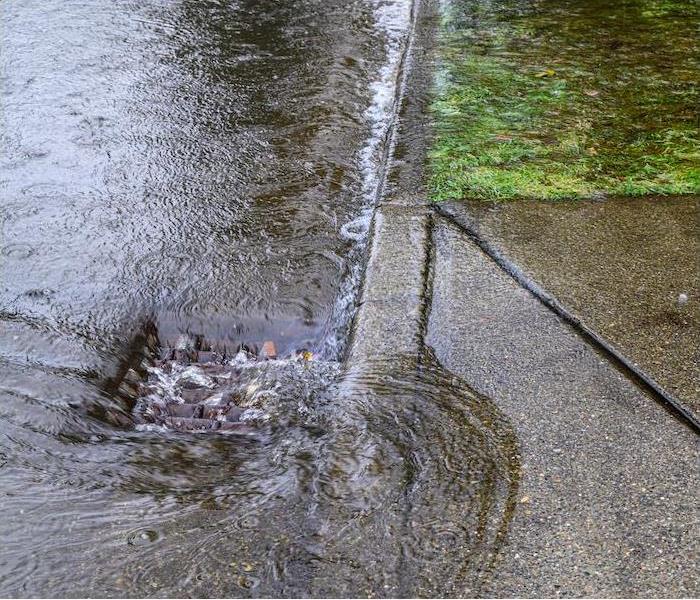 No matter the water damage, we can quickly set things right. Contact the SERVPRO of Paulding/Polk team to learn more.
No matter the water damage, we can quickly set things right. Contact the SERVPRO of Paulding/Polk team to learn more.
Water damage can happen all sorts of ways, and it can certain cause myriad problems, not the least of which is its potential for toxicity. But how do we determine which water sources are toxic and which aren’t? Why isn’t it safe to touch or swim in floodwater, but rain is fine—aren’t they the same?
These distinctions are very important, and there’s a governing body called the Institute of Inspection, Cleaning and Restoration Certification that helps us understand them.
Category 1: Clean Water Damage
Damage from so-called “clean” water is the least worrisome kind of damage, and assumes a certain level of cleanliness from its sources—typically things like refrigerators, water supply lines for appliances or even showers.
The nature of this type of damage means most of the damage mitigation involves simple drying, extracting and dehumidifying, and most instances of clean water damage don’t create health worries.
Category 2: Grey Water Damage
The next category is referred to as “grey” water. The sources of grey water include sources that aren’t inherently or necessarily toxic, but that could or may be—overflow from toilets, backups from an unfiltered sump pump, or even leaks from a washing machine which could have been holding toxic materials during the wash cycle.
Touching water from these sources may not cause immediate harm, but grey water is still to be avoided as it could cause potential danger all the same.
Category 3: Black Water Damage
“Black” water is the nasty stuff. It carries an immediate, inherent risk of toxicity, sickness or bodily harm, and it requires immediate action for removal to get these risks mitigated. Sewer backflows, broken toilet bowls containing fecal matter and other septic water fall into this category.
It may surprise you, but overflowing ground and river water fall into this category, as does flood water, because they may contain everything from waste to lawn-care chemicals and parasitic organisms. Black water can cause disease and immediate harm, and affected surfaces like carpet or sheetrock must be removed. This water is also the most difficult to deal with in the aftermath, because it requires such care in cleanup.
No matter the water damage or the level of toxicity or danger to your home or family, we can quickly set things right. Contact your local SERVPRO team today to find out how we can tackle water problems of any size or nature.
Creating Your Home’s Fire Safety Blueprint
1/31/2022 (Permalink)
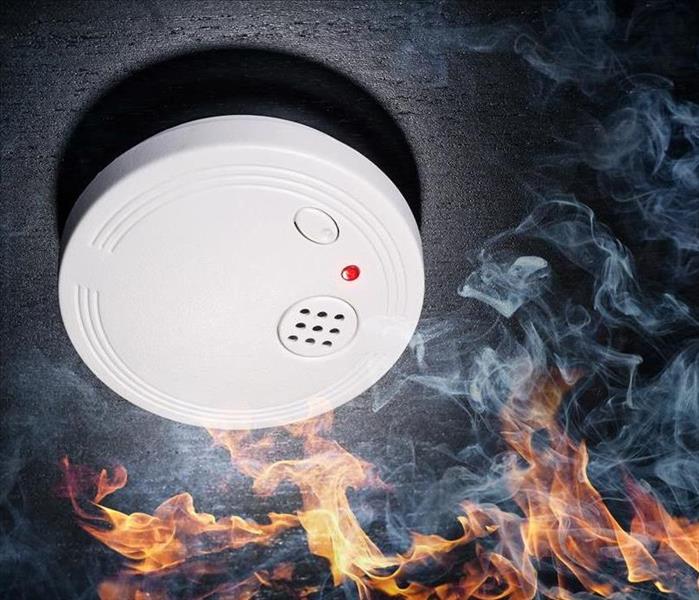 Creating a Safety Blueprint for your home is a great way to get prepared. Let SERVPRO of Paulding/Polk Counties help you make a plan.
Creating a Safety Blueprint for your home is a great way to get prepared. Let SERVPRO of Paulding/Polk Counties help you make a plan.
Increasing the fire safety of your home is a great goal. House fires can be traumatic and dangerous events, causing extensive property damage as well as injury or loss of life. However, if you have not previously considered your options for fire safety, getting into the habit of fire prevention around the house may seem like a daunting task.
The good news is that improving your home’s fire safety is ultimately quite a simple task. Once you assess where your gaps in fire prevention efforts are, you can implement simple new habits to better protect your home.
Below, we will help you identify where you could improve fire safety so you can figure out exactly what you can do to help keep your household safer from fires.
Determining Where to Improve Your Fire Safety at Home
**Consider personal safety first.** While fire prevention is quite important, the first thing you should do from a safety perspective is to consider how to protect your family if a fire does start. One of the best things you can do is install smoke alarms throughout the home and test them monthly to ensure they are operational. That way, anyone in the home will be alerted right away if a fire starts and can quickly get to safety. Additionally, you should draft a fire evacuation plan for your household and practice it regularly, so everyone is aware of what to do if the alarms do sound.
**Next, consider your daily habits.** Because many fires are started due to seemingly innocuous errors around the home, it is important to consider how your daily habits could have a role in your fire safety efforts. On average, how careful are you when cooking, lighting candles and utilizing flammable objects? Being aware of little things, like keeping flammable objects away from heat sources, can go a long way toward safety.
**Know the fire risks to watch for.** In addition to building good habits, knowing when to identify a fire risk is an important part of the puzzle. Things such as overloaded extension cords, frayed wires or space heaters being used improperly are red flags regarding fire safety—and quickly addressing them can go a long way towards prevention.
*If you have damage due to a fire in your home, you can count on us for restoration. Get in touch today to learn more about how we can help.
What to Do if You Suspect Frozen Pipes in Your Home
12/29/2021 (Permalink)
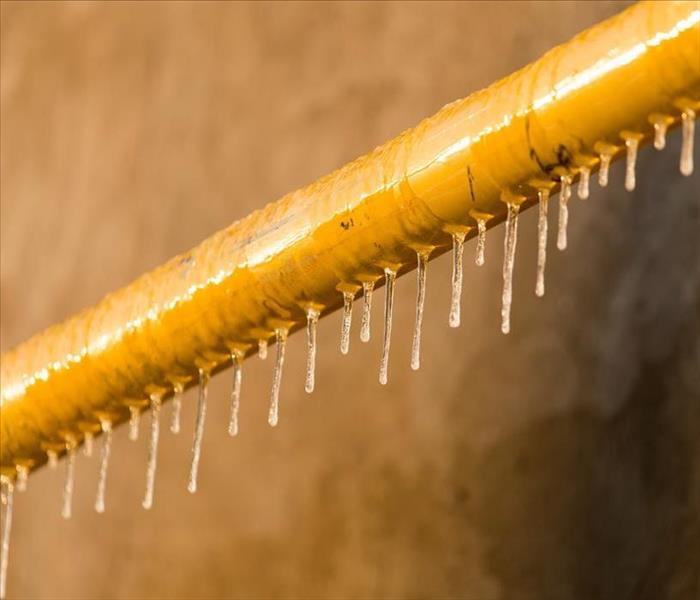 If you have water damage due to a burst pipe, you can count on SERVPRO of Paulding/Polk Counties for assistance.
If you have water damage due to a burst pipe, you can count on SERVPRO of Paulding/Polk Counties for assistance.
Having your pipes freeze in your home is more than simply an inconvenience, as it can lead to
serious water damage as well. While frozen pipes are something that many assume can only happen in areas where it gets bitterly cold, the reality is that frozen pipes can happen any time
the temperature drops below 32 degrees Fahrenheit—and may be more likely to happen to
homes in southern climates, as they are not typically constructed to withstand freezing
temperatures.
The dangerous part of frozen pipes is that they can burst when conditions are right, which leads
to serious damage—in fact, over 23% of homeowners insurance claims are related to this,
according to the Insurance Information Institute. Fortunately, if you know how to act when you
suspect your pipes have frozen, you might be able to prevent this from happening in your home.
Why Pipes Burst if They Become Frozen
Pipes that are frozen do not always burst, but they certainly can if conditions are right. If there is water frozen within the pipe, it blocks any water that is still liquid from flowing.
When this occurs, the pipe can become clogged and have pressure built up, which can
eventually lead to the pipe bursting from the force.
How to Take Action if You Suspect Your Home’s Pipes Have Frozen
Shut off the water. If you notice that the pipes in your home have frozen, the first thing you
should do is to turn off the water. That way, there will be no water entering the pipes from the
main valve, reducing the amount of water that can exit the pipes if they burst.
Thaw the pipes. If a pipe is frozen, it will generally be cold to the touch and have frost built
up on the outside, so it is easy to determine exactly where the frozen spot is. Apply heat to this area, via a hair dryer or heating pad, until the water flow within the pipe is returned to normal.
When in doubt, call a professional. If you do not feel confident thawing your pipes,
professional help may be your best bet. A plumbing service should be able to help you get your pipes thawed quickly and safely.
If you have water damage due to a burst pipe, you can count on us for assistance. Contact us
today to learn more about how our water restoration services work.
Winter Car Emergency Kit
12/29/2021 (Permalink)
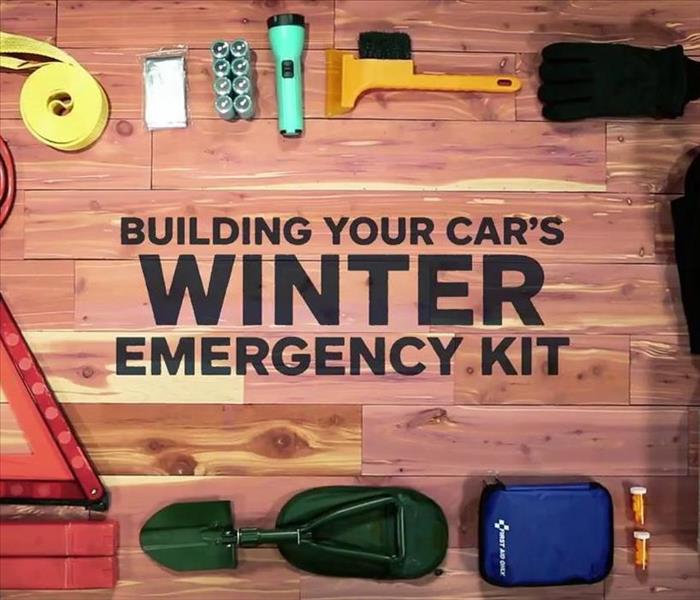 Don't get caught in the cold this winter. Make sure your car is fully stocked for any mishaps that could occur.
Don't get caught in the cold this winter. Make sure your car is fully stocked for any mishaps that could occur.
When you hear the phrase “emergency kit,” do you think of a first aid kit? A collection of supplies nestled in a closet somewhere, just in case they are needed? What about an emergency kit for your vehicle? Do you have one? Do you know what to put in one, should you decide to make one?
The NSC (National Safety Council) recommends including:
• Nonperishable, high-energy foods
• Drinking water
• Reflective vest in case you need to walk to get help
• Car cell phone charger
• Jumper cables
• Fire extinguisher
• Duct tape
• Rain poncho
• Compass
• Flashlight with extra batteries
• Cold weather items: snow brush, shovel, windshield washer fluid, warm clothing, cat litter for traction
• A properly inflated spare tire, wheel wrench, and tripod jack
• A Tool kit and/or multipurpose utility tool
• Reflective triangles and brightly colored cloth to make your vehicle more visible
• First aid kit with gauze, tape, bandages, antibiotic ointment, aspirin, a blanket, non-latex gloves, scissors, hydrocortisone, thermometer, tweezers, and instant cold compress
When assembling your emergency kit, though we’re specifically focusing on prepping for the holidays, do consider what you might need on a regular basis, and assess what you should add or remove, depending on your destination, weather conditions, or the duration of your trip. You should check your emergency kit at least every six months, and restock items that you use or that have expired.
*Source: https://www.nsc.org/community-safety/safety-topics/emergency-preparedness/emergency-supplies-for-car
*Courtesy of Restoration Newsline Vol 32, Iss 12
Thank You First Responders!
12/28/2021 (Permalink)
 Thank you to all of our first responders. You are all heroes!
Thank you to all of our first responders. You are all heroes!
SERVPRO is set to host the fourth annual SERVPRO First Responder Bowl, a great college football game honoring the everyday frontline heroes in towns and cities across the nation. This year’s game will be played Tuesday, Dec. 28, at SMU’s Gerald J. Ford Stadium, located on the campus of Southern Methodist University (SMU) in University Park, Texas. Kickoff for the contest is set for 2:15 p.m. (CT) on ESPN.
Each year, SERVPRO asks their franchisees nationwide to submit the name of a first responder in their local community to be considered for special recognition at the game. SERVPRO selects one first responder from this group of nominees to be honored with an award.
In previous years, through the generosity of corporate partners, the SERVPRO First Responder Bowl has been able to provide thousands of free tickets for first responders to attend the bowl game with their families.
“SERVPRO professionals deal with the aftermath of the unexpected every day,” said Rick Isaacson, CEO of SERVPRO Industries, LLC, “but first responders deal with the unexpected when it’s happening. They are first on the scene, putting themselves in harm’s way to protect people and property. The SERVPRO First Responder Bowl is our opportunity each year to say ‘thank you’ on a national stage to these brave men and women – and their families – who set an example of courage and sacrifice for all of us.”
Is Water Damage More Common in the Winter?
12/22/2021 (Permalink)
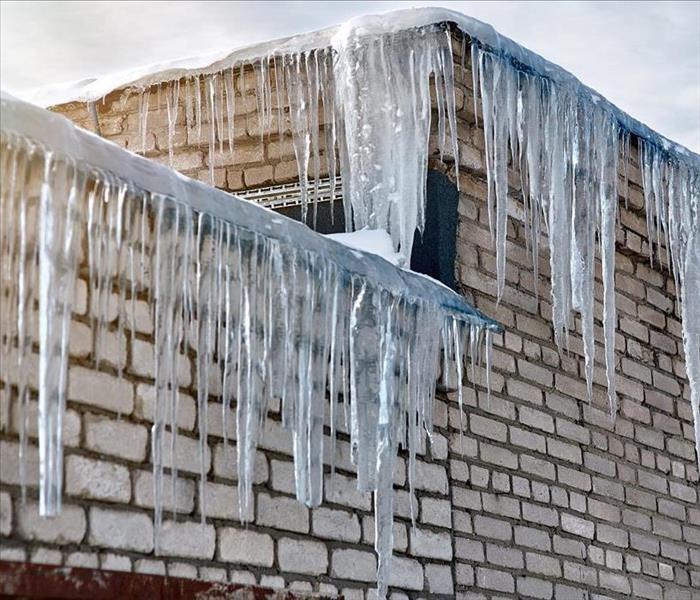 If you discover water damage to your home, you can count on SERVPRO of Paulding/Polk Counties to help.
If you discover water damage to your home, you can count on SERVPRO of Paulding/Polk Counties to help.
Water damage is something that can occur at different times of the year for different reasons.
Spring downpours can cause leaks, summer storm damage can cause roof damage and fall
conditions can lead to standing water around the house.
However, water damage can occur in winter, too—and while most causes of winter water damage are preventable, if you do not do the prevention work ahead of time, it may turn into a major issue later on.
Fortunately, understanding the common causes of winter water damage can help you prevent
them. Read on to learn the typical reasons that water damage occurs in the winter and how you
can prevent these issues from popping up around your home.
Why Water Damage Occurs in the Winter Months
Freezing pipes that burst. While frozen pipes are typically a concern in areas that get far
colder than Georgia, it is not impossible for them to happen here—especially for the pipes leading to outdoor spigots that may be more exposed. Be sure to disconnect your hoses and drain water from your spigots before freezing weather becomes the norm to prevent this.
Gutters that are blocked with autumn leaves. The autumn leaves are beautiful, but if you live in a home with a lot of tree coverage, they can be a nightmare for your gutter drainage system. It is advised to clean out your gutters at least twice a year anyway, so it makes sense to do this before winter begins to ensure water can drain away quickly. Clogged gutters can damage the roof line and the foundation, and even lead to ice dams when the weather is quite cold.
Unaddressed roof leaks. For obvious reasons, most of us are spending less leisure time outside during the winter months, which means the odds of catching something that is amiss are lower. Roof leaks are a year-round concern, but you may be less likely to notice damage in the winter. Now is a good time to give everything a thorough once-over with binoculars to make sure things are looking good.
If you discover water damage to your home, you can count on us to help. Get in touch at any hour to learn more about our service options.
A Checklist for Making Your Home More Resilient to Storms
12/20/2021 (Permalink)
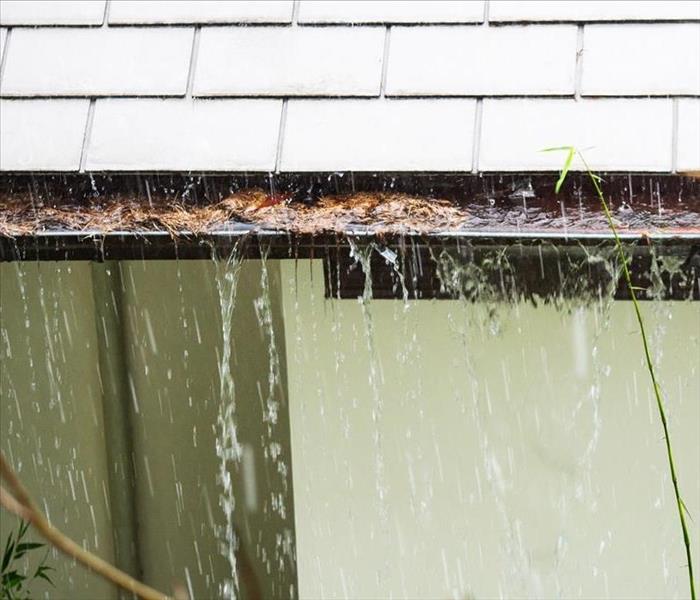 If your home is damaged due to a storm, get in touch with SERVPRO of Paulding/Polk Counties to learn more about our 24/7 restoration service options.
If your home is damaged due to a storm, get in touch with SERVPRO of Paulding/Polk Counties to learn more about our 24/7 restoration service options.
Severe storms are something that we have no control over, but their occurrence is inevitable.
While many of these severe storms will pass without incident, plenty of others will cause serious damages—and this is something that homeowners should be sure they are well aware of. Severe storms typically involve high winds, heavy rains, lightning and sometimes even hail and tornado risks, all of which can cause problems to your home.
Fortunately, there are ways that homeowners can prepare themselves for severe weather and
reduce the damage that a storm could potentially cause their home. While there is no way to
harness Mother Nature, there are ways that homeowners can make their homes more resilient
to the potential for damage.
Home Maintenance Items That Can Prevent Storm Damage
Cleaning out your gutters. Cleaning your gutters regularly is a good household chore for
several reasons, including the fact that it can prevent water damage from occurring in your
home. Clearing gutters and downspouts of leaves and debris can ensure that water can drain
away adequately, which means that if heavy rains do come through the area, your home will be
less likely to incur water damage.
Secure outdoor objects. Smaller outdoor items, such as patio furniture, planters and garden
tools, can easily become projectiles when high winds or tornado conditions come through an
area. It is wise to secure these items ahead of time so you do not run the risk of them crashing
into a window or causing damage to the exterior of your home if they are carried away in a storm.
Be sure you know where your gas, water and electricity shut-offs are. In the event of severe weather conditions, officials may instruct households to shut off their gas, water and/or
electricity mains if it is safe to do so. If you already know where these shut-offs are located, you can better assess if it is safe for you to access them should officials advise you to do so when severe weather strikes.
If your home is damaged due to a storm, you can depend on us. Get in touch at any hour to
report damages or to learn more about our 24/7 restoration service options.
Fire Safety Myths About the Festive Season
12/20/2021 (Permalink)
 If you experience a holiday house fire, you can count on SERVPRO of Paulding/Polk Counties 24/7, 365 to begin your fire restoration process.
If you experience a holiday house fire, you can count on SERVPRO of Paulding/Polk Counties 24/7, 365 to begin your fire restoration process.
Fire safety is something that is always important for a household to practice, but did you know
that some seasons tend to be more dangerous than others? Winter is the most common time of
year that a house fire will break out, and there are many reasons why this could be the case.
Part of the reason why fires are so common during the wintertime has to do with the way we
celebrate the holidays. From dangerous décor to cooking conundrums, there are a lot of
opportunities to let fire safety lag when the Christmas season rolls around.
If you have not considered how to be fire-safe during this festive time, read on as we dispel
myths that might be hazardous.
Dispelling Fire Safety Myths for the Holidays
Fake Christmas trees are a fire hazard. While fake Christmas trees might be flammable, real
Christmas trees are actually a much larger fire hazard. While they certainly can be used safely,
it is vital to water the tree every day, avoid putting it near any heat sources and never allow it to be near an open flame. Dried needles are extremely combustible, so exercising caution is key.
Christmas lights are a safe alternative to candles. Before electricity, candles were a common form of Christmas decoration. While lights are certainly a safer alternative, lights can be dangerous, too. Strands that are frayed or damaged can spark and cause a fire, and plugging in too many lights together can be a serious fire hazard, too. While Christmas lights are much safer than candles for decoration, they still have their own dangers that should be considered.
It is safe to leave lights on overnight. While having your house decorated for the holidays is
an exciting thing, it is important that you do not leave your electric decorations on when they will
be unattended. Always unplug lights before going to sleep or leaving the house—if a fire were to
begin due to your lights, this would prevent it from happening at a time where it is more likely to go unnoticed by you and your household.
If you experience a holiday house fire, you can count on us. We are here 24/7, 365 to begin your fire restoration process. Contact us today to learn more about the services we offer.
Why Preparing for a Disaster Makes Good Business Sense
12/20/2021 (Permalink)
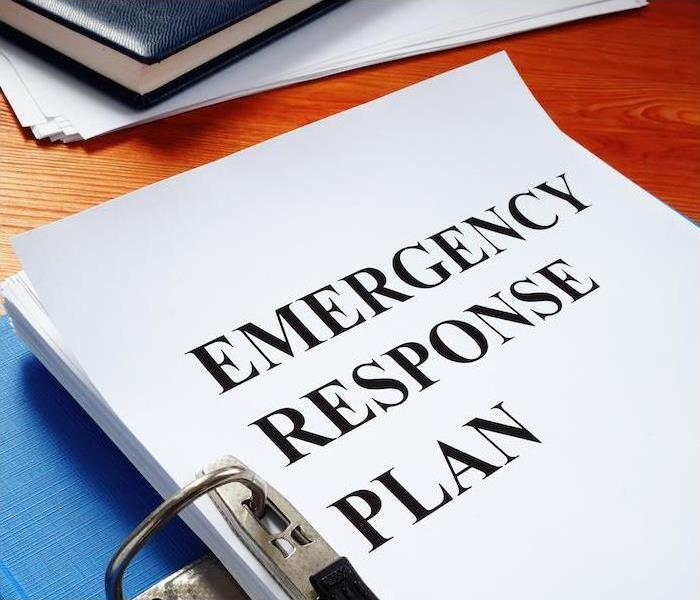 If your business is damaged in a disaster, Contact SERVPRO of Douglasville. We are here to guide you through the process.
If your business is damaged in a disaster, Contact SERVPRO of Douglasville. We are here to guide you through the process.
There are many things that business owners must think about throughout their day-to-day operations, and for many of them, adding something extra onto this task list may seem impossible.
While this is understandable, when it comes to preparing for a disaster, it is imperative that business owners make the time to consider it. Many businesses do not get the chance to recover from a disaster, and while you can’t plan for everything, it is important to prepare for what you can.
Not only will disaster planning help you and your employees stay safer in advance of and during a disaster, but it also makes good businesses sense. Disaster recovery can be too difficult for businesses who have not prepared, rendering them unable to reopen. However, by thinking ahead and utilizing your resources, you can reduce the likelihood that this scenario will happen to you.
How Disaster Preparedness Helps a Business’ Bottom Line
You can quickly pursue restoration to prevent further damage. When you know which commercial restoration company you will work with, you are at an advantage, as you can immediately place the call to them once you discover damage at your business. This gets you in the queue faster, so you can receive a rapid response and prevent more damage from occurring in the meantime.
You can utilize your resources efficiently. After a disaster is declared, the Small Business Administration provides loans for business owners to help with the cost of recovery. If you know about these options in advance, you can apply right away when the time comes to receive these funds as quickly as possible.
You can lessen the time of closure. It is to be expected that you will have to close your doors for at least a bit while you have the damage restored and prepare to resume operations again, but by planning ahead, you can significantly reduce this time. By making your recovery as efficient as possible, you can get your doors reopened quickly so you can continue to do what you love.
If your business is damaged in a disaster, we are here to help you. Contact us about commercial restoration 24⁄7 to learn more or to report damages to your business after a disaster.
Routine Maintenance That Can Make Your Home More Resilient to Storm Damage
12/15/2021 (Permalink)
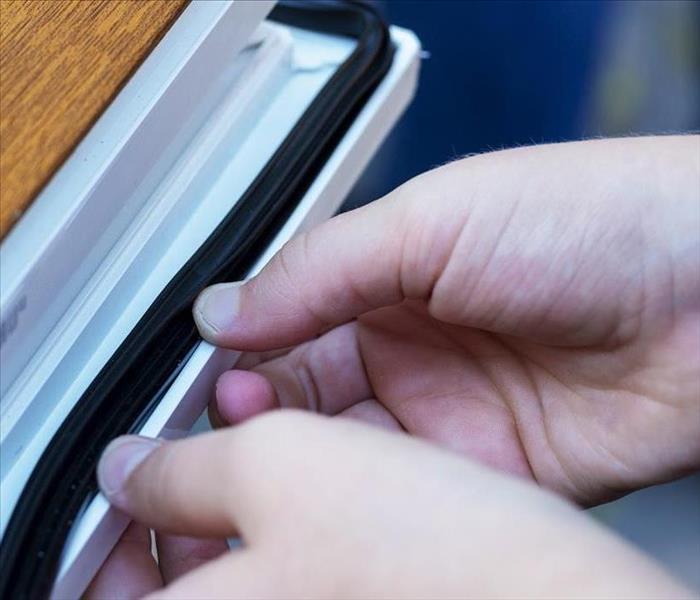 If you have damage due to a severe storm, you can count on SERVPRO of Paulding/Polk Counties to help you in the aftermath.
If you have damage due to a severe storm, you can count on SERVPRO of Paulding/Polk Counties to help you in the aftermath.
While severe weather is an unpleasant thing to be threatened with at your home, it is an inevitable occurrence. Severe weather is more common during the hot and humid summer months, but heavy rains and high winds can occur at any time—and can bring serious damage along with them.
Keeping yourself and your family safe is of the utmost priority during severe weather, but in
addition to this, there are also measures you can take to keep your home safer, too. While no
task is a certain way to prevent damage to your household, there are some routine home
maintenance tasks that will actually reduce the likelihood that a storm could cause damage to
your home. Read on to learn more!
Home Maintenance Tasks for Storm Damage Prevention
Address any leaks right away. Leaks throughout the home can be rather sneaky, but if you have a feeling that water is creeping into an area it should not be, make sure to tend to it well in advance of a period of heavy rain. Basements and crawl spaces are common places for leaks to
hide, but it would be good to regularly check your attic and around your roof line for signs of water entry, too.
Add weather-stripping around windows and doors. Water can work its way into the tiniest of
gaps, and if you are getting heavy rain as part of severe weather, you may be at risk for developing leaks around your windows and doors. Adding weatherproofing around any exterior doors and windows can help prevent leaks from starting even during the heaviest of rains.
Be sure you have plenty of flashlights and batteries. Next time you make a trip to the
hardware store, it may be wise to add flashlights and batteries to the list. Power outages are
extremely common when severe weather strikes, so making sure you have plenty of flashlights
and their corresponding batteries can help you be sure you have plenty of visibility in the dark
just in case the power goes out.
If you have damage due to a severe storm, you can count on us to help you in the aftermath.
Contact us at any hour to report damages or to learn more about our storm damage restoration
process.
Keeping Track of Fire Safety at Your Business
12/15/2021 (Permalink)
 If you are dealing with the aftermath of a fire at your business, contact SERVPRO of Paulding/Polk Counties.
If you are dealing with the aftermath of a fire at your business, contact SERVPRO of Paulding/Polk Counties.
For business owners, there are few things more important for the safety of you and your staff
than ensuring you have the right fire protections in place. Fires can be absolutely devastating for
businesses, with over half never being able to recover after the damage—but fortunately, there
are plenty of ways to decrease the likelihood that you will ever experience a fire at all.
All businesses are subjected to certain fire codes set forth by the National Fire Protection
Association, which provide a great guideline for making sure you are being as safe as possible.
In addition to adhering to fire codes when you are first starting out, it is also important to make
sure you are regularly auditing your fire safety efforts to be sure nothing slips through the
cracks. Below, we have listed out some helpful tips for doing just that.
Keeping Track of Your Fire Prevention Efforts in the Workplace
Make sure you have enough (working) fire extinguishers. It is required that all commercial
spaces have fire extinguishers on the premises, though how many and where they are located will vary depending on your specific situation. That being said, it is important to check your fire
extinguishers regularly—while they do have a long shelf life, there will be an indicator on each
one that will let you know if it is time to be replaced.
Check or install commercial sprinkler systems. While not every business is required to have a sprinkler system, they can be a great investment for any commercial space. Sprinkler systems are extremely effective at stopping fires quickly, so even if your business is not technically
required by codes to have them, it might be worth considering having a sprinkler of some sort
put into place.
Be sure you are reviewing fire safety with your staff. Fire safety efforts are great, but if your staff is ill-prepared for a fire, they can be all for naught. Make sure you are regularly going over fire routes, fire exits, evacuation protocols and fire extinguisher use with your staff. That way, everyone will know exactly how to take action in the event that a fire begins, which can eliminate confusion in a panicking situation.
If you are dealing with the aftermath of a fire at your business, you can depend on us. Contact
us today to learn more about our fire restoration services.
Fall Fire Safety
10/6/2021 (Permalink)
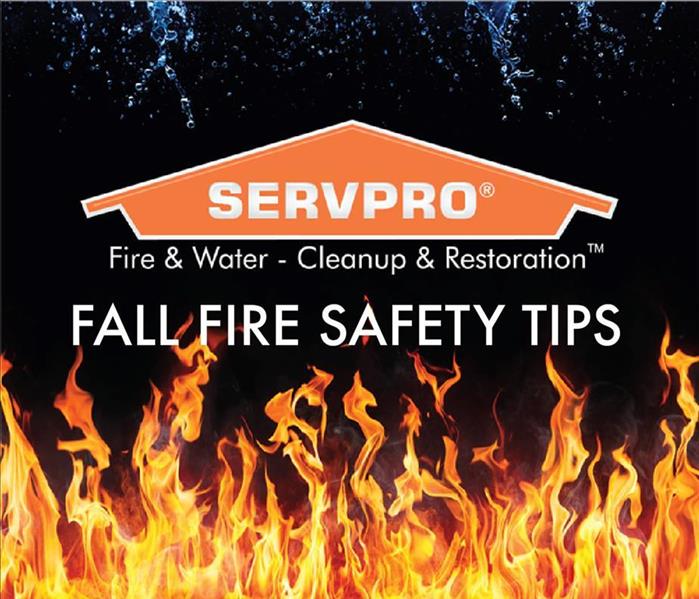 Trust the experts at SERVPRO of Paulding/Polk Counties should you have fire damage at your home or business.
Trust the experts at SERVPRO of Paulding/Polk Counties should you have fire damage at your home or business.
The fall season brings cooler temperatures, beautiful colors, and an abundance of outdoor activities. Plan ahead this season to help ensure it is safe from potential fire hazards.
According to the National Fire Protection Agency, cooking fires are the number one cause of home fires and injuries. The leading cause of fires in the kitchen is unattended cooking. Here are some helpful hints when cooking your fall family dinners.
• Stay in the kitchen while you are frying, grilling, boiling, or broiling food.
• If you are simmering, baking, or roasting food, check it regularly, remain in the kitchen while the food is cooking, and use a timer to remind you that you are cooking.
• Keep anything that can catch fire, like oven mitts, wooden utensils, food packaging, or hand towels, away from the stovetop.
If you have a cooking fire, consider the following safety protocols to help keep you and your family safe.
• Just get out! When you leave, close the door behind you to help contain the flames.
• Call 911 or the local emergency number after you get out safely.
• For an oven fire, turn off the heat and keep the oven door closed.
• If you try to fight the fire, be sure others are getting out and you have a clear path out.
• Keep a lid nearby when you’re cooking to smother small grease fires. Smother the fire by sliding the lid over the pan and turn off the stovetop. Leave the pan covered until it is completely cooled.
If you are doing any outdoor cooking around a fire pit, consider the following to keep it a fun, but safe time for all:
• Check the wind conditions prior to starting the fire. Wind can make it hard to light the fire or blow embers around to surrounding brush or structures.
• Always have a fire extinguisher or water source nearby, like a water hose or water bucket.
• Never leave the fire unattended.
• Keep all children and pets at least three feet from the fire.
Family Fire Escape Plan
10/6/2021 (Permalink)
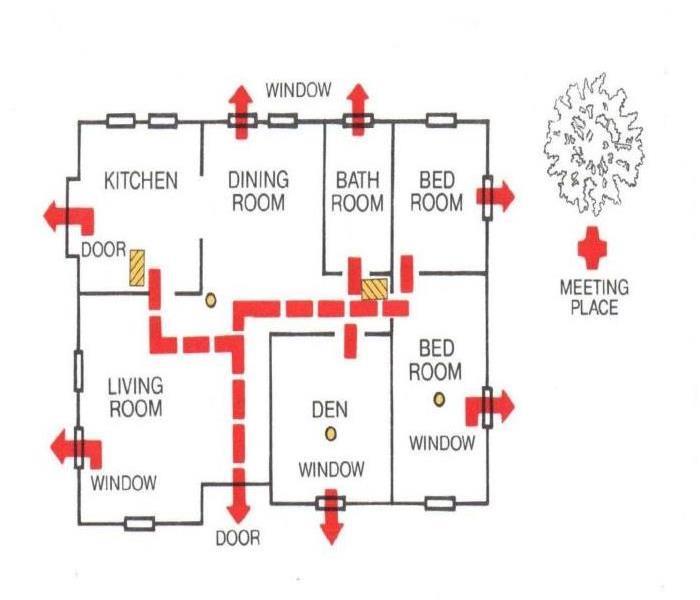 Take all the necessary steps to prepare your family for a potential fire. Minutes of preparation now can save a life when it matters most.
Take all the necessary steps to prepare your family for a potential fire. Minutes of preparation now can save a life when it matters most.
Fire can spread rapidly through your home, leaving you as little as one or two minutes to escape safely once the smoke alarm sounds.
To make the most of what little time you have, be proactive and establish a fire escape plan. Having a plan in place and practicing that plan will ensure everyone knows where to go when disaster strikes.
As a family, walk through your home and look at all possible exits, doors and windows. Create a map of your home, so everyone can visually see two ways out of every room, a primary and secondary evacuation route.
As you develop your family escape plan, consider the following steps, provided by the National Fire Protection Association (NFPA):
- Install smoke alarms in every sleeping room and outside every sleeping area on every level of the home.
- Walk through your plans with the family, making sure everyone can access the exits easily.
- Set an outside meeting point for the family once they've escaped.
- Once you're out, stay out and wait for help to arrive, do not go back into the burning structure.
Once you have a plan in place make sure all your fire safety supplies are in place and up to date. Smoke detectors need to be replaced every 10 years, also replace the batteries in your smoke detectors every six months. Fire extinguishers need to be replaced every 12 years. Make sure you have fire extinguishers in the necessary areas of your home, the kitchen, utility rooms, garage, etc.
If your home has two floors, an escape ladder is a necessity for the safety of your family. Practice setting up the ladder from a first-floor window, so everyone knows how to do it safely. Escape ladders can be placed near the windows on the second floor, providing additional escape options. You don't want to be searching for it during a fire.
Take all the necessary steps to prepare your family for a potential fire. Minutes of preparation now can save a life when it matters most.
*Restoration Newsline Vol 32, Iss 10
Protecting Your Property Against Vandalism
9/20/2021 (Permalink)
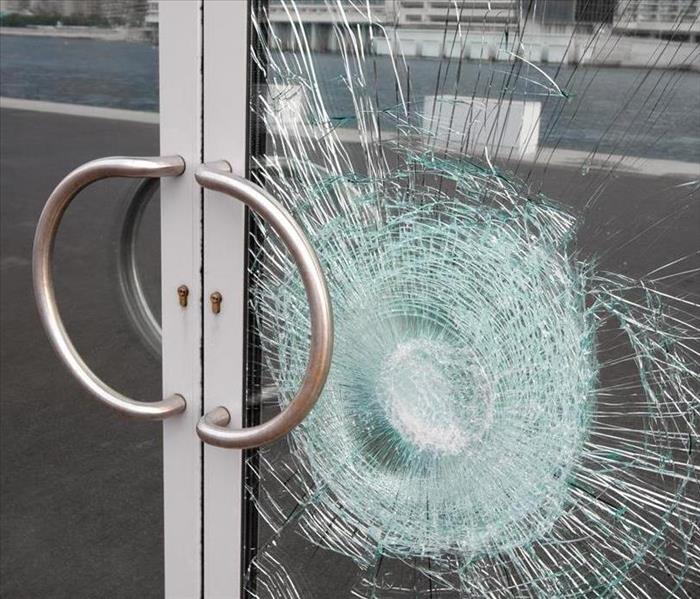 Trust SERVPRO of Paulding/Polk Counties is ready to help you clean up should your business experience damage from vandalism.
Trust SERVPRO of Paulding/Polk Counties is ready to help you clean up should your business experience damage from vandalism.
Virtually all business properties are subject to vandalism. Vandals can strike anywhere: in cities, suburbs, and rural areas. Fortunately, there are steps businesses can take to discourage vandals from targeting their property.
What Is Vandalism?
While the definition of vandalism varies from state to state, the term generally means the intentional damage, destruction or defacement of someone's property without the owner's permission. Vandalism is a criminal act and is prohibited by state laws. It may qualify as a misdemeanor or a felony, depending on the amount of financial damage that's involved. Some states refer to vandalism as criminal mischief or malicious mischief.
Why and Where It Occurs
People may commit acts of vandalism for a number of reasons. Here are some of them:
- Punish a business or industry
- Express frustration
- Communicate an ideology or political beliefs
- Express hate
- Show off artistic skills
- Express gang affiliations
Vandals may target buildings, personal property or both. According to the Urban Institute, vandals typically strike in the late evening when business property is unattended. Juvenile offenders may commit acts in the afternoon after school has let out.
Vandals often target public or semi-public property like buses, train stations, and street signs. Such property is easy to access and is often poorly protected. Vandals may also hit private property that's in close proximity to public areas.
Effects of Vandalism
Vandalism can impact your business in a number of ways. First, it can damage your property. Damaged or defaced property requires time, effort, and money to repair. Secondly, vandalism may cause your business to lose income if the vandalized property cannot be used and is essential to your operations.
Thirdly, graffiti, trash, and other types of defacement can have a negative effect on your company's image. Such damage can deter potential customers from entering your premises. Fourthly, vandalism can lower the value of your property. Property that has been damaged or defaced may be unattractive to potential buyers or tenants. Finally, some types of vandalism, such as broken windows, can cause bodily injury to employees or visitors.
Preventing Vandalism
While you cannot prevent all acts of vandalism, you can discourage vandals from striking your property by taking the steps outlined below. Additional suggestions for thwarting vandals are available from the Urban Institute's website.
- Keep property tidy. Keep your premises clean, tidy, and free of trash. Disorder attracts vandals.
- Maintain good lighting. Make sure your property is well-lit at night. Check light bulbs regularly.
- Install cameras. Install video cameras to monitor activity on your premises. When crimes have occurred, police can use your recorded video to catch the perpetrators.
- Consider shrubbery or fencing. Fencing or shrubbery can discourage vandals from entering your property. Shrubs that have prickly or scratchy leaves like holly and pyracantha can help keep intruders away.
- Consider break-resistant glass. Glass that is break-resistant or coated with security film is stronger than regular glass and difficult for vandals to penetrate.
- Don't ignore it! Vandalism tends to beget more vandalism and can encourage other types of property crimes. Thus, you should make repairs and remove graffiti promptly. Your quick response shows that you care about your property and won't tolerate its defacement.
- Contact authorities. The police department can't respond to crimes it isn't aware of. Report all vandalism to your local police department. The department may increase patrols in your area or create a hotline for reporting incidents.
- Share information. Ask other business owners in your area if they have experienced acts of vandalism and share the information you collect with other businesses. The information may reveal patterns. For example, vandals may be striking at certain times of the day or on certain days of the week.
- Join a business watch group. Business watch groups are similar to neighborhood watch groups. Group members work to reduce crime by keeping an eye on each other's property. If no watch group exists in your area, you can start one yourself. Tips on how to do this are available from the National Neighborhood Watch website.
Property Insurance
Most commercial property policies purchased by small business owners cover "all risks," meaning they cover damage caused by any peril that's not specifically excluded. These policies rarely exclude vandalism, so this peril is covered. Most named perils policies also cover vandalism.
Most all-risk policies don't define the term vandalism. This word is defined in many named perils forms. In the ISO named perils forms, vandalism means willful and malicious damage to, or destruction of, the described property.
Two perils that may occur in conjunction with vandalism are riot and civil commotion. These perils are normally covered under both named perils and all-risk property forms. When people commit violent acts during a civil disturbance, they often target business-owned property. Property that has been vandalized by rioters may be subject to looting. Looting is normally covered in conjunction with riot and civil commotion.
Vacant Buildings
Vacant buildings are highly prone to vandalism. Consequently, many property policies contain a vacancy provision like the one found in the ISO property policy. It eliminates coverage for losses caused by vandalism (and several other perils) if the building has been vacant for more than 60 consecutive days.
The meaning of vacant varies depending on whether the insured is a tenant or a landlord. If the insured is a tenant, the unit or suite rented by the policyholder is considered vacant if it doesn't contain enough business personal property for the insured to conduct its ordinary operations. If the insured is the building owner, the building is vacant if less than 31 percent of it is being used by the owner or a tenant to conduct its customary operations. The vacancy provision appears in the policy conditions.
If a building you own or rent will be vacant for more than 60 days, ask your insurer for an endorsement called a Vacancy Permit. This endorsement suspends the vacancy clause for a period of time. It may be available only if you verify that the building is adequately protected from vandals, freezing, and other perils.
Wet or Dry Sprinkler Systems: Which is Right for your Business?
9/18/2021 (Permalink)
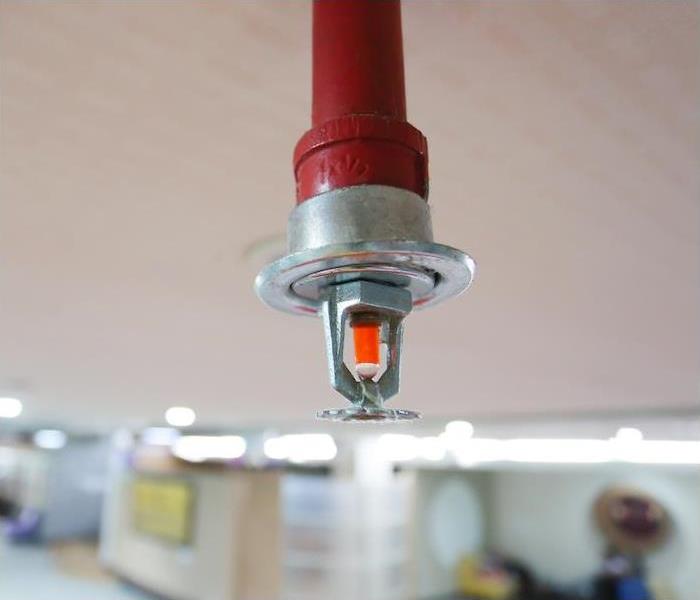 Trust the professionals at SERVPRO of Paulding/Polk Counties to help your business reopen following a fire disaster.
Trust the professionals at SERVPRO of Paulding/Polk Counties to help your business reopen following a fire disaster.
While there are many sprinkler system types, the two most commonly used are wet and dry sprinkler systems. Fire Systems, Inc. repairs, installs, and inspects all types of sprinkler systems for commercial businesses in Atlanta and the state of Georgia. Fire Systems can help you choose which sprinkler system is best for your fire protection needs.
Wet vs. Dry Pipe Sprinkler Systems
Both wet and dry sprinkler systems extinguish fires using water, just in different ways.
In a wet system, the pipes are filled with pressurized water. When a fire occurs, the system immediately discharges water to extinguish the fire.
Conversely, dry systems are filled with pressurized nitrogen or air that keeps water at a riser. When a dry sprinkler system goes off, the pressure in the pipes drops, a valve opens, and water flows through the pipes and out to extinguish the fire.
Wet Sprinkler Systems
The sprinkler heads in a wet system are connected to pipes that are filled with water. The system automatically goes off when a fire is detected. Wet sprinkler systems are the number one choice for most businesses because they’re simple to use and require little maintenance. This system type is also very reliable since the water is automatically dispersed when a fire occurs.
Dry Sprinkler Systems
Sprinkler heads in a dry sprinkler system are connected to pipes that are filled with pressurized nitrogen or air. The gas or gas holds back water until a fire is detected.
Dry systems are the second most commonly used system. They are ideal for unheated buildings, parking garages, and warehouses since these types of properties can experience temperatures below 40°F (4.44 °C). Dry systems are also recommended for protecting areas that store sensitive equipment to minimize damage.
When Storms or Floods Hit, SERVPRO of Paulding/Polk Counties is Ready!!
9/18/2021 (Permalink)
SERVPRO of Paulding/Polk Counties specializes in storm and flood damage restoration. Our crews are highly trained and we use specialized equipment to restore your property to its pre-storm condition.
Faster Response
Since we are locally owned and operated, we are able to respond quicker with the right resources, which is extremely important. A fast response lessens the damage, limits further damage, and reduces the restoration cost.
Resources to Handle Floods and Storms
When storms hit Paulding/Polk Counties, we can scale our resources to handle a large storm or flooding disaster. We can access equipment and personnel from a network of 1,650 Franchises across the country and elite Disaster Recovery Teams that are strategically located throughout the United States.
Have Storm or Flood Damage? Call Us Today 770-505-0555
Dispelling Myths About Lightning Strikes
9/13/2021 (Permalink)
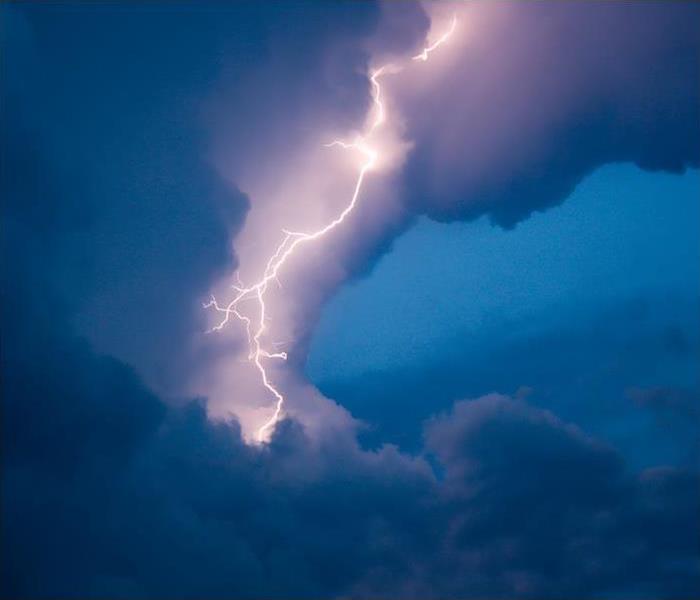 If you have damage due to a storm or lightning strike, SERVPRO of Paulding/Polk Counties are here to help.
If you have damage due to a storm or lightning strike, SERVPRO of Paulding/Polk Counties are here to help.
Lightning is an extremely common weather occurrence, but it is also an event that is typically
misunderstood. Every single thunderstorm contains lightning (in fact, lightning is actually what causes thunder), which means every single thunderstorm presents the risk for injuries and fires due to lightning strikes.
Though lightning strikes frequently, there are many persistent myths about its dangers, its
behaviors and its deterrents, which we will be dispelling below.
Lightning Myth 1: If It Is Not Raining, You’re Safe
Lightning is an extremely powerful force and has been known to strike up to three miles from a
storm’s center—meaning you can be far away from the rain and even the cloud cover and still
be threatened by lightning.
Lightning Myth 2: It Will Only Strike the Tallest Object
Lightning is not logical in its approach, and it will often strike objects that are much lower than
those around them. Lightning has been known to strike the ground next to a tree or a car next to
a house, so it is impossible to predict exactly where it will land.
Lightning Myth 3: Lie Flat on the Ground if You Can’t Find Shelter
While lying flat on the ground may seem like it would make you less of a target in a
thunderstorm, it is actually an extremely dangerous position to put yourself in. When lightning strikes, it can produce major electrical currents that can run through whatever it has hit—so if it strikes the ground, you can put yourself at risk for electrocution if you are lying down.
Lightning Myth 4: A Car’s Tires Will Protect You From Lightning
While sheltering in a car is not the worst thing you could do in a storm, the safety it provides has nothing to do with the rubber car tires. If lightning strikes a car, the car’s metal body will divert the lightning away from the passengers and pass it through to the ground. This also means that if you are in a vehicle with a fiberglass construction (such as an RV), it does not offer adequate protection.
If you have damage due to a storm or lightning strike, we are here to help. We can help with
water damage, fire damage and more—contact us today to learn all about our services.
Destroy Odors with Deodorization
9/13/2021 (Permalink)
Even a small fire can cause odors for years to come if the affected areas are not properly cleaned and deodorized. Fire, smoke and soot damage in your home or business can create unpleasant and potentially permanent problems.
As various materials burn, the smoke produced travels throughout the structure, leaving odorous residues and deposits on surfaces and in hard-to-reach places. Unless fast, professional action is taken, these residues and deposits can cause permanent damage to contents and may result in resurfacing odors.
With technicians certified by the Institute of Inspection, Cleaning and Restoration (IICRC), SERVPRO® of Paulding/Polk Counties professionals provide specialized services that can rid your home or business of offensive odors left by fire or smoke damage. SERVPRO® of Paulding/Polk Counties professionals do not cover up lingering odors with a fragrance; they seek out and remove the source of the odor. Once the source is found, SERVPRO’s own proprietary line of cleaning products is used to treat and prevent the odor from returning. Any restorable item in affected areas will also be professionally cleaned and deodorized, including furniture, draperies and upholstery, electronics, art, flooring, walls, ceilings, HVAC air ducts and more.
Ask SERVPRO® of Paulding/Polk Counties to explain the various deodorization methods available and which will work best for you.
If you or a customer suffer a fire damage or some other accident and require deodorization services, contact SERVPRO® of Paulding/Polk Counties. Whether it’s fire, water, or mold damage or just a stubborn odor that refuses to go away, we’ll help make it “Like it never even happened.”
Lightning Safety for Outdoor Workers
9/1/2021 (Permalink)
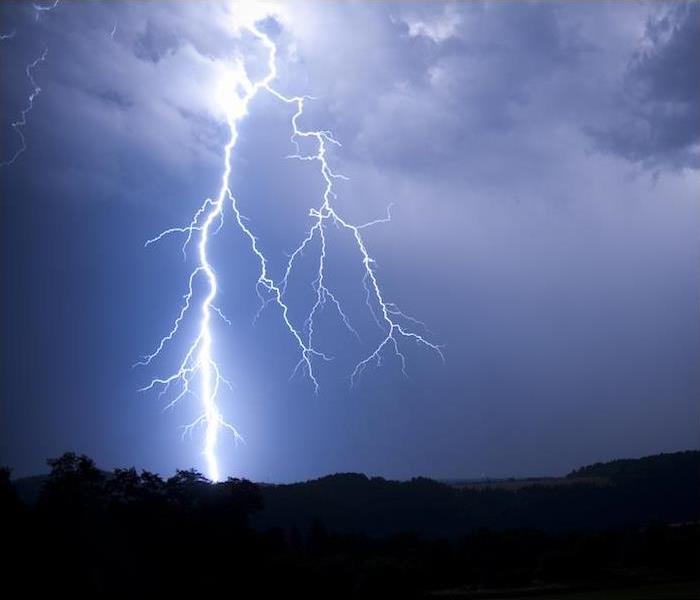 SERVPRO of Paulding/Polk Counties here to help with any damage done by thunderstorms, whether it be from water, fire or lightning.
SERVPRO of Paulding/Polk Counties here to help with any damage done by thunderstorms, whether it be from water, fire or lightning.
Lightning as an occupational hazard is often an afterthought, but it shouldn’t be. An average of 47 of all occupations require outdoor work at some point in the day.
That means almost half the American workforce is outside for some period of time every day, and many fields require a much higher percentage of outdoor time. When thunderstorms arise, those workers are at elevated risk of lightning strikes and other dangers.
Safety Best Practices for Outdoor Work
OSHA and NOAA recommend several broad safety practices for business who have workers outdoors. These include:
Being informed by NOAA weather reports. Employers and supervisors should be aware of reported and upcoming weather events before sending workers outside. Weather.gov and local outlets will make weather updates as inclement weather comes toward the area. Employers should consider rescheduling events, jobs or activities outdoors if thunderstorms are headed in. Darkening clouds and increased wind speeds can also be indicators of dangers weather afoot.
Seeking shelter in buildings. Workers should be informed before heading to outdoor jobs what nearby buildings they should seek out for shelter if they hear thunder or see lightning. These buildings should be fully enclosed and outfitted with plumbing and electricity. Once inside, workers should remain indoors at least a half hour after the last peal of thunder before returning to work. Remember, the fact that you’re not getting rained on doesn’t mean you’re not in danger—lightning can strike up to 10 miles away from the nearest rainfall.
Using vehicles as a second option. If safe buildings aren’t accessible, workers should be guided to hard-top vehicles with all windows rolled up, where they should remain for the duration of the storm and 30 minutes after thunder stops.
Practicing phone safety. Corded phones are still used in many buildings, but they shouldn’t be used in a building during a thunderstorm except in emergency situations. Cell phones are safe to use.
Business owners and supervisors should also have an emergency action plan for storms in place, with written protocols for lightning safety outlining company storm procedures. Lightning and storm safety training should also be implemented, so that workers know where to go in emergencies and what to expect regarding communication when storms approach.
We’re here to help with any damage done by thunderstorms, whether it be from water, fire or lightning. Call or click today to experience the SERVPRO difference.
What Is the Difference Between a Thunderstorm and a Severe Thunderstorm?
9/1/2021 (Permalink)
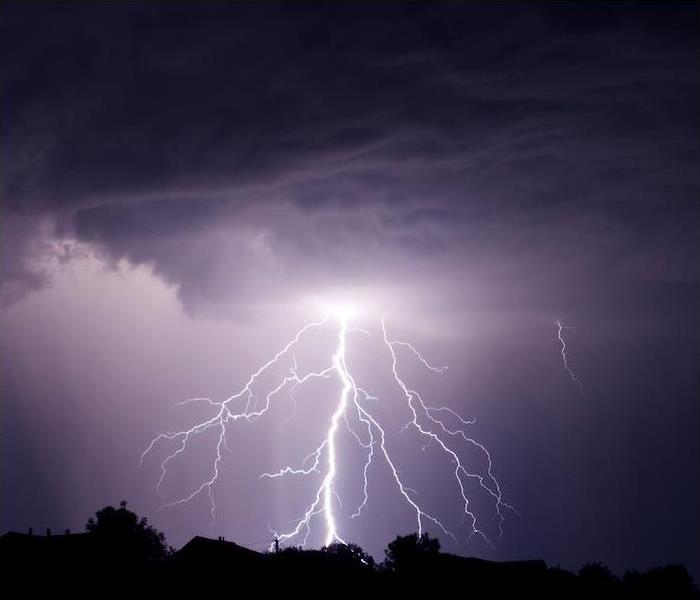 If your home or business has been impacted by a recent storm, SERVPRO of Paulding/Polk Counties is here to help you get back on your feet.
If your home or business has been impacted by a recent storm, SERVPRO of Paulding/Polk Counties is here to help you get back on your feet.
We’ve all gotten the alerts on our phones before: “The National Weather Service has issued a Thunderstorm Warning.” And then a few hours later, a modified message: “The National Weather Service has issued a Severe Thunderstorm Warning.”
What changed that made this storm be upgraded to severe? What is the difference between these two categories and how serious does it mean this storm is?
The 2 Major Differences Between a Thunderstorm and a Severe Thunderstorm
Hail Damage. A thunderstorm brings rain, thunder and lightning. But one element of a storm that is required for it to be classified as severe is hail that is at least one inch in diameter.
Many people in north Georgia know what hail damage can do to their properties (especially since the most recent storms brought significant hail and heavy rains to our area).
Hail can become as large as a grapefruit and can fall at incredibly speed, so the opportunity for it to cause damage is very high. To prepare for a storm that is going to have hail, ensure all people and pets have sturdy shelter, move your vehicle to a covered area, and repair or replace any loose shingles on your roof.
High Winds. Thunderstorms can generate strong winds that can cause damage to your property, especially if there are loose outdoor items that haven’t been secured such as lawn furniture, patio umbrellas and children’s toys. However, for the storm to be considered a severe thunderstorm, there must be a sustained straight-line wind measurement of 58 miles per hour or more.
Some storms can bring wind gusts of more than 100 miles per hour, which can cause serious damage to permanent structures. These types of winds can topple trees, flip mobile homes, rip off a roof of a home and more. The most important thing to do in a storm of this magnitude is to find shelter as soon as possible.
While some storms pass through with little to no damage, others don’t and can leave behind them a dangerous and overwhelming amount of debris. If your home or business has been impacted by a recent storm, we are here to help you get back on your feet. Call us today to see how we can help.
Flooding Can Happen Anywhere
8/30/2021 (Permalink)
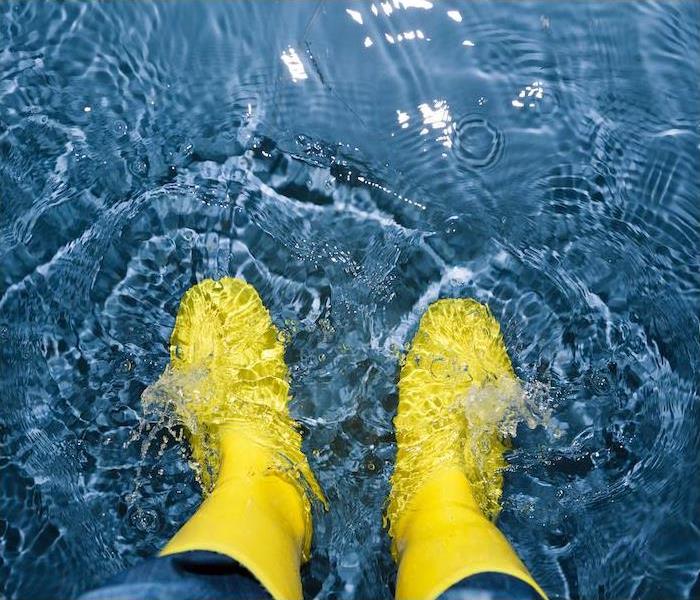 When catastrophic water damage happens to you, SERVPRO® of Paulding/Polk Counties can help.
When catastrophic water damage happens to you, SERVPRO® of Paulding/Polk Counties can help.
According to the National Weather Service (NOAA), “Approximately seventy-five percent of all Presidential disaster declarations are associated with flooding.” NOAA lists the most common flood hazards in the United States as:
• Flash Flooding
• River Flooding
• Storm Surge and Coastal Inundation from Tropical and Non-Tropical Systems
• Burn Scars/Debris Flows (Caused by Wildfires)
• Ice/Debris Jams
• Snowmelt
• Dry Wash (Caused by heavy rainfall in dry areas)
• Dam Breaks/Levee Failure
Just because you haven’t experienced a flood doesn’t mean you won’t in the future. In fact, 20% of all claims paid by the National Flood Insurance Program (NFIP) were for policies in low-risk communities. On average, floods cost $3.5 billion in annual losses in the U.S., and commercial flood claims average more than $75,000 (NFIP).
When catastrophic water damage happens to you, SERVPRO® of Paulding/Polk Counties can help. They can help you prepare ahead of time with an Emergency Ready Profile® (ERP), or respond to any size disaster to begin cleanup and restoration to get you back in business as soon as possible. SERVPRO® of Paulding/Polk Counties is ready to help make it “Like it never even happened.”
The Science of Drying
8/30/2021 (Permalink)
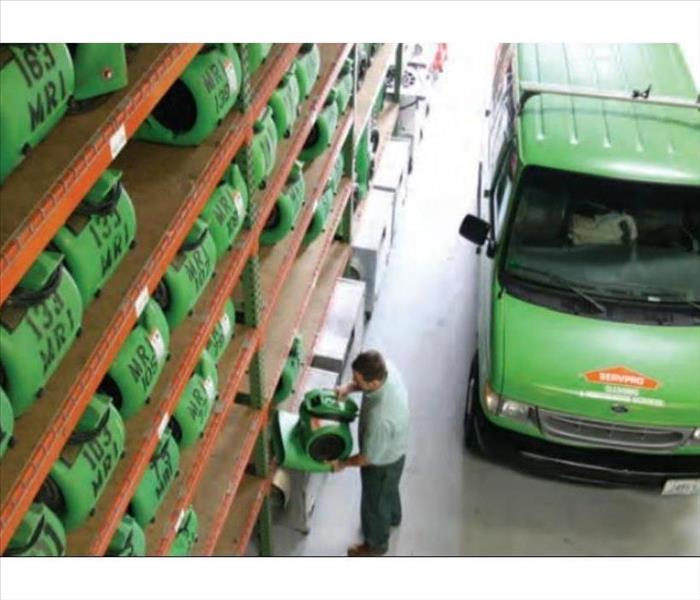 SERVPRO® of Paulding/Polk Counties has the professional training and equipment to help make water damage “Like it never even happened.”
SERVPRO® of Paulding/Polk Counties has the professional training and equipment to help make water damage “Like it never even happened.”
Did you know there is actually a science behind the process of drying? Having the knowledge of psychrometrics is essential to restoring a water damaged structure to its preloss condition. While your initial reaction may be to grab a few towels to mop up the mess and place a fan or two around the damaged area, SERVPRO® of Paulding Polk Counties Franchise Professionals are trained in the science of drying and follow strict industry-approved standards to help lower the chances of any secondary damages.
If your business suffers a water damage, SERVPRO® of Paulding/Polk Counties will:
• Inspect the building to detect every component that is wet to help prevent secondary damage from happening.
• Measure how much moisture is in wet materials and monitor whether the materials are drying properly.
• Speed up Mother Nature by using professional drying equipment. What exactly does it mean to help “speed up Mother Nature”? A wet building can often dry naturally because the environment always seeks equilibrium. When materials are wet, moisture will naturally move to drier air at the surface of the material—but only if the air is drier.
The only problem is, nature often takes too long and secondary damages may occur while the building is drying out.
SERVPRO® of Paulding/Polk Counties has the tools and equipment to help Mother Nature along, including equipment to help dry hardwood floors, tough-to-reach spaces inside walls, and much more. SERVPRO® of Paulding/Polk Counties Professionals also use state-of-the-art monitoring equipment and a proven scientific process to help speed the drying of your home or business.
It’s not only the equipment but the technology too! SERVPRO® has developed DryBook™, a proprietary tool that provides realtime documentation and updates on the drying process and helps ensure industry drying requirements are met. With DryBook™ Mobile, you have the ability to know exactly where your property is in the drying process.
The bottom line? SERVPRO® of Paulding/Polk Counties has the professional training and equipment to help make water damage “Like it never even happened.”
Deep Fryer Safety
8/25/2021 (Permalink)
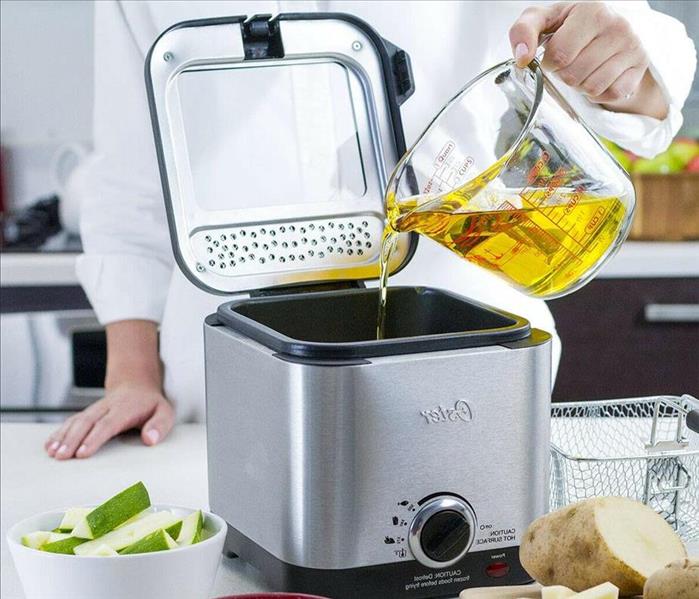 SERVPRO of Paulding/Polk Counties are your local experts to help you turn that kitchen fire damage back into a functioning kitchen.
SERVPRO of Paulding/Polk Counties are your local experts to help you turn that kitchen fire damage back into a functioning kitchen.
Here in the south, fried foods are a necessary food group. It's as essential to our way of life as sweet tea. Frying foods at home is much easier thanks to residential deep fryers. So if you find yourself hankering for some fried chicken or veggies, following these tips to ensure you don't need to call the fire department or SERVPRO of Paulding/Polk Counties.
*Know your oil smoke point. Each type of cooking oil has it's own smoke point. This is the temperature that your oil begins to smoke and could catch fire.
*Don’t overfill your deep fryer. Most deep fryers have a max fill line. What most people don't account for is that this should include the food, not just the oil. Overfilling your deep fryer could result in spilling oil and causing a fire and uneven cooking due to the oil temperature dropping.
*Do not deep fry wet food. Water can cause hot oil to splash and spill over potentially resulting in a fire. Most frozen foods are already mostly dry, but fresh foods can contain a lot of moisture and need to be patted down before putting in hot oil.
*Keep your deep fryer in clear surroundings. Many deep fryers aren't cool to the touch when cooking. Make sure the are around your deep fryer is free from flammable and combustible materials.
*Make sure your deep fryer has a break-away cord. This is a standard safety feature on most home deep fryers to keep the fryer from tipping over if the cord is tripped up by something or someone. However, not all have this so inspect yours and use accordingly.
*Have a lid on hand. While not necessary, smothering is the safest way to put out a grease fire. If your deep fryer doesn't come with a lid, find something you can use that will work just as well.
*Keep a fire extinguisher handy. There are many people who've never thought to have a fire extinguisher in their kitchen in case of a fire. There are many options available for a fire extinguisher made for home use, so make sure you have one to on hand in your kitchen.
*Keep track of your temperatures. Many deep fryers have a built in temperature gauge to track how hot your oil is and make sure your fryer is cooking at the proper heat. These can malfunction so having a separate clip-on thermometer as a back up is a great idea.
*Dispose of oil properly. Always let the oil cool down completely before storing or disposing of it. If storing, make sure to filter out all food particles so your oil doesn't spoil prematurely. If disposing, make sure to pour into a air tight container. Never pour oil down a drain as it can cause the drain to clog and back up.
*Use proper protective equipment. Most foods won't splatter as long as excess moisture is removed, but fatty foods like bacon will splatter regardless. Using the handle on the fryer basket will protect you, but having protective gloves as secondary protection is always a good idea.
Should you find yourself faced with a kitchen fire, trust the experts at SERVPRO of Paulding/Polk Counties to help you make it "Like it never even happened."
*Source: Deep Fryer Safety Tips
Earthquake Safety Tips
8/25/2021 (Permalink)
 Follow these safety tips to stay safe before, during, and after an earthquake.
Follow these safety tips to stay safe before, during, and after an earthquake.
Before an Earthquake
- Develop a family communications plan.
- Make a Ready kit for at least three days of self-sufficiency.
- Secure cabinets, bookcases and mirrors to wall studs. Avoid installing bookcases next to beds, since heavily loaded structures could fall causing significant injury or death.
- Do NOT hang pictures over the bed.
- Strap any gas or electric water heater to wall studs. A broken gas line can cause a fire, while a knocked over or ruptured tank could cause damage or scalding.
- Store hazardous or flammable materials safely. If a container of flammable liquid spills during an earthquake, any source of flame may ignite the fluid and start a fire.
- Loss of contact with the foundation is a major source of damage in many large earthquakes. Bolt house to foundation, if possible. Houses in the Southeast are built to stand upright and may not withstand shaking.
- Consider having chimneys, roofs, and walls checked for stability. Bricks from chimneys and wall facings if not secured can fall and cause significant damage or injury.
- Keep insurance policies up-to-date and stored safely. Determine if earthquake insurance is right for you.
During an Earthquake - Drop, Cover, Hold On
- Drop to the ground fast, otherwise the earthquake shaking may knock you down uncontrollably.
- Cover yourself below a strong table or desk. Falling objects and collapsing structures cause many of the injuries and deaths during an earthquake. In addition, cover your head and face to protect them from broken glass and falling objects.
- Hold onto a table or desk and be prepared to move with it. Hold your position until the shaking stops.
- Do NOT run outside or use the stairways or elevators during the shaking. The entrance ways of buildings and homes are particularly dangerous because of falling bricks and debris.
After an Earthquake
- When tremors STOP, vacate premises immediately until it is safe to return.
- Look for and eliminate fire hazards that can cause further damage.
- Follow your communications plan to locate and connect with family and loved ones.
- Check your building for cracks and structural damage.
- Take photos to record damage before you clean up or make repairs.
- Move valuables to a safe, weatherproof location.
- Review your insurance coverage and report claims promptly.
- Collect inventory records, appraisals and photographic records.
- Use licensed professionals to conduct inspections and repair your home.
- Look for ways to better prepare your home for earthquakes as you repair or rebuild.
Do you know the different types of smoke damage?
7/26/2021 (Permalink)
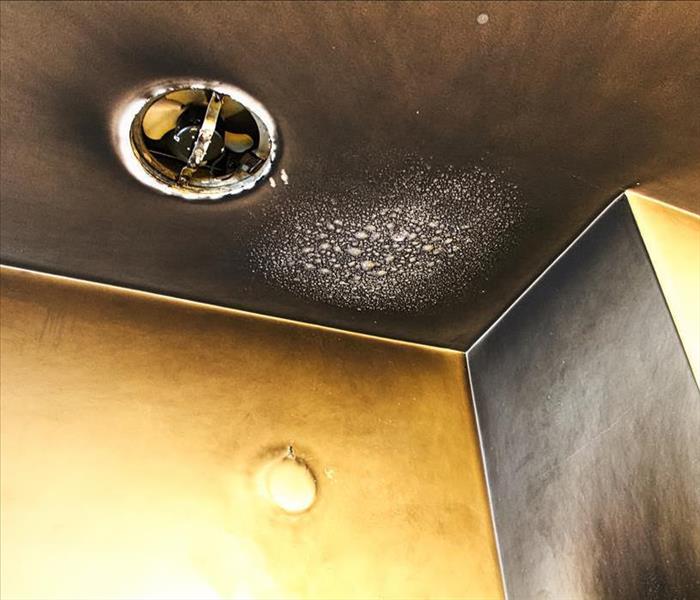 If you are in need of restoration due to fire and smoke damage, you can count on SERVPRO of Paulding/Polk Counties.
If you are in need of restoration due to fire and smoke damage, you can count on SERVPRO of Paulding/Polk Counties.
Every house fire is unique and causes specific types of damage based on what the initial source was, how long it burned and what was consumed by the flames. One of the ways that fire damage can manifest itself is via smoke residue left behind throughout the house.
The severity of smoke damage depends on several factors, but identifying it quickly and calling in your restoration team to have it handled is always recommended.
The Types of Smoke Damage That May be Present After a Fire
Wet Smoke Damage. Damage from wet smoke is generally a result of fires that burn at a lower temperature. These fires do not have as many flames but will produce an excess of smoke that can thickly coat the surfaces of your home. It can often feel sticky and wet to the touch, hence the name. Because of how it adheres to surfaces and saturates the air with a strong odor, wet smoke is one of the most difficult types to eradicate from a home.
Dry Smoke Damage. A hot, high-temperature fire such as one from a flammable liquid or a large number of open flames will produce a more dry smoke. This will result in smoke residue that is dry and powdery, which can settle into minuscule crevices and impact areas relatively far away from where the flames broke out in the home.
Protein Smoke. Associated with foods or other flammable organic materials catching fire, protein smoke is a unique type that results in a buildup of soot. Soot is quite dangerous, and this type of soot is generally difficult to see because it will be light in color. The residue it leaves behind is typically easy to feel, however, and it will likely cause a lingering odor as well.
Petroleum Smoke. Any time an oil-based material is burned, it will let off petroleum smoke. It produces an extreme odor and is generally quite dark in color, which can permanently discolor upholstery or wood if left untreated.
If you are in need of restoration due to fire and smoke damage, you can count on us. Call us today (770) 505-0555 to learn more.
Severe Weather Damage
7/26/2021 (Permalink)
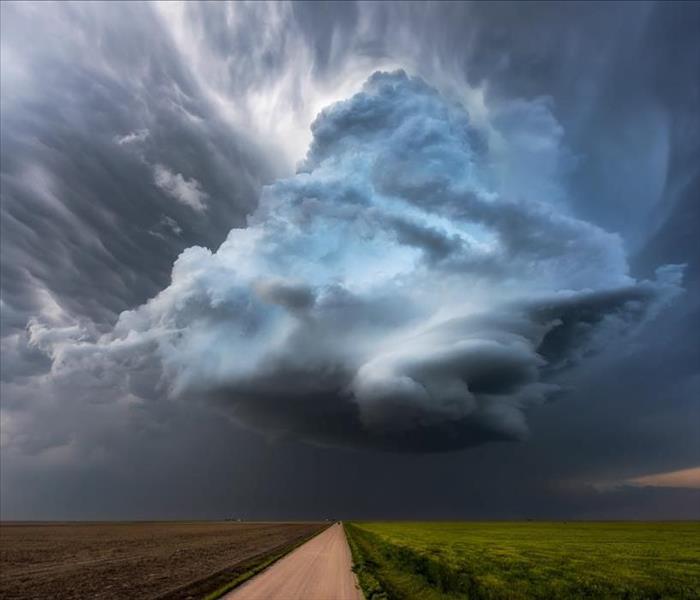 If your property has experienced damage from a storm, call the experts at SERVPRO of Paulding/Polk Counties.
If your property has experienced damage from a storm, call the experts at SERVPRO of Paulding/Polk Counties.
Property damage caused by severe weather can be devastating to your family or business, and repairing it can be a complex undertaking. To get storm damage repair completed quickly and safely, you need a restoration service company that specializes in bringing your home back to its preloss condition. SERVPRO® of Paulding/Polk Counties is your one stop for restoration & repairs.
Homes are built to protect you, your family, and themselves from harm caused by the elements, but every time your home weathers a bad storm certain fixes will need to be made.
Hail, Ice, and Snow
Winter storms are dangerous for a number of reasons, not least of which is power outages that can cause the house to stop using any electric-powered heating. Hail, for instance, is made up of heavy balls and chunks of ice formed in the upper atmosphere and blown by the wind. When they fall on your house, they sometimes do so with force great enough to crack roof shingles and break windows.
Snow, soft and harmless as it may seem, becomes incredibly heavy when stacked and can potentially cause structural damage with its own weight. Even the cold itself can freeze and burst your pipes.
Tornado and Winds
Tornadoes are made of wind but the damage they can do is astounding. These twisters are incredibly variable, sometimes highly visible and destructive and other times barely existent as more than a swirl of wind. However, if a tornado hits your home you may have a lot of repairs and cleaning up to do afterward.
Because of the way tornadoes forms, they are often accompanied by flying chunks of hail along with both light and heavy debris they pick up. With or without flying projectiles, tornadoes can rip off roof shingles, shatter windows, and drop large tree branches, or even whole trees, onto your home.
Hurricanes, Tropical, and Thunderstorms
Your house was built to resist normal amounts of rain and moisture, but any storm that involves an unusually large quantity of rain can put a home at risk. Heavy rains can damage not only your roof but also your foundation and any belongings left outside or in a water-exposed area. Clogged or destructed gutters can fill up and break off or fail to protect less water-resistant parts of the house while high winds and flooding can potentially damage your utilities.
Hurricanes, tropical storms, and thunder are similar in that all three can involve high winds and intense rain, so after withstanding any of these your home should be checked thoroughly for both wind and water harm.
If your property has experienced damage from a storm, call the experts at SERVPRO of Paulding/Polk Counties. We work with a variety of home insurers and can help you determine whether your damage is covered. We can also help with filing paperwork to keep your costs down. Don’t let a storm damage your property value!
5 Things You Need to Know About Water Damage
7/26/2021 (Permalink)
When water damage strikes, let SERVPRO® of Paulding/Polk Counties set your mind at ease. When you call SERVPRO you can expect a timely response. It's important to get a fast start on your water problems. Depending on the water type, the damage can be much existent than just what appears on the surface.
Here are five things that every homeowner needs to know about water damage.
- There are different insurance policies for flood damage and water damage.
You might think that water is water, whether it’s from flooding or a burst pipe, but flood damage is not covered under homeowner’s insurance. If you live in an area likely to experience flooding, you will probably already have a separate policy through the National Flood Insurance Policy (NFIP). When you report the claim to the insurance company, make sure to specify whether the claim is for water damage or for flood damage, so they can begin adjusting your claim correctly.
- Not all water damage is covered by your insurance.
It is a good idea to look over your insurance policy and familiarize yourself with any exclusion to your water damage coverage. For instance, most policies cover sudden damage, like water damage from a really bad storm or from an overflowing washing machine. On the other hand, any water damage that happens because you didn’t maintain the property may be excluded, as well as gradual leaks that caused water damage over time.
- Once water damage has happened, the clock is ticking before it gets worse.
When your property has been water damaged, you don’t have the luxury of waiting around for a convenient time to start the cleanup. Secondary damage from mold growth can present serious health effects associated with mold in the living environment.
Mold spores are everywhere, but they need moisture and a nutrient source to grow. And that is exactly what your wet carpet or drywall offers.
There is a 24 to 48 hour window from the time something gets wet until mold can begin to grow. After that time, mold will multiply rapidly. When mold growth is widespread, you may need the services of a professional mold remediation service to safely treat and remove the mold.
To prevent mold growth, you will need to get your property completely dry again within that 48-hour window. To do this, you’ll need to contact a company that specializes in water damage restoration and emergency water extraction. They will have the professional water removal equipment and drying equipment to get the job done as quickly as possible. Many have 24-hour a day emergency hotlines, so you can start recovering your property almost immediately.
- Your insurance company needs to know right away.
It’s a good idea to call your insurance company right away when you discover water damage. Your insurance agent can start the claims process immediately, as well as guide you through the first steps you will need to take to protect your property from more damage, like stopping the source of the water at the main water turnoff.
Your insurance company may also direct you to a water damage restoration company that they have worked with in the past. Keep in mind that you do not have to call the company that they recommend. You may choose any reputable restoration specialist to restore your property for the insurance claim.
- The pollution level of the water is important.
Water damage is categorized as one of three levels by how polluted the water source was that caused the damage.
Category 1: Water from a clean water source, like a fresh water line for a dishwasher. This water will not cause illness or any ill effects.
Category 2: Water that may cause illness through contact. It may have bacteria in it.
Category 3: Water that is highly contaminated. Contact can cause severe illness or death. Think sewage backup, an overflowing toilet, or storm waters.
Even though water may start out as Category 1, that doesn’t mean it will stay that way. Any contamination that the water touches, such as dirty carpeting or soil from the ground, can change water damage Category to 2 or even Category 3. And since standing breeds bacteria, the longer the water is around, the worse the contamination of your property.
More contamination can mean that SERVPRO of Paulding/Polk Counties will have to use more aggressive measures to clean your structure and property, and it might mean that soft furnishings, like your carpet and the carpet pad, may have to be discarded for your safety.
Tips for Preparing Your Business for an Emergency Situation
7/26/2021 (Permalink)
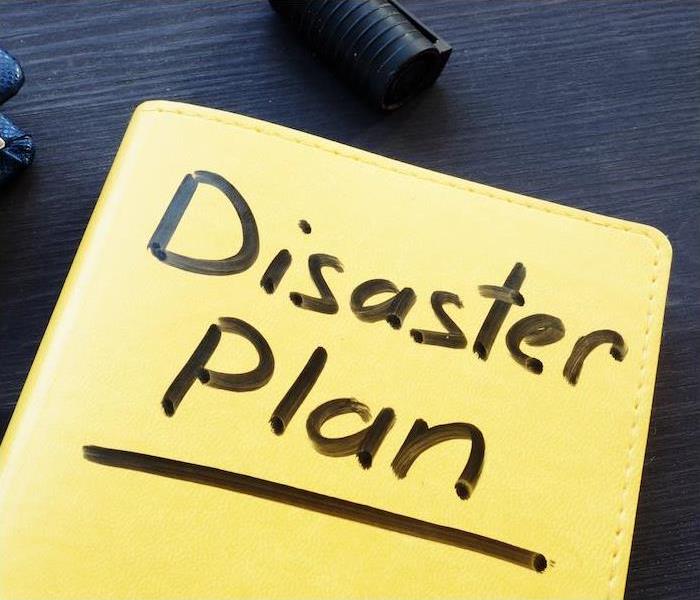 If your business is damaged due to a disaster or an emergency, SERVPRO of Paulding/Polk Counties is here for you.
If your business is damaged due to a disaster or an emergency, SERVPRO of Paulding/Polk Counties is here for you.
If you own your own business, you understand the importance of planning ahead to set yourself up for success—but have you considered the need to plan ahead for an emergency scenario? The frequency with which disasters occur continues to rise, and being prepared for any scenario is the best defense business owners have against them.
Understanding how to prepare your business can help you recover far more quickly after an emergency and get your doors reopened faster after a disaster.
How to Prepare Your Business for an Emergency
Review the details of your insurance policy. The average commercial insurance policy provides many standard coverages, but it also leaves quite a bit of scenarios out, requiring business owners to purchase additional coverage for situations such as floods, income interruption and gaps in your policy. It is smart to review your insurance policy through the lens of disaster preparedness planning to learn about any gaps in coverage you may have.
Make sure your documents are backed up and stored well. Having the right documentation on hand after a disaster will make the recovery process much easier, but have you considered the correct way to store them? Many files are digital now, so you should make sure you have a cloud backup or hard copy in case your computer gets damaged in a disaster. If you have physical documents you may need, make copies of those and store them securely in a secondary location.
Be sure you have an evacuation plan. If a flood or other natural disaster is incoming, officials will normally recommend a rapid evacuation so that everyone can get to safety. Be sure you have an evacuation plan that includes well-marked evacuation routes and a headcount system to make sure everyone is accounted for, and make certain that you have rehearsed often with staff. This serves to reduce panic in the moment as well as your overall liability, and equips everyone to move to safety calmly and quickly in an emergency.
If your business is damaged due to a disaster or an emergency, we are here for you. You can contact us any time to learn more about commercial restoration and how we can help.
What to Consider When Packing an Office Emergency Kit
7/26/2021 (Permalink)
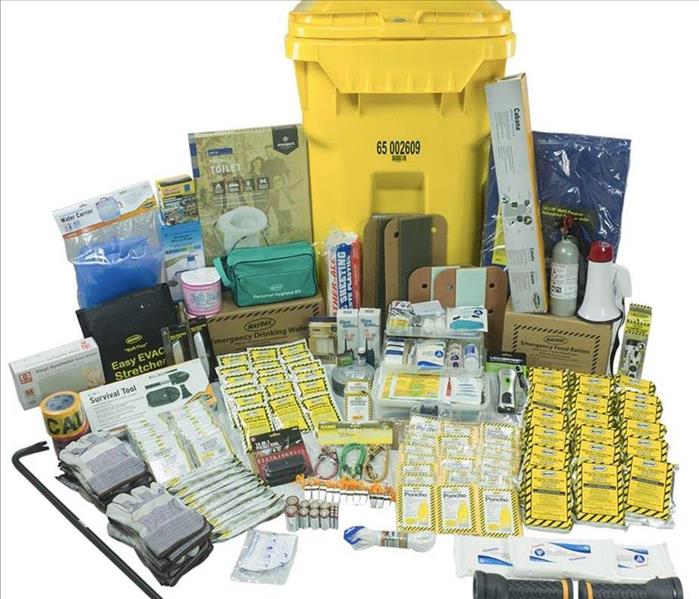 Make sure you have enough supplies in your office emergency kit for every employee.
Make sure you have enough supplies in your office emergency kit for every employee.
If you own a business, the safety of your staff is likely one of your top concerns throughout the average workday, but have you considered how to preserve that safety in the event of an emergency? While many situations will call for a quick evacuation, your workplace may have to go in a lockdown scenario to deal with certain disasters, so having an office emergency kit is something that officials certainly advise.
Understanding the purpose behind an emergency kit and what to pack will help you make the best decisions regarding specifically what your office may need. While there are some basics that are wise to always include, there are also plenty of extras that might prepare everyone for wider swath of scenarios that are possible.
What Is An Office Emergency Kit For?
To put it simply, an office emergency kit is for a situation where you and your staff might be stranded in the office after an emergency or disaster. While evacuation is often recommended in these unprecedented situations, there may be certain instances where you will need to stay put until help arrives instead. The emergency kit allows for everyone to have access to necessities, medical supplies, food and water to stay safe and comfortable until help arrives.
What Should the Office Emergency Kit Include?
Emergency kits are something you can keep basic or build out for every possible scenario, and how you approach this is entirely up to you. For a simple emergency kit, include the necessities:
- Non-perishable food, such as granola or protein bars
- Enough water to cover one gallon, per person, per day
- First-aid kits, aspirin and any other medical goods
- Flashlights and excess batteries
- An NOAA Weather Radio
In addition to the very basic items, you may also want to include extras to account for even more situations and keep everyone comfortable for as long as possible. This would include items such as multi-tools/Swiss Army knives, surgical masks, duct tape, toilet paper, hand sanitizer, gloves (both latex and work types), emergency blankets, hand warmers and whistles.
If your office is damaged due to a disaster or emergency, we are here to help. Contact us today to learn more about our restoration process.
After the Fire: What to Do to Help Your Business Recover
7/26/2021 (Permalink)
 SERVPRO of Paulding/Polk Counties is your local expert to help make sure your business reopens following a fire.
SERVPRO of Paulding/Polk Counties is your local expert to help make sure your business reopens following a fire.
Although many of us go through great efforts to fireproof our home, we rarely bring this outlook into the workplace. While there’s no replacement for a little bit of forethought and diligence, a fire at your place of business doesn’t have to mean the end of your company altogether. In fact, approximately 60 percent of all U.S.-based businesses reopen their doors after a disastrous fire. Some companies have even gone on to achieve a great amount of success and profitability after such an event. Here are some tips to make sure yours is one of them.
Determine the Responsible Party
The first thing you should do in the wake of a fire at your business is determine the responsible party. This depends on a number of different factors, including whether you lease or own the building, the exact cause of the fire and even your specific amount of insurance coverage. Keep in mind that some insurance policies only cover the contents of the structure and not the materials used in the actual construction of the building.
Sometimes, you may need to wait until an investigation has been completed by your local fire department, police department or insurance company. If this is the case, make sure to maintain communications for further information and instructions.
Safeguard and Secure Your Remaining Property
If the fire has caused significant damage to the exterior walls, doors, windows or roof of your building, you’ll want to act quickly in order to safeguard and secure your remaining property. Smoldering remains should be fully extinguished and any large holes should be temporarily patched. Not only will this prevent vandalism after the fact, but a little bit of effort can go a long way towards minimizing the overall amount of damage caused.
Contact Anyone Who May Be Affected
Next comes the daunting task of contacting anyone who may have been affected as a result of the fire. This includes employees, board members, external partners and, in some cases, customers. If any activities or services need to be postponed or suspended, make sure to communicate that news, too. The last thing you want to do after a fire is to leave your valuable employees and business partners in the dark about the future of your company.
Furthermore, don’t forget to contact your insurance agent as soon as possible. A simple call or email will typically suffice, though large claims may require face-to-face consultation or even an on-site inspection of the damaged property.
Get Your Documentation in Order
Your insurance company will require proof regarding any claimed losses as a result of the fire, so be sure to have any pertinent documentation, including receipts, user manuals and credit card statements, at the ready. You may even want to take digital pictures or video of your property. Not only can this be used in determining your overall losses, it could serve as hard evidence in case any court proceedings should follow.
Repair and Restore Damage
If the structure isn’t a total loss, you might be able to rebuild, repair and restore your business back to its original state. Extensive smoke damage, for example, can typically be cleaned up through a number of different tools so you can go on with business as usual after the restoration.
Initiate the Recovery of Sensitive or Critical Data
Depending on your exact case, you may need to take steps to recover any sensitive or critical data that was lost in the occurrence. Damaged servers, hard drives and even personal computers can all hold data critical to the day-to-day operations of your business.
If the situation warrants, you may even consider hiring a third-party that specializes in data recovery and restoration, specifically in the event of fire. Such individuals are more likely to be equipped with the right hardware and software tools than a company that offers general disaster recovery services. Most data recovery experts will also be able to work with you in order to introduce techniques in disaster recovery planning and data loss prevention.
Getting Back to Business
Once everything has been restored to order, it’s finally time to get back to business. Make sure to outline a comprehensive fire safety plan when moving forward, just in case your business experiences another fire. You might also consider increasing your insurance coverage for the future. After all, it is better to be safe than sorry.
How Team Building Helps Improve the Bottom Line
7/26/2021 (Permalink)
 Successful teams must work together wholeheartedly, not just apply the principles of effective task processes.
Successful teams must work together wholeheartedly, not just apply the principles of effective task processes.
Teams are at the very foundation of organizational effectiveness. They work best with mutual trust and a common commitment to goals. Teams are more effective than individuals because they have more talent and experience, more diversity of resources, and greater operating flexibility. Research throughout the last decade has shown the superiority of group decision-making over that of even the brightest individual in the group. The exception to the rule is when the group lacks harmony or the ability to cooperate. Then decision-making quality and speed suffer.
Successful teams must work together wholeheartedly, not just apply the principles of effective task processes. Vanessa Urch Druskat and Steven B. Wolff (Harvard Business Review, March 2001) identified three conditions essential to a group’s effectiveness. They are: trust among members, a sense of group identity and a sense of group efficacy. Group identity is the feeling among members that they belong to a unique and worthwhile group. Group efficacy is the belief that the team can perform well and that group members are more effective working together than apart.
20 to 30 percent of business performance depends on people feeling good about working at a company, according to Goleman in Primal Leadership (2002). The link between climate and business performance has been reaffirmed by new research that spans a range of industries. For every 1 percent improvement in the service climate, there’s a 2 percent increase in revenue. Workers who feel upbeat will go the extra mile to please customers, both internal and external, and therefore improve the bottom line.
Atlanta Challenge’s experiential team building and corporate training workshops can give your company the following benefits:
- Boost employee morale
- Improve communications skills
- Develop conflict resolution skills
- Have fun together
- Enhance creative problem solving
- Help teams work together more effectively
- Develop management’s leadership skills
- Increase team efficiency
- Help employees get to know one another better
- Get your group motivated and energized towards company goals.
- Improve customer service through better understanding of customers.
- Improve sales by understanding how to communicate with customers.
Should Your Employees Be Certified in First Aid and CPR?
7/21/2021 (Permalink)
No one wants to imagine a medical emergency in the workplace, but, unfortunately, they do happen. Being prepared means more than having an office first-aid kit on hand — it means having designated employees who are trained to respond to a variety of emergency situations.
Training employees on what to do in an emergency can mean all the difference if the worst happens. Even short of such crises, emergency-response training comes with other advantages, from increased employee engagement to compliance with Occupational Health and Safety Administration (OSHA) requirements.
Providing first-aid training and the opportunity to become certified in CPR are ways of engaging your employees and showing that you take their health and well-being seriously.
While that display of dedication may be able to improve employee satisfaction with your organization, it can also help build camaraderie and morale.
It’s also a skill your employees can take with them, whether home to their families or into their communities.
Understanding the Classes of Fire Damage
7/21/2021 (Permalink)
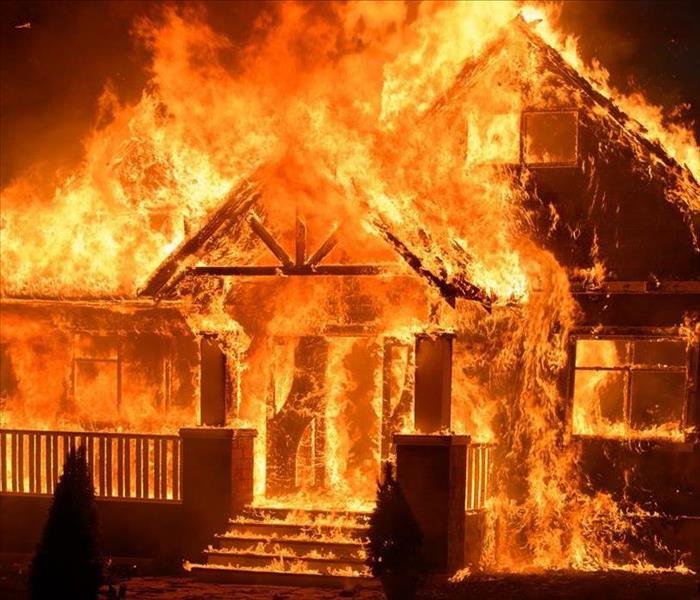 If you have had fire damage to your home, SERVPRO of Paulding/Polk Counties can help out.
If you have had fire damage to your home, SERVPRO of Paulding/Polk Counties can help out.
If you have experienced a fire in your home, you are likely navigating through the complicated aftermath of assessing the damage, filing an insurance claim and obtaining trusted home restoration to take care of the damages.
Throughout this process, firefighters, insurance agents and restoration teams will want to discuss the damage with you, so it is important to understand exactly what they mean.
Professionals use a series of classes to evaluate fire damage in order to create an organized system. The classes of fire damage have to do with the fire’s origins, as many times, this will indicate the type of damage that is caused. The start of the fire and the combustible materials involved have a large bearing on the extent and severity of the damage, so here is a guide to common terms you may come across.
The 6 Classes of Fire Damage
Class A: Class A fire damage is a result of a fire that occurs when flammable, solid materials are ignited, such as wood, cloth, paper and plastic.
Class B: When a fire starts due to liquids that are ignited—or in some cases, flammable solids that turn to liquids—it is considered Class B damage. This is the class designated for fires related to gasoline and other flammable chemicals that might be the source of the flames.
Class C: Any flammable gas, such as propane, butane and any others, will lead to Class C fire damage.
Class D: There are combustible metals that can cause fires, and if they do, they will cause Class D fire damage. Magnesium, potassium and sodium are all examples of combustible metals that can cause fires.
Class E: Class E is actually quite similar to Class A and B, but has to involve an electrical component as well. It will still require a fire due to flammable solids or liquids, but these items will be ignited by an electrical spark to be considered Class E.
Class F: This type of fire damage is similar to Class B because it involves ignition from cooking oils and fats, but these often burn much hotter and cause much more severe damage than a Class B fire.
If you have had fire damage to your home, we can help out. Contact us at any hour (770) 505-0555 to learn more about our fire restoration process and get a quick response to your home or business




 24/7 Emergency Service
24/7 Emergency Service











































































